
Admin
-
Posts
7,477 -
Joined
-
Last visited
Content Type
Profiles
Forums
Events
Store
Gallery
Community Map
Posts posted by Admin
-
-
Guzzi's middleweight adventure bike range expands to three variants.
-

Moto Guzzi has announced details on the 2024 Moto Guzzi Stelvio’s radar system. (Moto Guzzi/)Moto Guzzi was expected to officially unveil the new Stelvio adventure-touring model powered by the 1,042cc liquid-cooled DOHC that debuted on the Mandello GT model marking the beginning of the second 100 years of Moto Guzzi at EICMA 2023. However, Cycle World Executive Editor Justin Dawes got the opportunity to have first contact with the Stelvio and ride it long enough to come to the conclusion that the Stelvio might be the best Moto Guzzi model ever.

Front-facing radar on the 2024 Moto Guzzi Stelvio allows for Follow Cruise Control and Forward Collision Warning functions. The Stelvio can be had with or without the PFF Rider Assistance Solution system. (Moto Guzzi/)His ample and detailed story was posted October 25, 2023, and there is not much which can be added at this stage, except that, as Dawes had anticipated, the production version now is confirmed to feature Moto Guzzi’s PFF Rider Assistance Solution—a front-and-rear-facing radar system providing active cruise control and a blind spot warning system. The radar warning system was developed by Piaggio’s Fast Forward branch in Boston.

Moto Guzzi’s Blind Spot Information System and Lane Change Assist functions use rear-facing radar on the Stelvio. (Moto Guzzi/)The PFF System has Following Cruise Control (FCC), Forward Collision Warning (FCW), Blind Spot Information System (BLIS), and Lane Change Assist (LCA). FCC uses the front-facing radar to monitor vehicles ahead and adapt the speed of the Stelvio automatically using engine-brake control to slow and the ride-by-wire throttle to speed up. Also the front radar informs the FCW of potential collisions. BLIS and LCA use the rear sensors to warn of vehicles in the blind spots as well as those approaching too quickly for a safe lane change.
Moto Guzzi says the Stelvio can be had with or without PFF Rider Assistance Solution. Pricing is still yet to be announced.
2024 Moto Guzzi V85 TT Details
The new Stelvio would have been enough for EICMA 2023, but it’s not the only news out of Mandello del Lario. The old-faithful air-oil cooled 853cc 90-degree V-twin still gathers the lion’s share of sales for Guzzi. Multiple varieties of V7 and V9 models keep selling well, always bringing Moto Guzzi back to a positive level of profitability. One other small block Moto Guzzi that has done well on the sales floor is the V85 TT, a light adventure model that has proved smartly capable and a lot of fun for the price.

Moto Guzzi’s V85 TT in Rosso Fuji paint. (Moto Guzzi/)Now, the V85 TT has surprised EICMA 2023 with a number of refinements and, most importantly, with an expanded model line that includes a runabout version named Strada and a fully equipped TT Travel version.
They all share the same 84 x 77mm bore and stroke engine that has been positively upgraded to Euro 5+ emissions standard and in the process gains 4 hp, now a claimed 80 at 7,750 rpm. Maybe more important is the increase of peak torque to 61.2 lb.-ft. at 5,100 rpm—90 percent of which is available from 3,000 rpm for a very fat curve that grants great flexibility and very solid throttle response. These are all very positive torque and power numbers for an air/oil-cooled two-valver.
The chassis is based on a steel tubing frame structure spanning a substantial 60.2-inch wheelbase and a front end geometry featuring 28-degree steering rake and 5-inch trail. Suspension is a 41mm front fork and a massive aluminum rear swingarm with a single shock absorber cantilevered on the right side. Travel is 6.7 inches (170mm) both front and rear. The V85 family rolls on 19-inch front and 17-inch rear wheels shod with 110/80-19 and 150/70-17 tubeless tires, with cross spoke rims for the standard and Touring, cast wheels for the Strada. Front brakes are by Brembo with twin 320mm rotors and four-piston calipers controlled by a cornering ABS system.

Moto Guzzi’s Strada variant of the V85 TT has cast aluminum wheels. (Moto Guzzi/)A small fairing is supported by a pair of casted aluminum triangulated arms that also brace the 5-inch TFT instrumentation system which acts as the centralized control unit of the infotainment system. The electronics suit is based on a six-axis inertial platform that pilots the traction and cruise control function. The digitally controlled throttle system offers three riding modes, Road, Sport, and Rain, plus Off Road for the V85 TT and V85 TT Travel.

The 2024 Moto Guzzi V85 TT Travel comes with 37- and 27.5-liter side bags. (Moto Guzzi/)V85 TT Travel comes complete with two side bags (37 liters and 27.5 liters), heated grips, and a Touring windscreen on request. The V85 TT and TT Travel graphics are rather aggressive, while the V86 Strada is very sober and extracts the best from the clean body design.
Price, just like the Stelvio, is TBA.
2024 Moto Guzzi Stelvio Specs
MSRP: TBA Engine: DOHC, liquid-cooled, 90-degree transverse V-twin; 4 valves/cyl. Displacement: 1,042cc Bore x Stroke: 69.0 x 72.0mm Compression Ratio: 12.6:1 Transmission/Final Drive: 6-speed/shaft Claimed Horsepower: 115 hp @ 8,700 rpm Claimed Torque: 77.4 lb.-ft. @ 6,750 rpm Fuel System: Electronic fuel injection w/ ride-by-wire Clutch: Wet; hydraulically actuated Frame: Tubular steel trellis Front Suspension: Sachs 46mm USD fork, rebound and preload adjustable; 6.7 in. travel Rear Suspension: Kayaba monoshock, rebound and preload adjustable; 6.7 in. travel Front Brake: Dual Brembo 4-piston calipers, 320mm floating discs w/ ABS Rear Brake: Brembo 2-piston caliper, 280mm disc w/ ABS Wheels, Front/Rear: Spoked tubeless; 19 x 3.00 in./17 x 4.50 in. Tires, Front/Rear: Michelin Anakee Adventure; 120/70R-19 / 170/60R-17 Rake/Trail: 25.6º/4.6 in. Wheelbase: 59.8 in. Seat Height: 32.7 in. Fuel Capacity: 5.5 gal. Claimed Wet Weight: 542 lb. Contact: motoguzzi.com 2024 Moto V85 TT Specs
MSRP: TBA Engine: Air-cooled, 90-degree V-twin; 2 valves/cyl. Displacement: 853cc Bore x Stroke: 84.0 x 77.0mm Compression Ratio: 10.5:1 Transmission/Final Drive: 6-speed/shaft Claimed Horsepower: 80 hp @ 7,750 rpm Claimed Torque: 61.2 lb.-ft. @ 5,100 rpm Fuel System: Electronic fuel injection w/ ride-by-wire Clutch: Dry, single plate Frame: Tubular steel trellis Front Suspension: 41mm hydraulic telescopic USD fork, spring preload and hydraulic rebound adjustable; 6.7 in. (170mm) travel Rear Suspension: Double-sided swingarm in box-type aluminum w/ single shock, spring preload and hydraulic rebound adjustable; 6.7 in. (170mm) travel Front Brake: Brembo radial-mounted opposed 4-piston calipers, dual 320mm discs w/ ABS Rear Brake: Floating 2-piston caliper, 260mm disc Wheels, Front/Rear: Spoked tubeless/cast aluminum (Strada); 19 x 3.00 in./17 x 4.50 in. Tires, Front/Rear: 120/70R-19 / 170/60R-17 Rake/Trail: 28.0º/5.0 in. Wheelbase: 60.2 in. Seat Height: 32.7 in. Fuel Capacity: 6.1 gal Claimed Wet Weight: 461 lb. / 498 lb. (Strada) / 536 lb. (Travel) -
Bridging the gap from sport touring to adventure touring, Hamamatsu style.
-
 1
1
-
-
Unveiled in all its glory at EICMA 2023, the 2024 Himalayan 452 is an all-new machine from the ground up.
-
The Chinese manufacturer unveiled the production-ready model at EICMA 2023.
-
Team Blue adds another option to its available T7 range.
-
From dealer to dirt. This bone-stock Honda Transalp 750 spends some of its first miles in the dirt without protection parts.
-
Last year, it added suspension adjustability to the lineup, so this year it gets some new graphics.
-
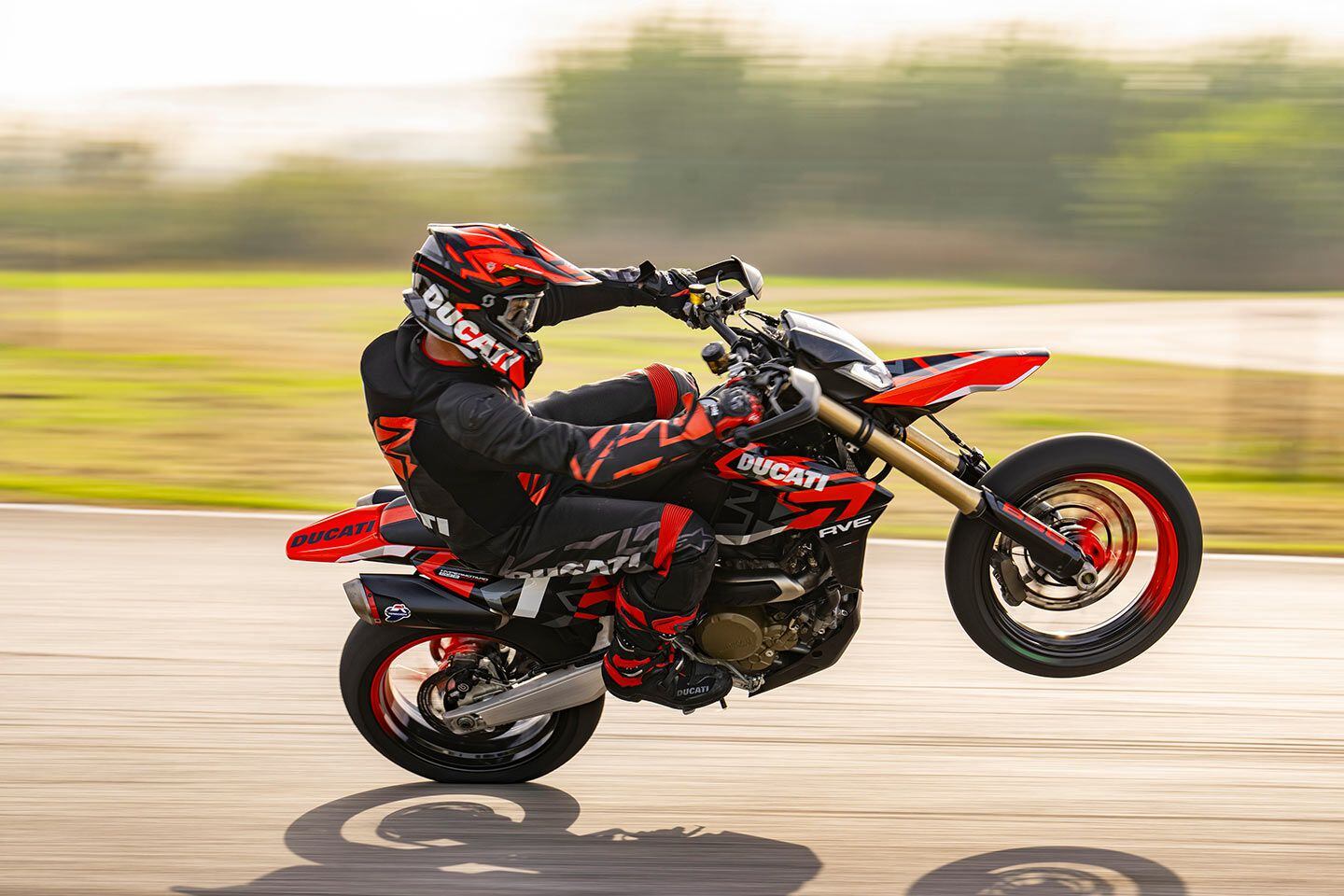
Ducati’s Hypermotard 698 Mono promises high-performance supermotard action with 77 hp from its Superquadro Mono single-cylinder engine. (Ducati/)In a time when mid-displacement bikes are conquering an ever larger market share, Ducati has brought in the light cavalry and stormed the barn with the most advanced, sophisticated, and extreme single-cylinder engine ever. Ducati has been away from single-cylinder power units for way too long, after having built its reputation on a generation of great-looking and very powerful SOHC desmo singles that still represent great pieces of technical design—courtesy of Dr. Fabio Taglioni. To stand up to its supreme performance image, Ducati did the most logical of all technical moves: It took the magnificent 1299 Panigale V2 and chopped the front cylinder off, to get an unequaled 659cc single that delivers 77.5 hp at a mind-bending 9,750 rpm.
A single like that can compete with all the present middleweight twins, it is more compact, lighter, and incredibly emotional. There is the ultimate spirit of Ducati: Lead the way in every segment it decides to compete. The great Kevin Cameron already offered a super analysis of all the technical aspects that make up the new Ducati 659cc single. A new 77.5 hp Ducati single can do anything, including resurrecting the immortal Scrambler to make it the most attractive bike today, as it was then.
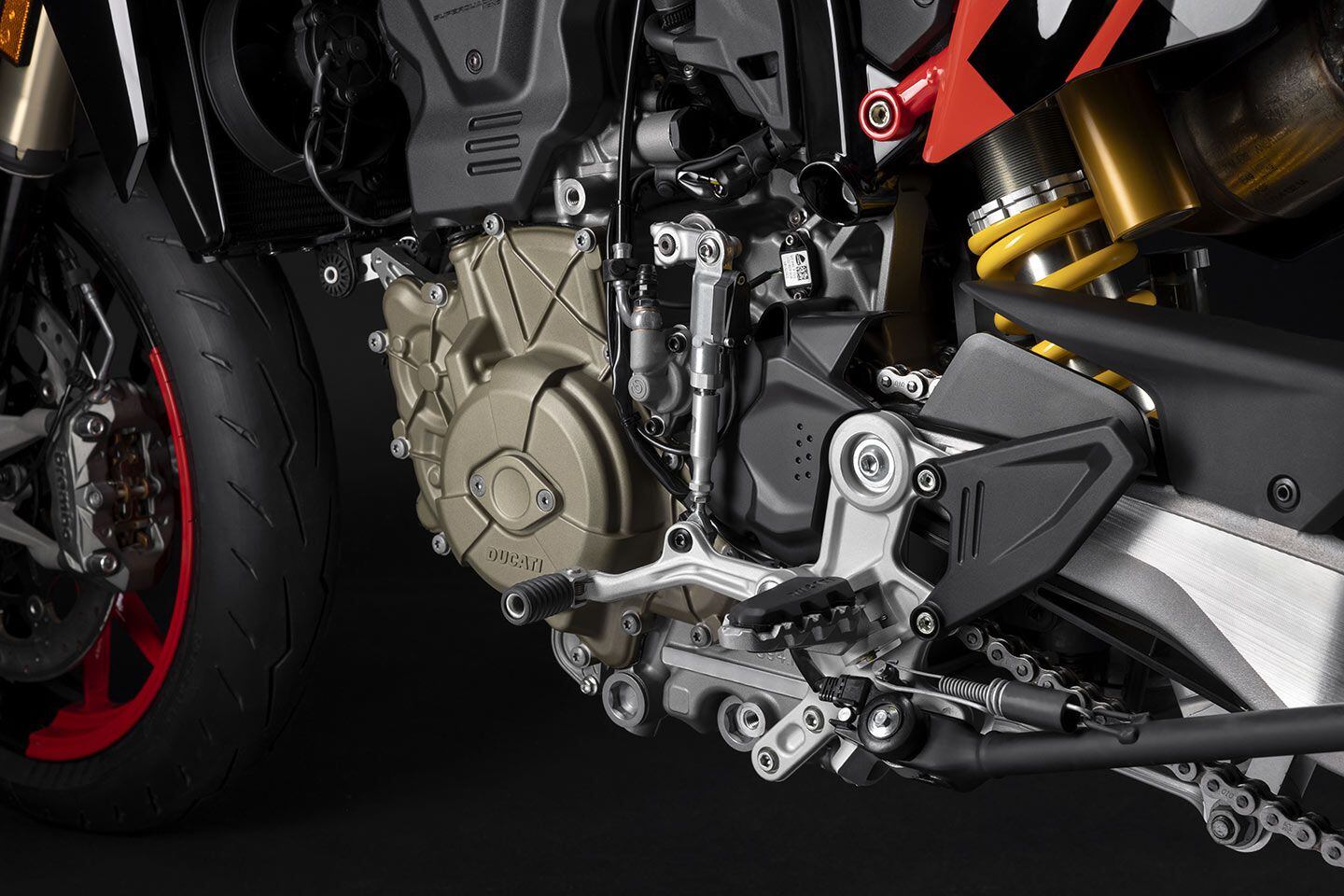
Ducati’s new Superquadro Mono engine powers the Hypermotard 698 Mono. (Ducati/)In its first outing, however, the new Superquadro Mono engine is offered in a pure, daring execution powering a sharp-looking Hypermotard, At 333 pounds it really is lean and mean, given the power and the 46.5 lb.-ft. of peak torque at 8,000 rpm. The Ducati Hypermotard 698 was conceived exactly to offer supreme agility to fully exploit the power and the very strong response of the Superquadro Mono over a very wide rpm range.

2024 Hypermotard 698 Mono RVE, $14,495. (Ducati/)The chassis is based on a classic steel-tubing trellis frame featuring a 26.1-degree steering axis rake and 4.2-inch trail to achieve a positive combination of stability (given the speed potential) and agile steering response in perfect Hypermotard style. The chassis spans a 56.8-inch wheelbase that ensures a front-biased weight distribution that is meant to get the best out of the steering geometry to return a very precise steering response under any riding condition and with any riding style—knee-dragging sport or countersteering dirt-track style.
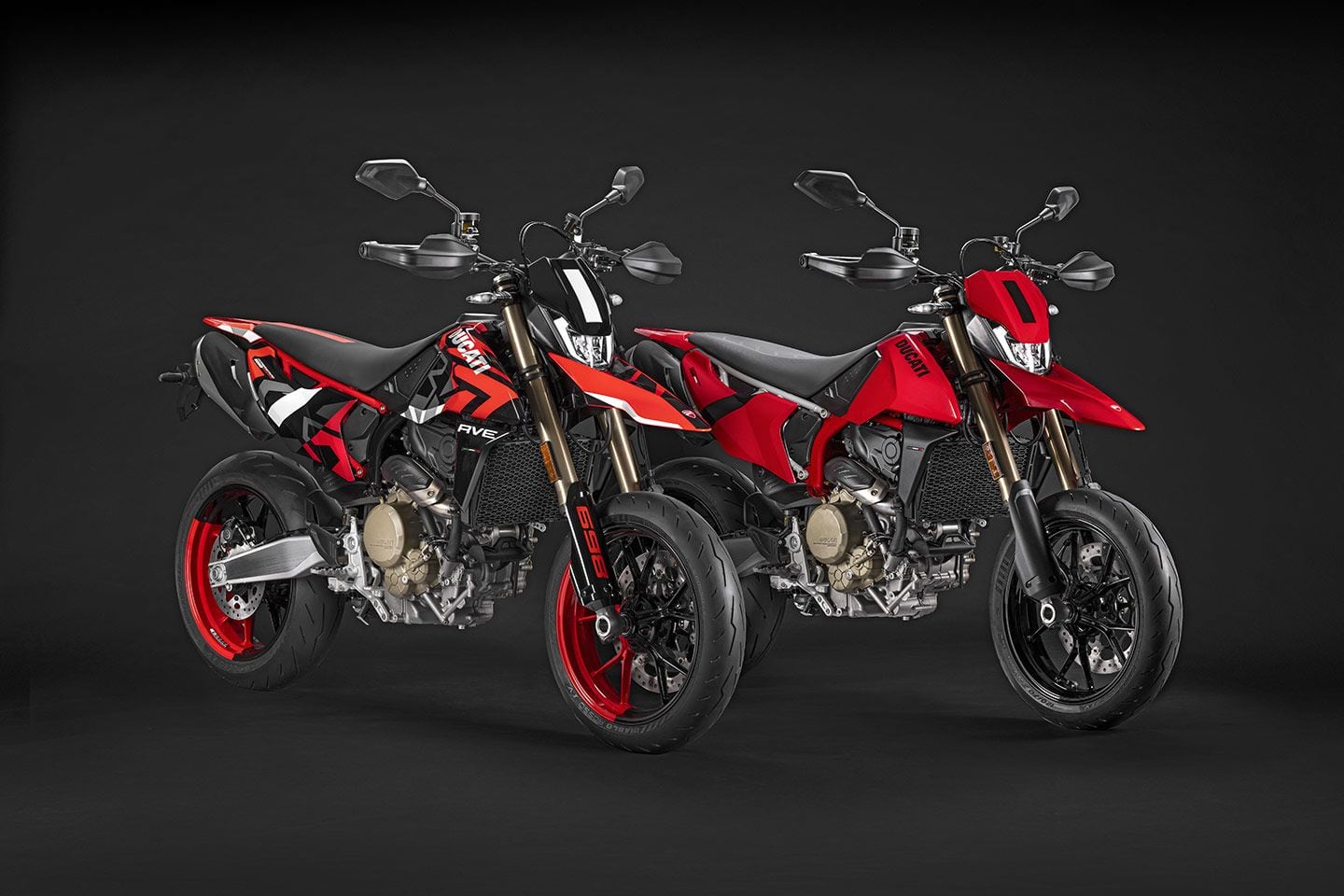
Two versions of the Hypermotard 698 Mono are available, the RVE gets graphics inspired by “street art.” (Ducati/)Great attention was given to the weight in order to make this the fastest and strongest-performing single ever. Even the steel tubing of the frame trellis structure has optimized sizing to obtain maximum rigidity with light weight. The same applies to the fully adjustable 45mm Marzocchi fork and the cast aluminum wheels.
A single 330mm front rotor is teamed to a Brembo M4.32 caliper to reduce unsprung mass while delivering all the needed stopping power, assisted by Bosch cornering ABS. The Hypermotard 698 rolls on Pirelli Diablo Rosso IV radials in 120/70-17 and 160/60-17, front and rear respectively.
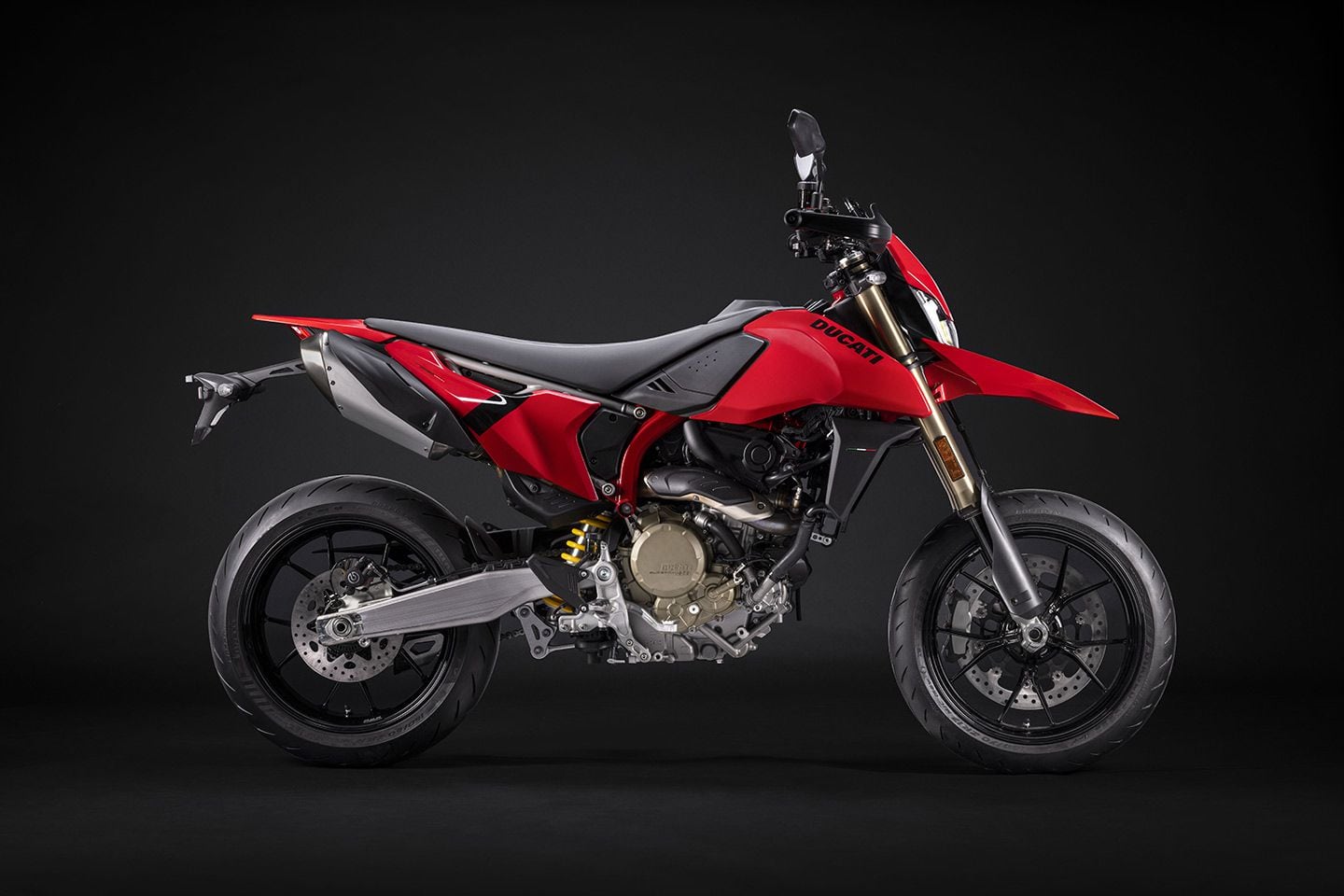
2024 Ducati Hypermotard 698 Mono, $12,995. (Ducati/)The bike is very lean and its styling is pure Hypermotard, with plenty of ground clearance. The engine is clean and with a massive presence; the high exhaust with twin mufflers up high at the rear further exposes the engine to stand strong alone. The seat height is a bit on the tall side, at 35.6 inches, and that might make riding through downtown traffic less rewarding than open road or even track riding, though the handlebar is in the proper place to return a natural feel.
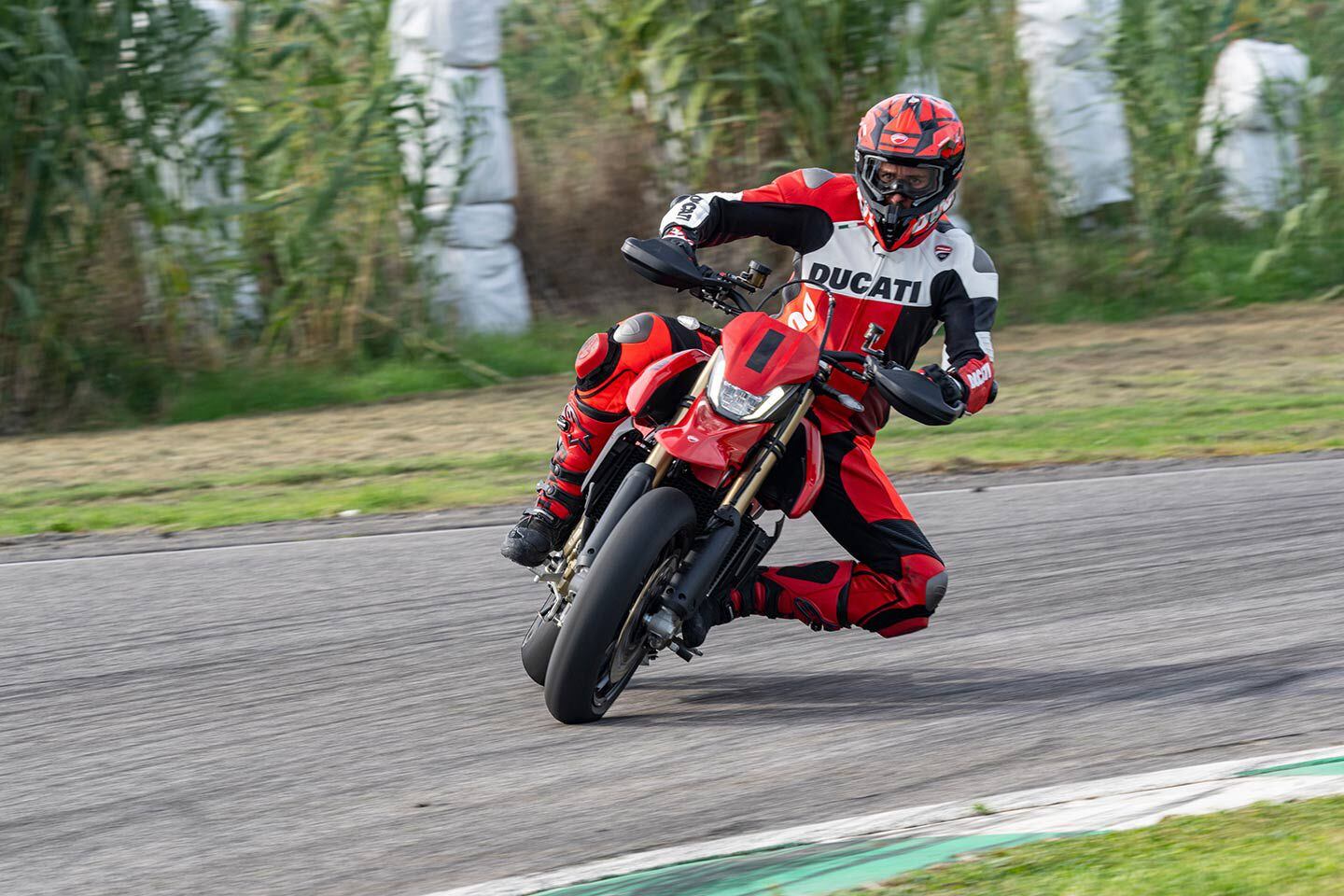
A Slide-by-Brake ABS setting allows the rider to back the Hypermotard 698 into a corner safely with consistency. (Ducati/)The electric suite is up to the excellent standards that characterize all Ducati models. A powerful ECU controls the throttle action to prevent unwanted traction loss, wheelies, or excessive engine-braking. Four cornering ABS control levels can be selected by the rider, and two include Slide-by-Brake functionality that allows for backing the Hyper into corners with consistency. The wheelie control function offers four levels to select from, to fully extract the best spirit from the Hypermotard 698. The engine response can be modulated over four riding modes, according to the riding conditions, while a power launch function is available to leave some four-cylinder machines behind at the lights. A 3.8-inch instrument display acts as an infotainment controller, including connectivity to a smartphone.
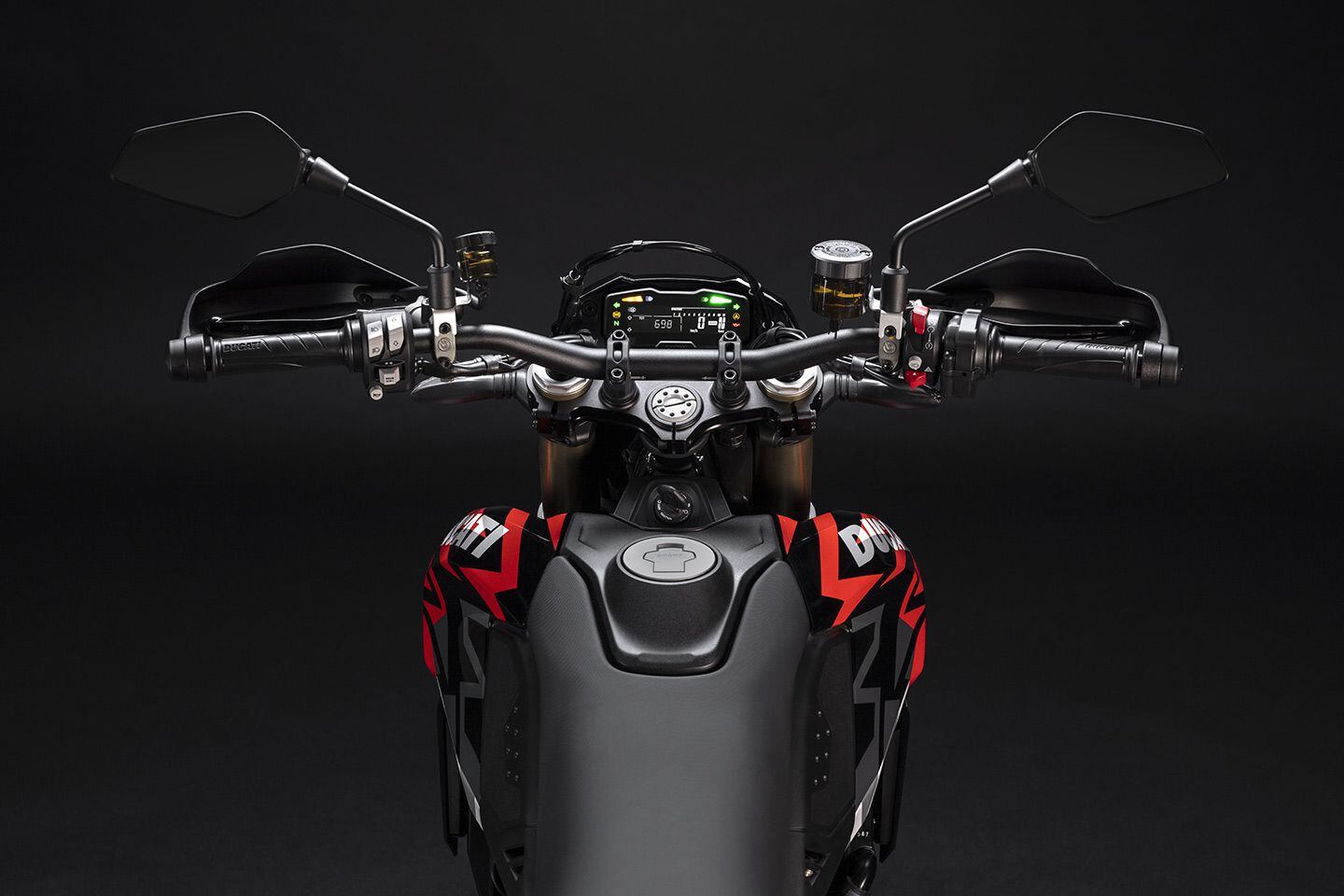
A 3.8-inch TFT dash has smartphone connectivity. (Ducati/)The Hypermotard 698 comes in two executions, 698 Mono and 698 Mono RVE, and the list of optional equipment includes an electronically controlled quick-shift up and down and a Termignoni exhaust system that bumps the power to an out-of-sight 84.5 hp. This impressive son of the unforgettable Panigale 1299 V2 demands servicing every 9,000 miles, or 24 months, while the desmo valves require adjustment every 18,000 miles.
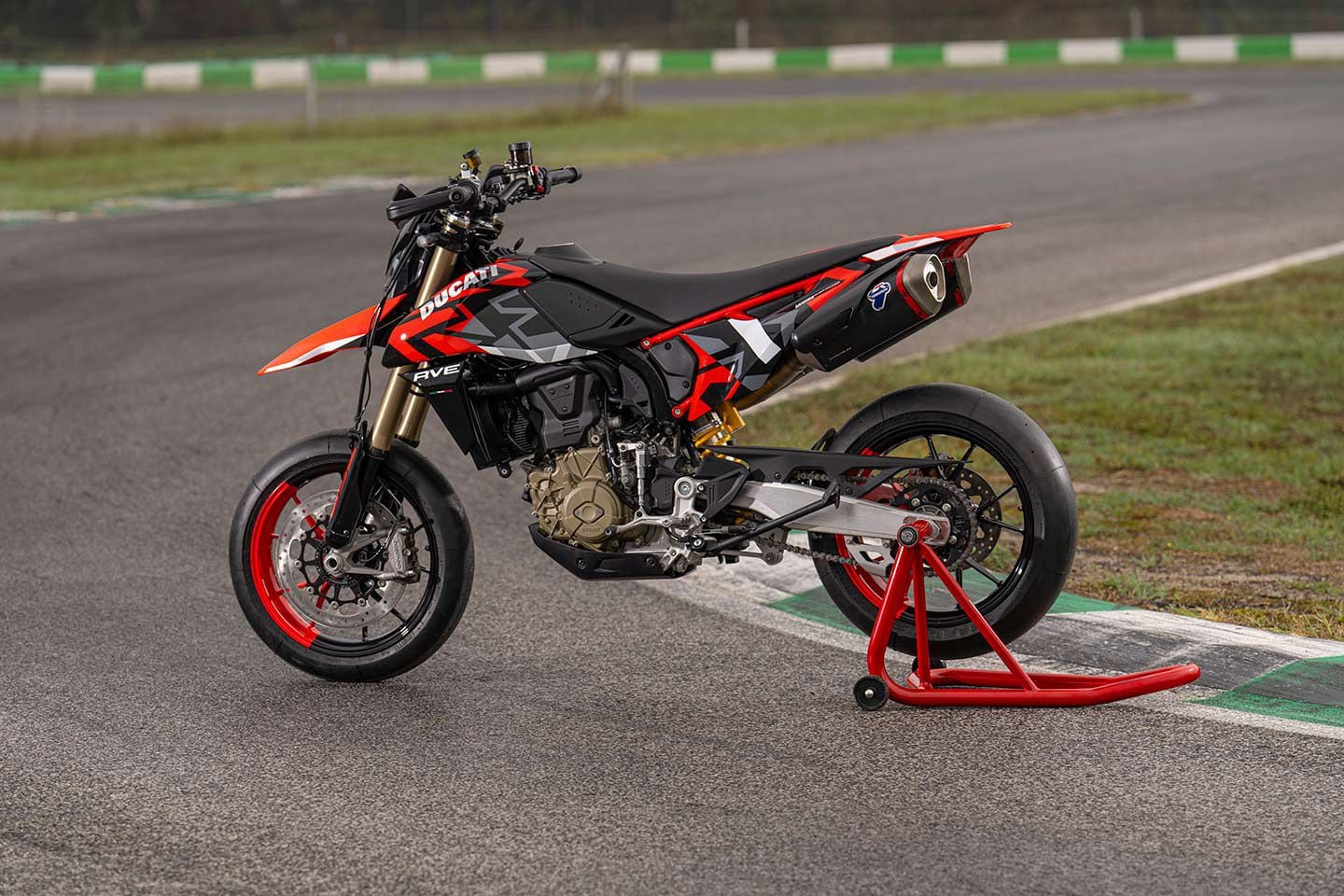
The addition of a Termignoni exhaust boosts the power of the Hypermotard 698 Mono to a claimed 84.5 hp. (Ducati/)Priced at $12,995 for the Ducati Red Hypermotard 698 and $14,495 for the RVE version, dealer availability is set for February 2024.
2024 Ducati Hypermotard 698 Mono Specs
MSRP: $12,995 / $14,495 (RVE) Engine: Liquid-cooled, Desmodromic timing single; 4 valves Displacement: 659 Bore x Stroke: 116 x 62.4mm Compression Ratio: 13.1:1 Claimed Horsepower: 77.5 hp @ 9,750 rpm Claimed Torque: 46.5 lb.-ft. @ 8,000 rpm Fuel System: EFI w/ 62mm throttle body; Ride-by-wire Clutch: Wet, multi-plate; slipper and self-servo function; hydraulic actuation Frame: Tubular steel trellis Front Suspension: 45mm Marzocchi fork; fully adjustable; 8.5 in. travel Rear Suspension: Sachs monoshock; full adjustable; 9.4 in. travel Front Brake: 330mm Disc; Brembo M4.32 caliper; radial master cylinder; Bosch cornering ABS Rear Brake: 245mm Disc; single piston floating caliper; Bosch cornering ABS Wheels, Front/Rear: Y-shaped 5 spoke alloy; 3.5 x 17” / 5.0 x 17” Tires, Front/Rear: Pirelli Diablo Rosso IV; 120/70ZR17 / 160/60ZR17 Rake/Trail: 26.1° / 4.2 in Wheelbase: 56.8 in. Seat Height: 35.6 in. Fuel Capacity: 3.0 gal. Claimed Dry Weight: 333 lbs Contact: ducati.com -

Dainese Introduces Its 2024 D-Air Racing Suits: Three New State-of-the-Art Motorcycle Suits (Dainese/)Dainese Press Release:
Dainese, the world leader in protective wear for motorcycle athletes and enthusiasts, known for incorporating style and design with premium safety features, introduced two new racing suits for the 2024 riding season.
The MUGELLO 3 D-AIR®, MISANO 3 D-AIR® and MISANO 3 D-AIR® WMN: three state-of-the-art, lightweight, high-performance motorbike suits, equipped with the revolutionary triple-activation D-air® Racing airbag and the pentaxial elastic system, designed to offer the very highest levels of performance and safety on the track, as well as maximizing comfort and ergonomics.
The latest incarnation of the D-air® RACING SHIELD 3X system – featuring the Racing Shield 3x airbag with patented microfilament technology that allows for up to three consecutive activations – ensures maximum safety on the bike. The system takes safety to the next level by allowing the rider to independently replace the gas generator up to 3 times before the airbag needs replacing.
Plus, Riding Mode by Dainese allows you to choose the airbag use mode depending on whether you’re on the road or the track. The right mode selection offers the greatest possible safety for the conditions to be faced.
Superior performance is guaranteed by the technologies used in the construction of all three of these suits, rendering them extremely ergonomic; in addition, they are the lightest racing suits with an integrated airbag system. Specifically, the Mugello 3 weighs 20% less than the lightest suit with an integrated airbag system currently on the market. Safety, superior quality and comfort meet unprecedented lightness.
The innovative pentaxial elastic system on the back enables maximum freedom in the saddle in any riding position, due to the suit’s capacity to stretch in five directions, adapting seamlessly to the rider’s movements.
The new Veloce Racing Neck design, race-tested by MotoGP riders, reduces pressure on the neck, increasing freedom of movement and control. The Pro-Armor protectors on the shoulders and the soft inserts on the hips provide comfortable protection in all racing conditions. The new Soft Edges Construction system on the nape and cuffs – made from engineered abrasion-resistant and breathable fabric – enables maximum fit adaptability on all sizes and arm lengths.
The metal plates (titanium for the Mugello 3, aluminum for the Misano 3 and Misano 3 WMN) on the knees, shoulders and elbows – an iconic technology used across Dainese racing clothing – are designed to facilitate sliding in the event of a fall, minimizing the risk of rolling and maximizing energy dissipation.
Innovation in every detail: the latest evolution of the Replaceable Slider System (RSS) 4.0 now enables the knee slider to be changed without altering the position of the base attached to the Velcro on the suit. This makes it possible to maintain an ideal position at all times, by simply replacing the new slider. Innovation also comes to the elbows of the suit, which now offer two different slider positions; these can be easily adjusted with one hand with no need for tools, so riders can always choose their preferred position based on the lean angle achieved. Thermal comfort is guaranteed through the perforated areas on both sides of the suit, with larger vents at strategic points, for the best performance even on the hottest days at the track.
Finally, the in-and-out boot system allows the boot to be worn both inside and outside the suit, as the rider chooses. The waterbag kit and the new removable and washable inner liner complete the highly versatile features of Dainese’s most advanced suits ever.
The MUGELLO 3 PERF. D-AIR® 1PC LEATHER SUIT, crafted entirely from high-quality durable kangaroo leather, will be available for $4999.95 USD. The MISANO 3 PERF. D-AIR® 1PC LEATHER SUIT, made from D-Skin 2.0 full-grain cowhide which offers excellent ergonomics and performance, will retail at $2799.95 USD. In the women’s version, the price of the MISANO 3 PERF. D-AIR® 1PC LEATHER SUIT WMN in D-Skin 2.0 full-grain cowhide will be $2799.95 USD.
-
Then there were four. CFMoto’s MTX Concept is also rumored to be a totally different model, allegedly.
-
 1
1
-
-
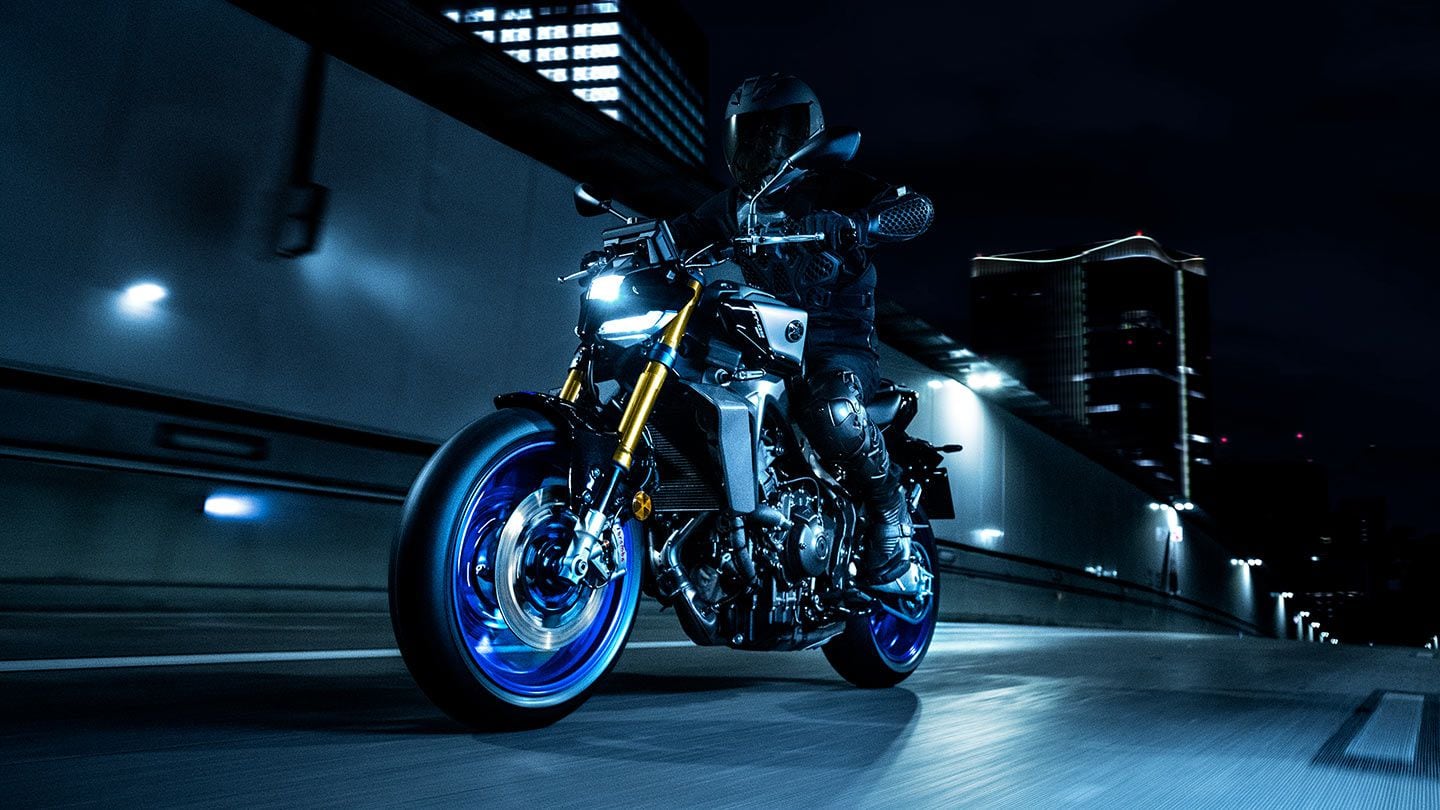
Yamaha’s MT-10 celebrates 10 years with an upgraded version of the SP. (Yamaha/)Yamaha’s MT-09 and “The Dark Side of Japan” design concept was first unleashed back in 2014, and has offered a balanced and potent approach to the middleweight naked sportbike class ever since. The bike was born with aggressive styling, a stripped-down appearance, and a light and agile chassis. At its heart has always been Yamaha’s 890cc three-cylinder four-valve DOHC liquid-cooled CP3 engine, with its torque-rich delivery. For the 2021 model year, Yamaha added an up-spec version called the SP, with upgraded suspension and features. For 2024, and the bike’s 10-year anniversary, the ante has been upped again with a feature-laden MT-09 SP.
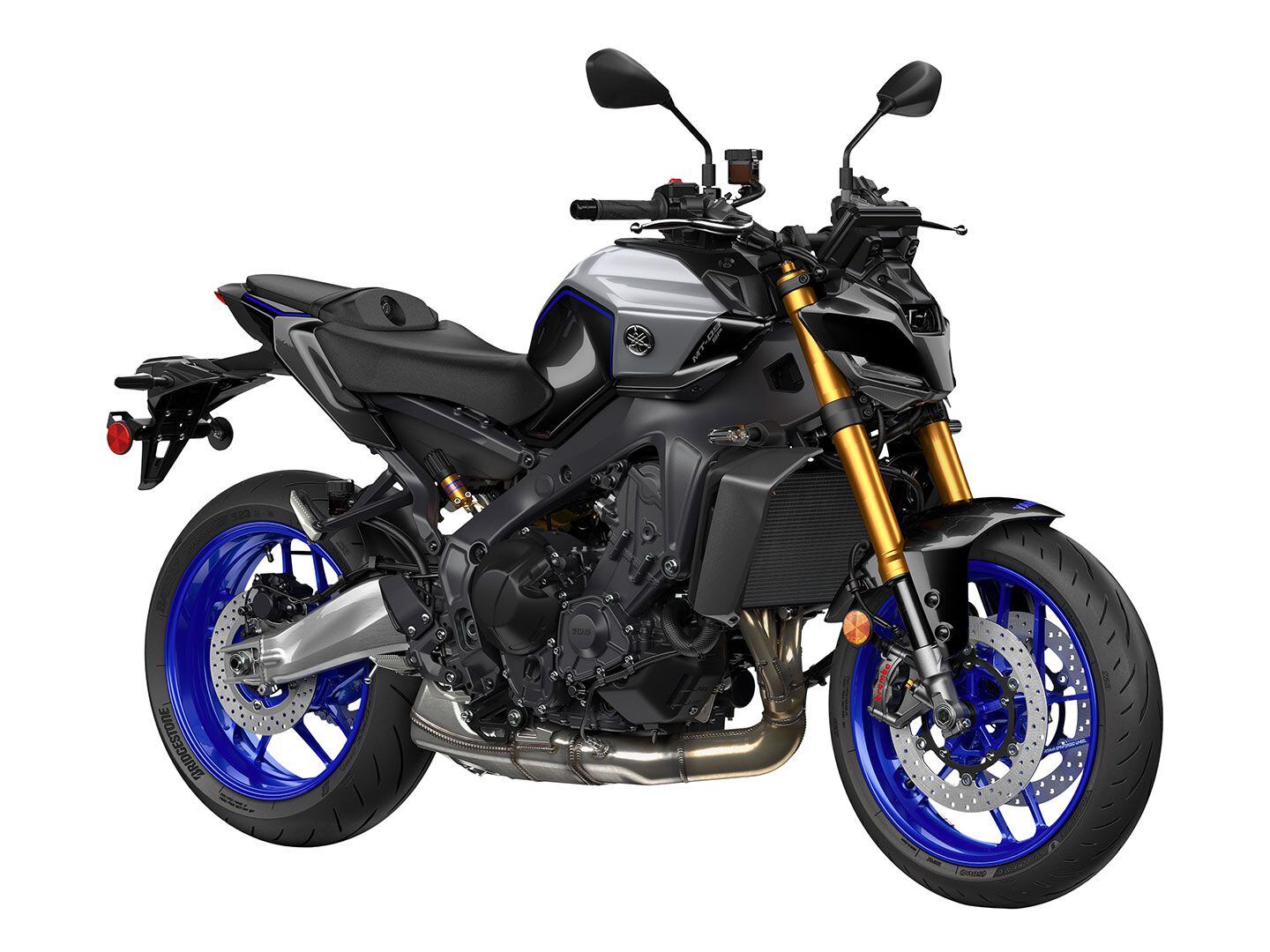
The SP will be available in one color scheme: Liquid Metal/Raven. (Yamaha/)Also new for 2024 is an updated version of the base MT-09, which received refreshed styling, improved ergonomics, a brand-new 5-inch TFT color display, new Back Slip Regulator system, third-generation quickshifter, and a few other details. The SP version gets all of those changes in addition to Brembo Stylema brake calipers and a radial master cylinder of the same make, a fully adjustable DLC-coated KYB fork, and fully adjustable Öhlins shock. Additionally there is the exclusive R1M-inspired colors, a polished and clear-coated aluminum swingarm, four track-specific Ride Control modes, two new Engine Brake Management modes, and a Smart Key System with a fob and new starter switch.
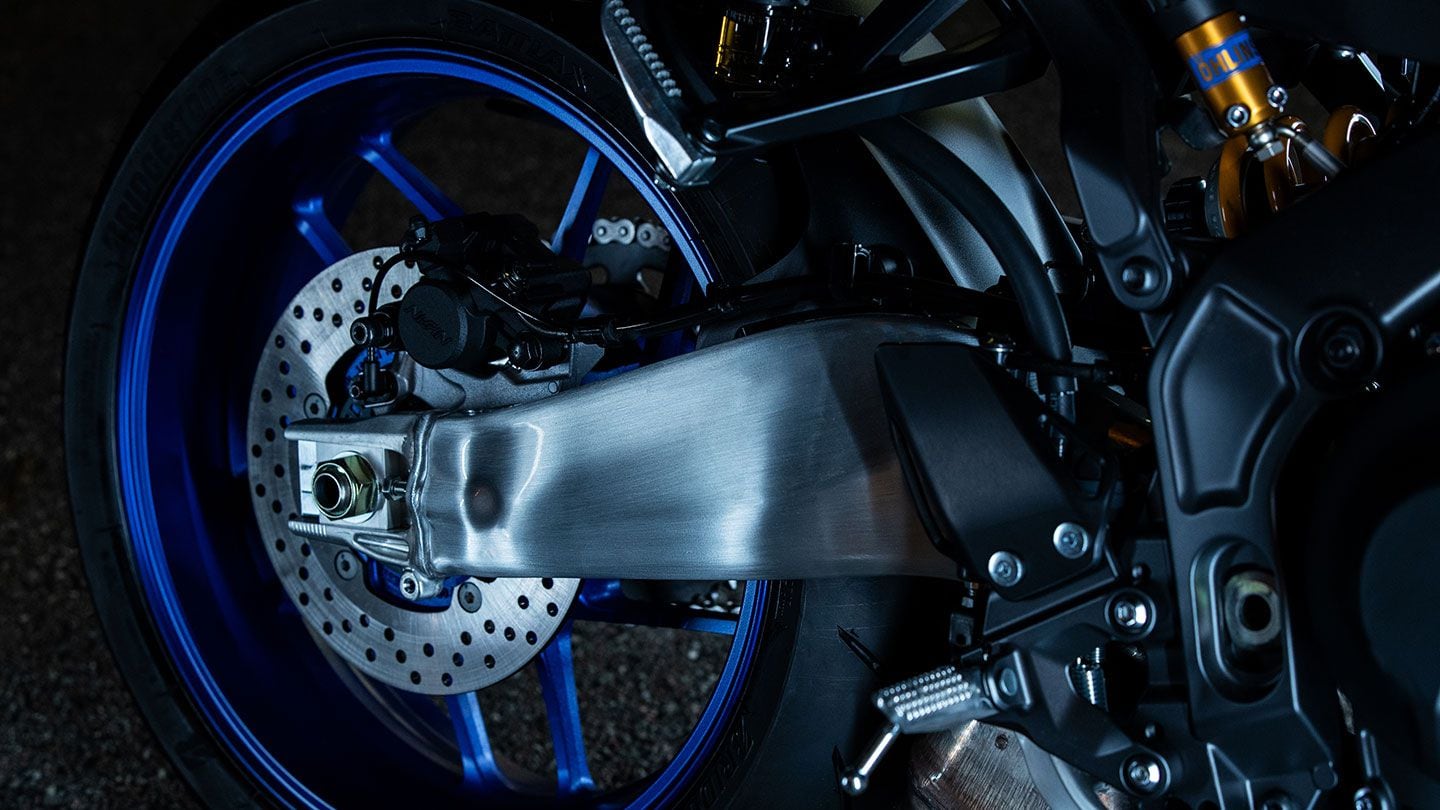
The MT-09 SP gets a polished and clear-coated aluminum swingarm. (Yamaha/)The latest version of the CP3 engine uses the Yamaha Chip Controlled Throttle (YCC-T) as before, which allows for precise control of the throttle valves and gives the bike its advanced ride modes. Not only does the bike’s exhaust system provide a unique soundtrack, but the new Acoustic Amplifier Grilles atop the newly designed fuel tank enhance that symphony to the rider in the cockpit. The brand-new third-gen quickshifter offers two settings and allows for improved shifts while under hard acceleration or deceleration.
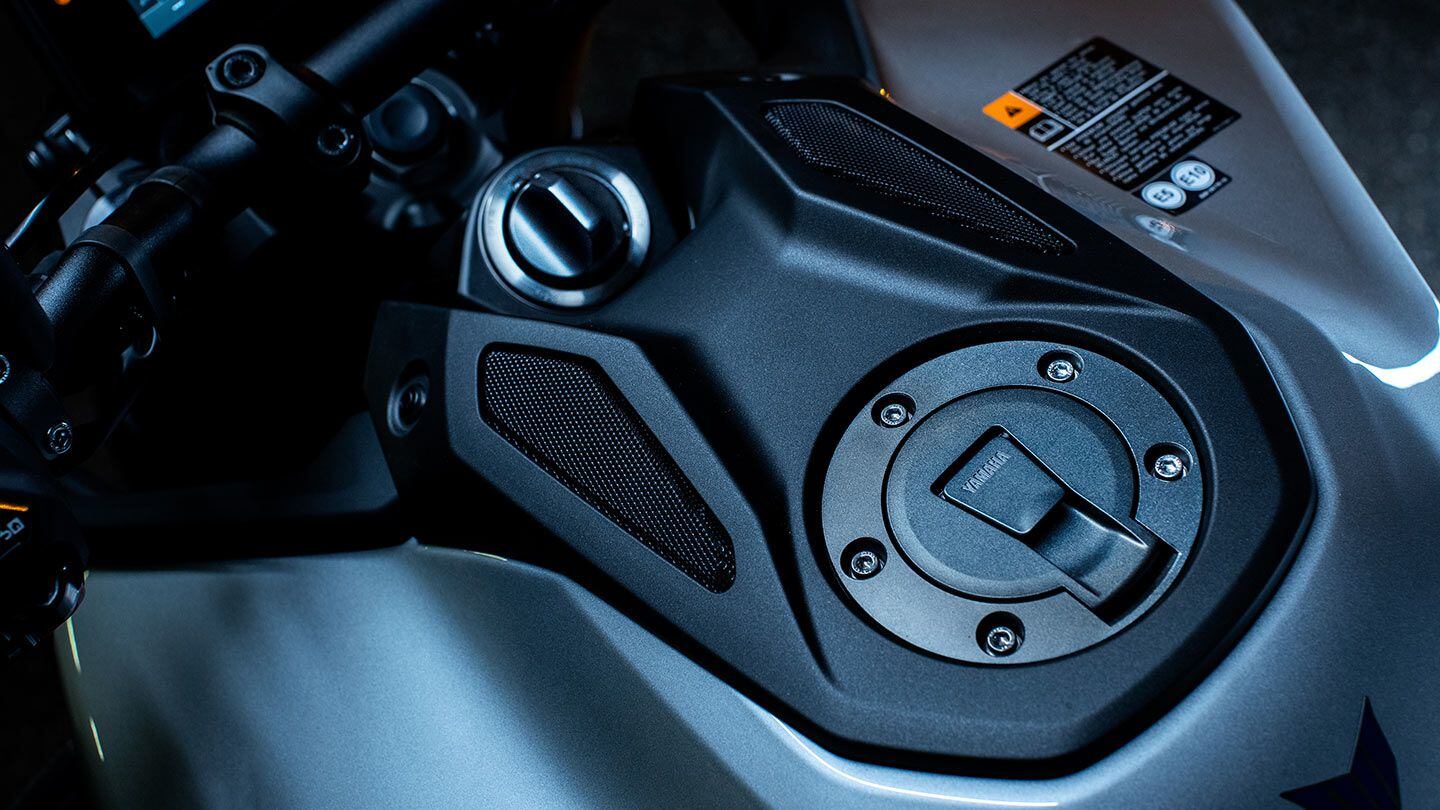
The new tank features Acoustic Amplifier Grilles to enhance sound to the rider in the cockpit. (Yamaha/)The brand-new 5-inch TFT display gives the rider access to the bike’s advanced electronics suite and YRC settings. A six-axis IMU feeds the bike information to optimize TC, ABS, slide control, and wheelie control. There are three standard modes, including Sport, Street, and Rain, and two customizable rider modes. The SP also gets four additional track-specific modes with the ability to turn off the rear ABS. The Traction Control System (TCS) has four levels of intervention, while Slide Control System (SCS), front wheel Lift Control System (LIF), two-mode Brake Control System (BC), a new Back Slip Regulator (BSR), and the SP-exclusive Engine Brake Management (EBM) can all be adjusted to preference.
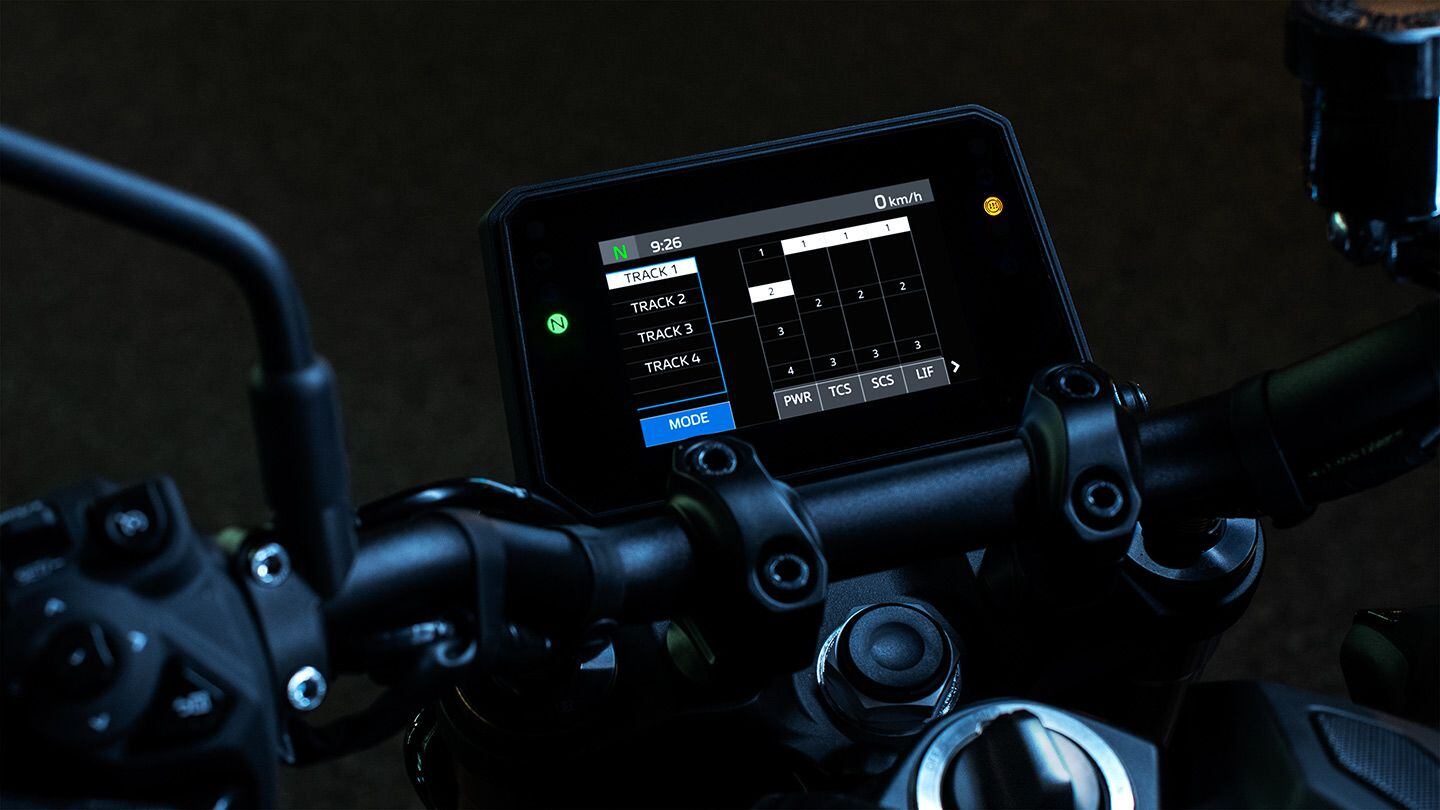
The YRC electronics suite allows the user to modify electronic rider aids to preference, while the SP also gets four additional track-specific options. (Yamaha/)The dash itself has a choice of five different visual themes, including an SP-specific Track mode. Like its cousin the Tracer 9 GT+, the new system offers smartphone connectivity, and available turn-by-turn navigation through the Garmin StreetCross app. Wrapping up the electronics, the SP comes with Yamaha’s new Smart Key System with a fob that can be carried in your pocket, and is also used to unlock the fuel-tank cap.
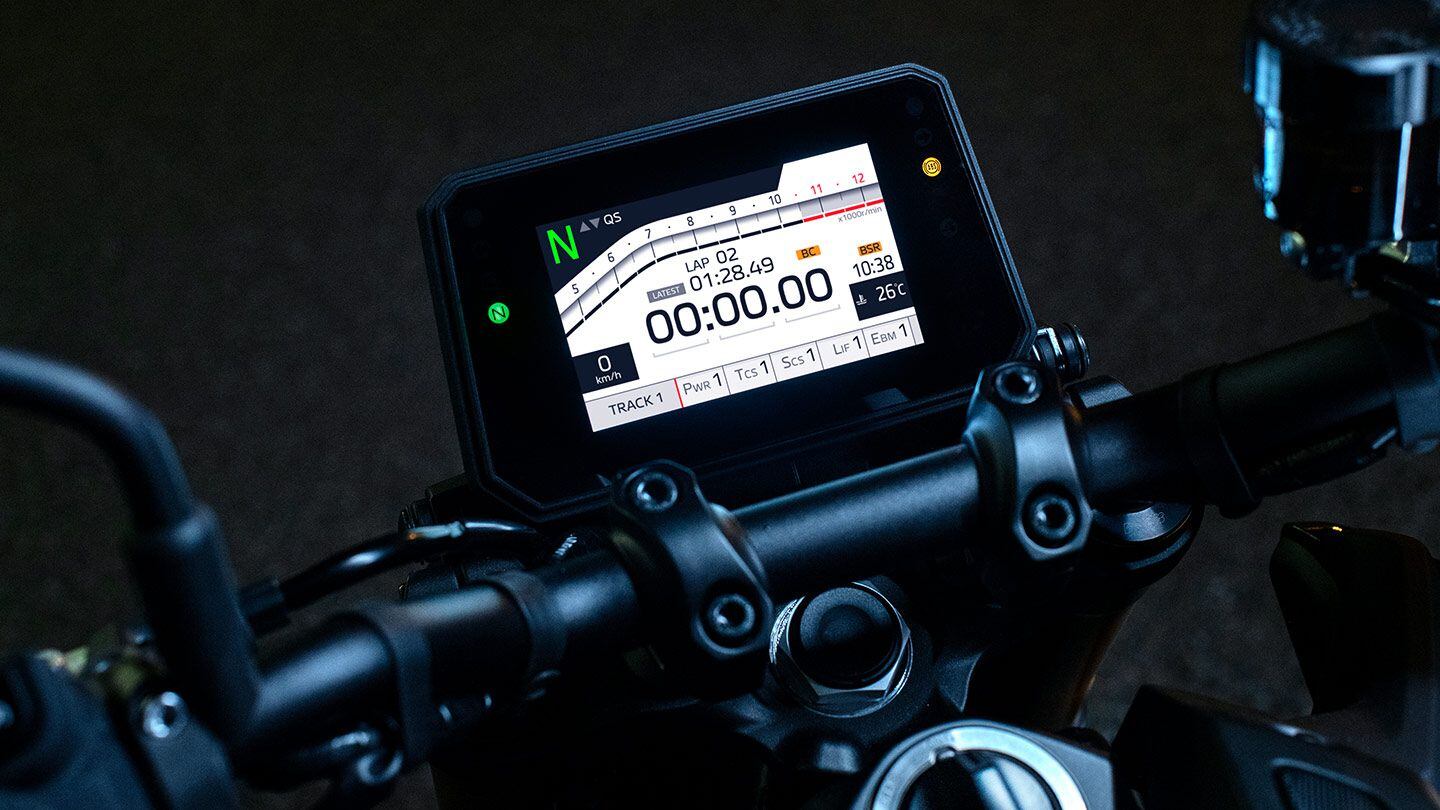
The dash offers five visual themes including this track-specific option. (Yamaha/)Unlike the MT-10 SP which gets electronic Öhlins suspension, the MT-09 SP gets a fully adjustable 41mm DLC-coated KYB inverted fork with provisions for preload, rebound, and high- and low-speed compression damping. Out back is a fully adjustable Öhlins shock with a remote preload adjuster. But one of the biggest changes for 2024 is the use of Brembo Stylema Monoblock brake calipers mated to a radial master cylinder and biting down on a pair of 298mm discs.
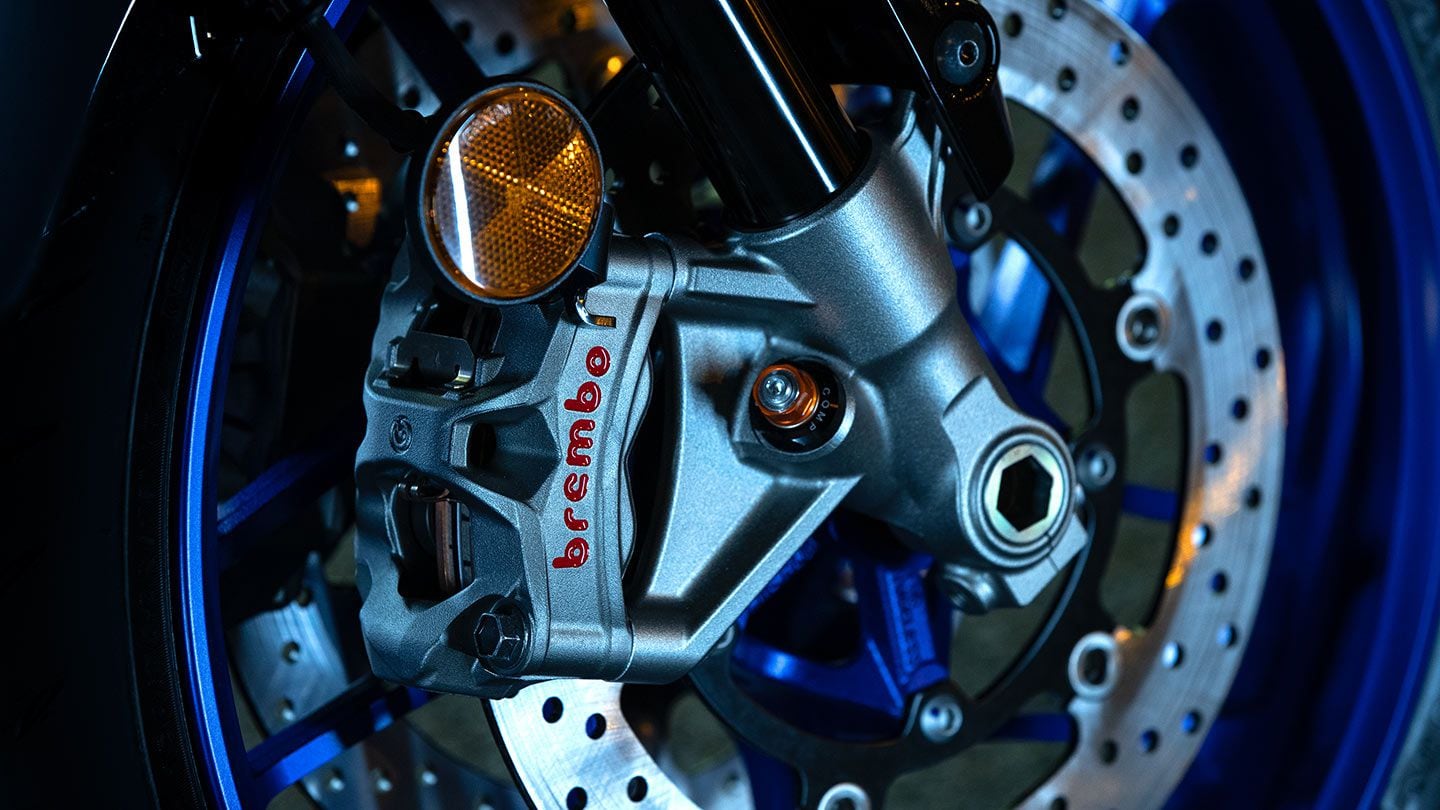
Brand-new Brembo Stylema calipers bite down on 298mm discs. (Yamaha/)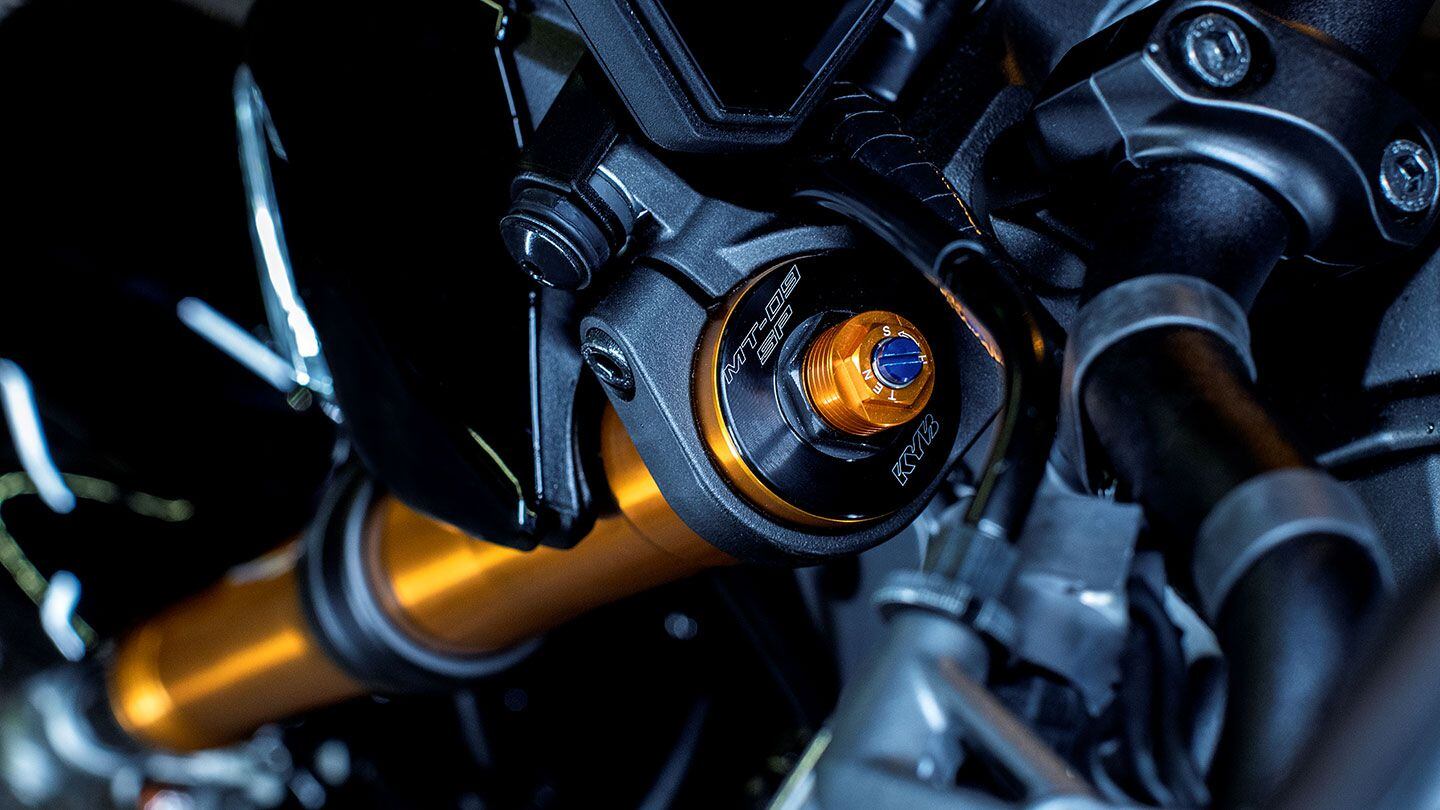
A fully adjustable 41mm DLC-coated KYB fork is new. (Yamaha/)Ergonomics have been altered with lower handlebar position that can be customized to two settings, while the footpegs also offer two settings. The fuel tank itself is now shorter in height and offers more room in front of the rider for a more comfortable cockpit.
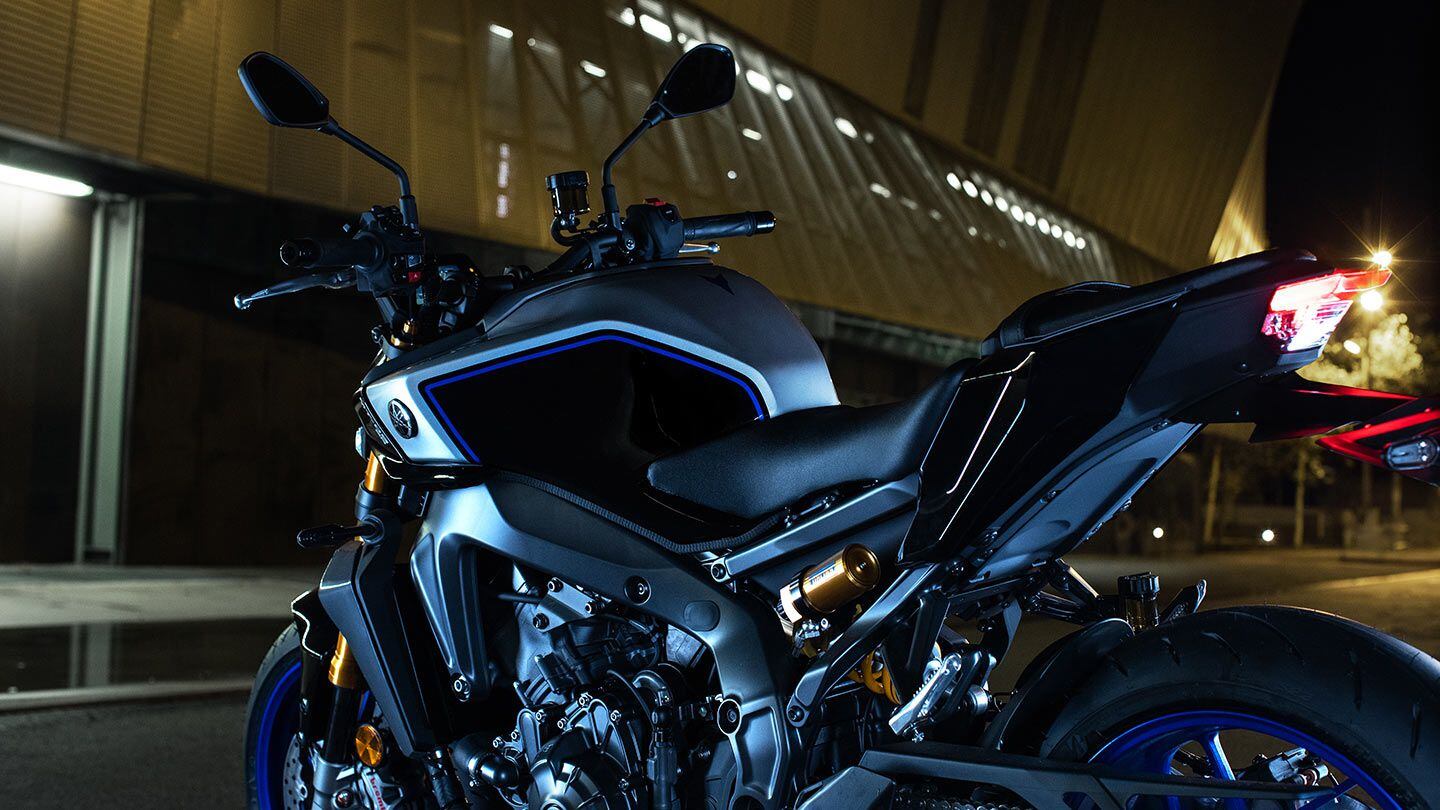
The cockpit is roomier with a lower tank height, while both the handlebar and footpegs can be adjusted to two positions each. (Yamaha/)The 2024 Yamaha MT-09 SP will be available in the single Liquid Metal/Raven color scheme, and will be available in dealerships in late spring for $12,299.
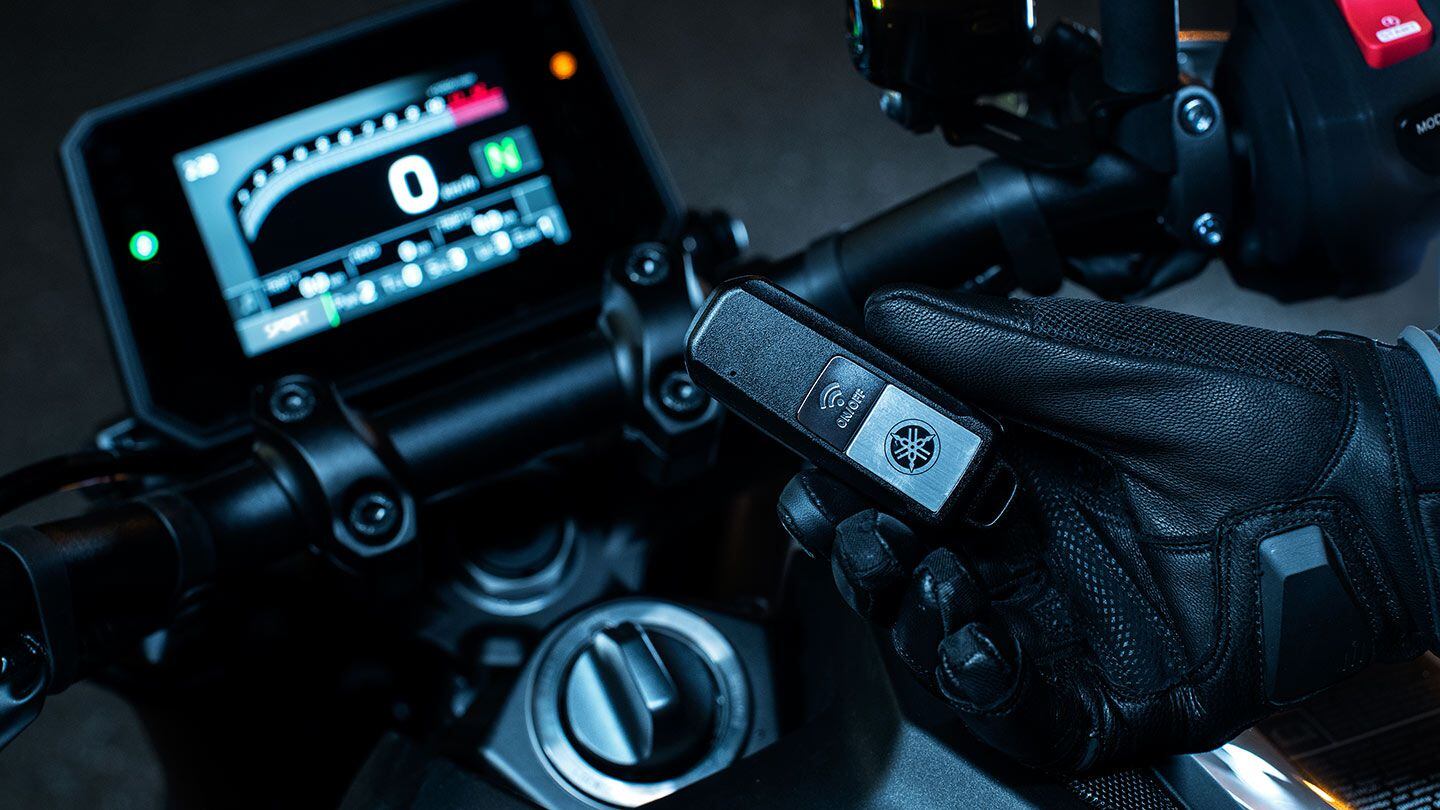
Yamaha’s MT-09 SP comes with the brand-new Smart Key System. (Yamaha/) -

Riding the Kawasaki Ninja 7 Hybrid in Barcelona, Spain. The Ninja 7 is the world’s first mass-production strong hybrid motorcycle. (Kawasaki/)It’s interesting to consider what the book on the electrification of motorcycles will look like a decade from now. There will be chapters on the startups that led the initial charge and the bikes that changed the public’s perception of electric motorcycles. There will be stories about the throng of electric bicycles that attracted a new generation of riders, the companies that failed to deliver on their promises, and on the manufacturing powerhouses that finally decided to enter the game.
There will also be a chapter on hybrid motorcycles, and it’ll undoubtedly start with a mention of the Kawasaki Ninja 7 Hybrid, the first mass-production strong hybrid motorcycle—Kawasaki’s two-wheeled solution for the modern world, where Zero- and Low-Emissions Zones are very much a reality. Even if they haven’t made their way to the United States, yet.
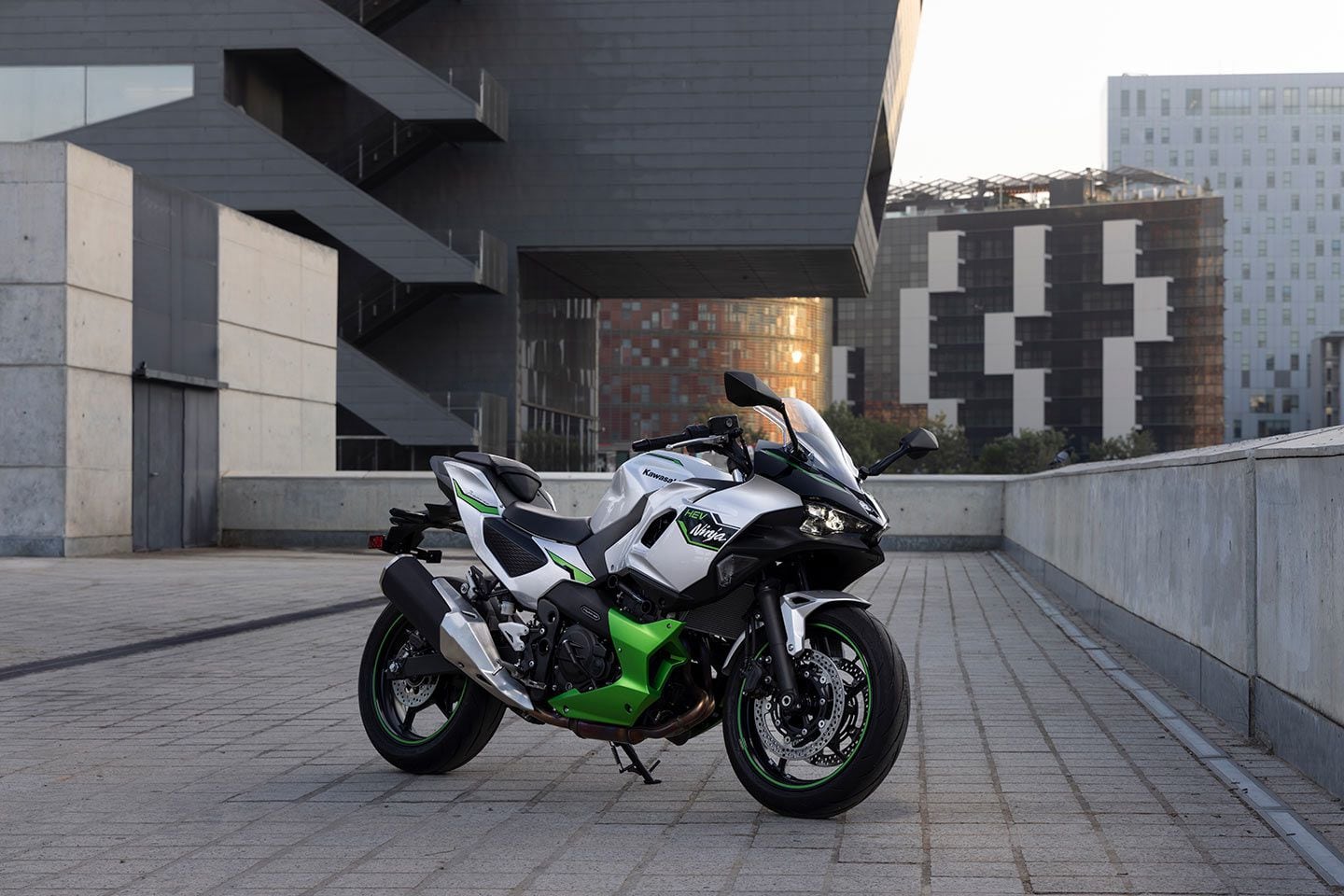
The Ninja 7 Hybrid is a blend of aggressive Kawasaki styling, larger fairings, and air ducts, the latter two features helping conceal the added hardware and improve cooling. (Kawasaki/)Hybrid Solutions and More
Keyword in the Ninja 7 Hybrid description is “strong,” which signifies that the Ninja 7 Hybrid’s 451cc internal combustion engine (ICE) and electric motor can run simultaneously or power the bike independent of one another, even if the electric motor is sized for slower speeds (sub-40 mph) and short distances (around 7 to 10 miles).
Action is identical to what you’ve come to expect from a hybrid car, but different from that of a mild hybrid (MHEV), which uses battery power to reduce the engine’s workload in certain situations but not to propel the vehicle. This also differs from a plug-in hybrid (PHEV), which generally uses a larger battery and needs to be plugged into an electrical outlet or charging station. No need to worry about finding a working charging station or fussing with cables; the Ninja 7 Hybrid’s battery is charged while riding via the engine and regenerative braking.
Related: 2024 Kawasaki Ninja E-1 and Z e-1 Electric Motorcycles Announced
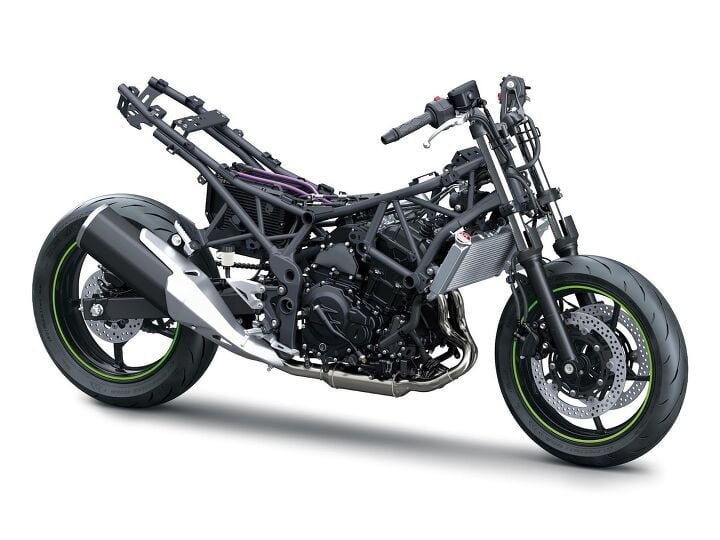
The lithium-ion battery weighs around 30 pounds and is carefully mounted inside the rails of the steel-trellis frame. The frame is strengthened near the swingarm pivot area. (Kawasaki/)Bold and new as the concept might be, at least in the motorcycling world, Kawasaki has long hinted at its intentions to bring forward-thinking models to the market as part of its “work toward a greener future, with the ultimate goal of carbon neutrality.” More evidence of that commitment comes in the form of the company’s all-electric Z e-1 and Ninja e-1 urban commuters, as well as the hydrogen-powered concept that it’s teased.
The 7 Hybrid differs from those models in its attempt to be three motorcycles in one. Think of it as a zero-emissions bike for heavily restricted city centers, a fuel-sipping urban cruiser, and a fully capable canyon carver able to take on 200-plus mile days, suggests Kawasaki.
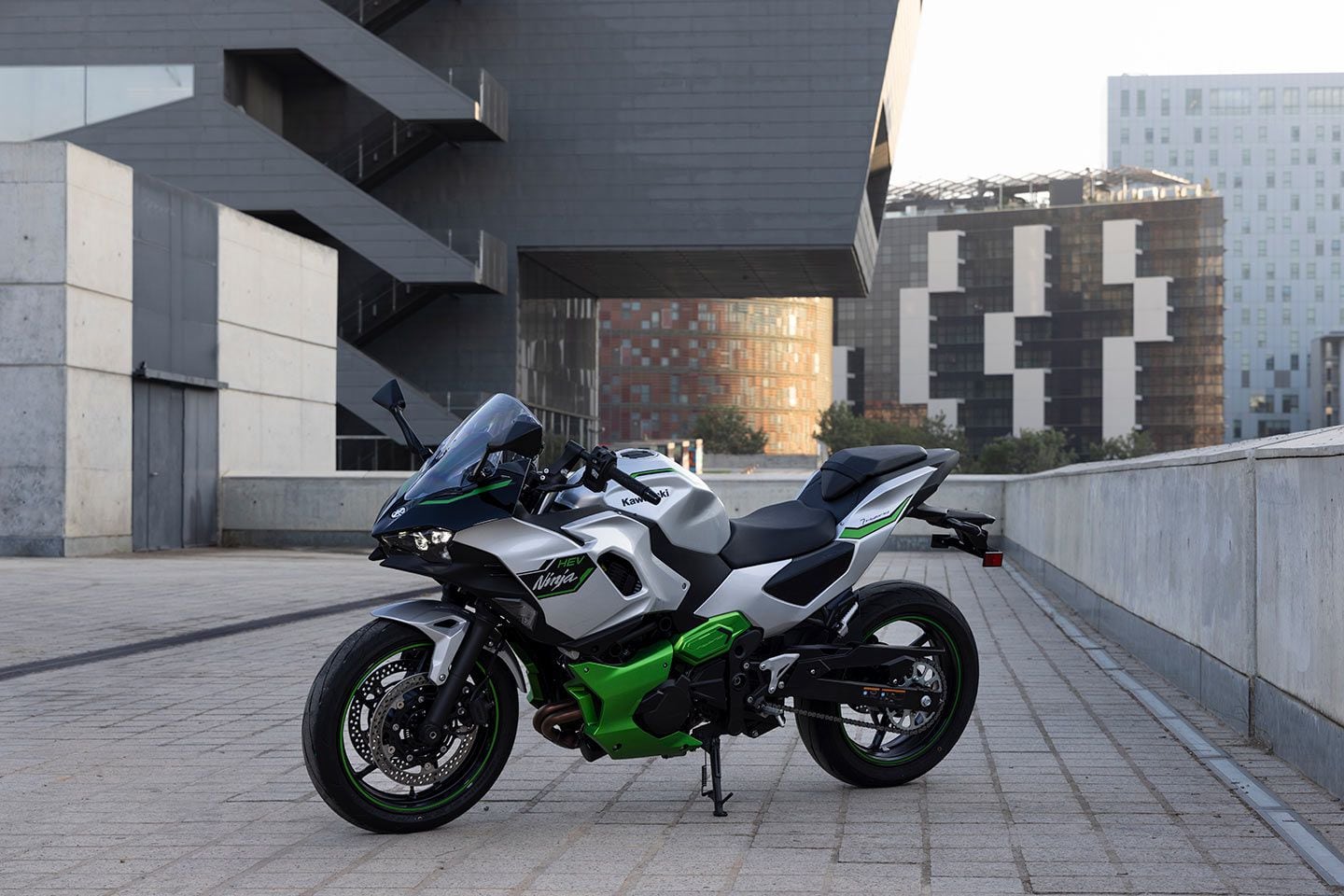
While the black body panel inserts below the seat appear to provide access to the battery, that’s not the case. (Kawasaki/)Chassis: Same but Different
While hybrid cars have been a “mainstream” alternative since the early 2000s when Honda released the Insight and Toyota the first Prius, Kawasaki engineers admit that designing a hybrid motorcycle wasn’t easy given the packaging and weight limits innate to motorcycling.
The solution was to pair a lightweight, Ninja 400–inspired steel trellis frame with a reinforced swingarm pivot area to a longer swingarm and bottom-mount shock linkage. This configuration allows the Ninja 7′s battery pack to be located under the seat and for engineers to not dramatically disturb the center of gravity.
Adding a “7″ to the name suggests the bike will be sized and perform more like a middleweight twin than a small-displacement machine. Think, Ninja 650 versus Ninja 400.
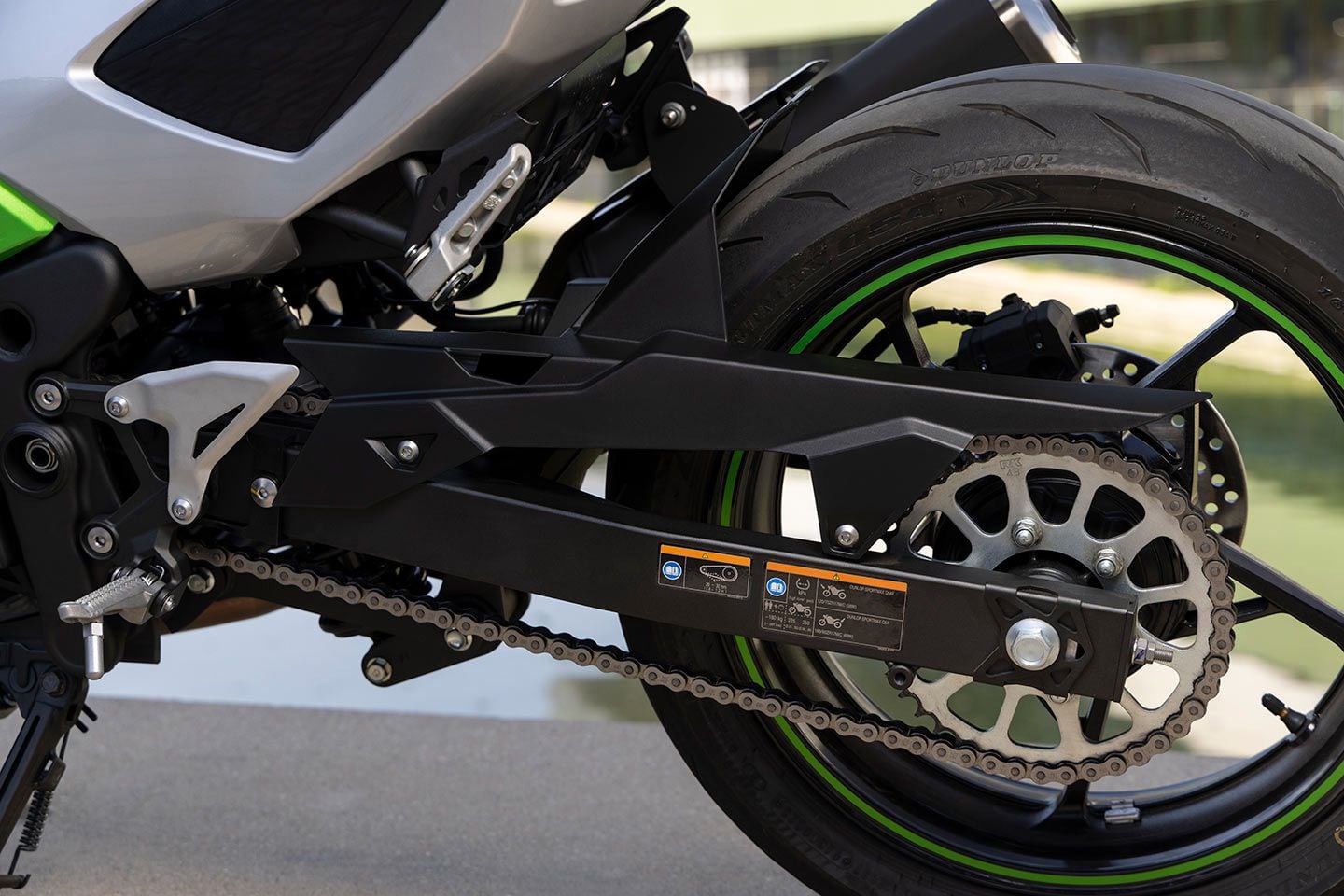
The Ninja 7 Hybrid’s swingarm is longer than that on the Ninja 400 or 650 to accommodate the battery. Wheelbase is 6.5 inches longer than the Ninja 400’s. (Kawasaki/)That mostly feels like the case as you throw a leg over the Ninja 7, though key specs paint a picture of compromise: The 7 Hybrid’s 60.4-inch wheelbase is 4.9 inches longer than the Ninja 650′s and 6.5 inches longer than the Ninja 400′s, while weight (500 pounds) is up 77 pounds when compared to the Ninja 650 and 134 pound when compared to the Ninja 400. Rake is a more relaxed 25 degrees compared to 24 degrees on the Ninja 650 and 24.7 degrees on the Ninja 400, while trail is 4.1 inches, versus 3.9 inches and 3.6 inches on the 650 and 400, respectively. This is a very different motorcycle not only from a performance standpoint, but from a geometry standpoint as well.
Suspension settings are unique to the Ninja 7 Hybrid thanks to a combination of stiffer springs and more aggressive valving, which accounts for the added weight. Dual 300mm front brake discs are used for the same reason. The bike looks very much like a traditional motorcycle with its fairings on, the exception being some unique lines at the rear and a swollen-looking tailsection, which helps conceal the bike’s battery.
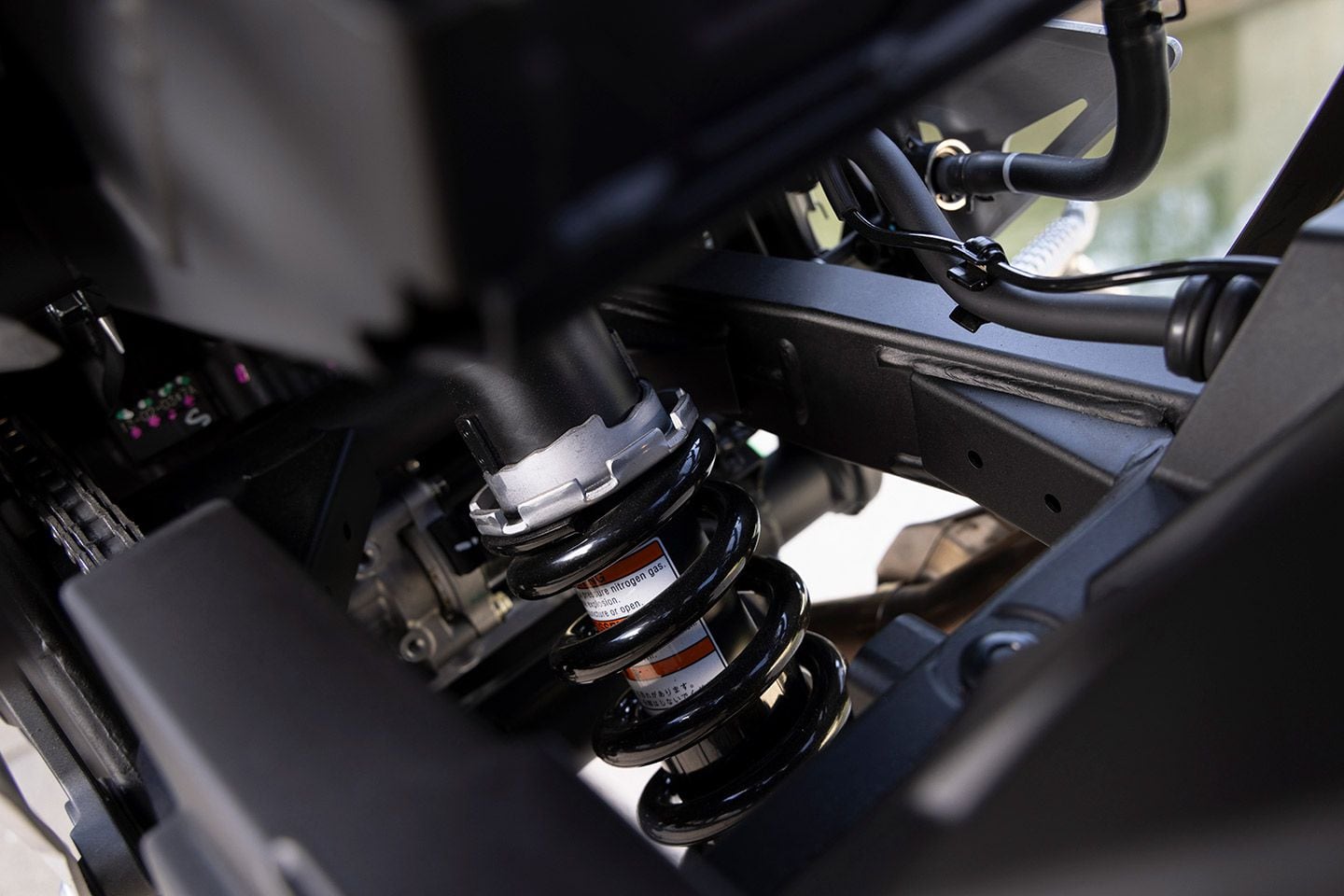
The fork and shock use stiffer spring rates and more aggressive valving to accommodate for the added weight. The only adjustment is spring preload at the rear. (Kawasaki/)Engine and Traction Motor
It’s what’s under those fairings that warrants the most attention; in this case you’re looking at a 451cc parallel-twin engine borrowed from the Kawasaki Eliminator but updated with new velocity stacks, a reconfigured exhaust header, and more aggressive mapping. Said changes are for increased top-end performance, according to Kawasaki engineers, as low-end performance is already bolstered by the 7′s electric motor.
Kawasaki claims that, in Ninja 7 Hybrid trim, the 451cc engine makes 58 hp at 10,500 rpm and 32 lb.-ft. of torque at 7,500 rpm.
The motor is a liquid-cooled, 7kW (9kW max) interior permanent magnet type, mounted behind the engine’s cylinders. Power comes from a 48V lithium-ion battery, cooled via an air duct that runs along the right side of the bike. The motor and battery weigh roughly 29 pounds each, but factor in the additional hardware—including a separate radiator for the electric motor—and you start to see where the Ninja 7 Hybrid’s added weight comes from.
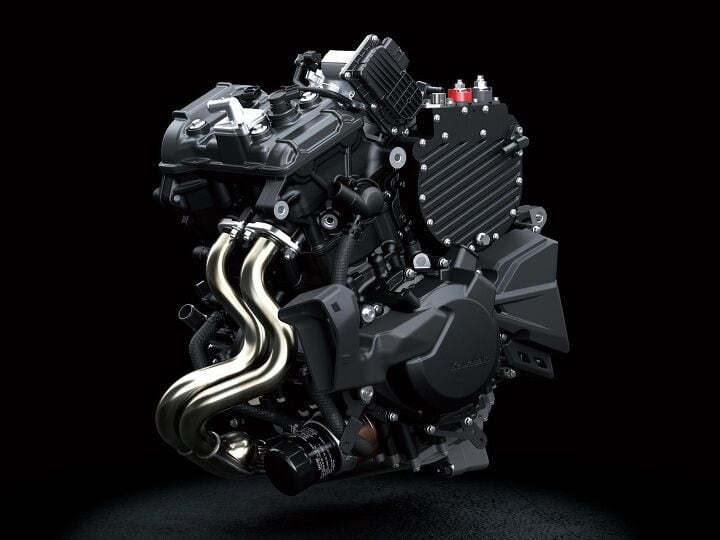
The electric motor sits just behind the cylinder bank of Kawasaki’s 451cc parallel-twin engine. Compared to the engine in the Kawasaki eliminator, this twin uses different intake funnels, header pipes, and mapping for more top-end performance. Rated motor power is 7.0kW, but max motor power is 9.0kW. (Kawasaki/)Importantly, Kawasaki says that the motor and battery were developed with the help of suppliers (Wamtechnik for the battery, Delta Electronics for the traction motor), but that all electronic management was done by Kawasaki.
There are a few other tricks up the Ninja 7′s sleeve, including Kawasaki’s first Integrated Starter Generator (ISG), which saves weight by combining the functions of the starter motor and generator. More exciting is the six-speed, automated manual transmission that allows riders to select between an automatic or manual button-shift setting. There is no clutch lever or shift lever; in manual, the rider shifts using buttons on the left handlebar switch cluster.
That’s an easy enough thing to comprehend, but a much more difficult one to make work when managing power from an electric motor and engine. Kawasaki engineers admit that, outside of packaging, software management was one of their biggest challenges.
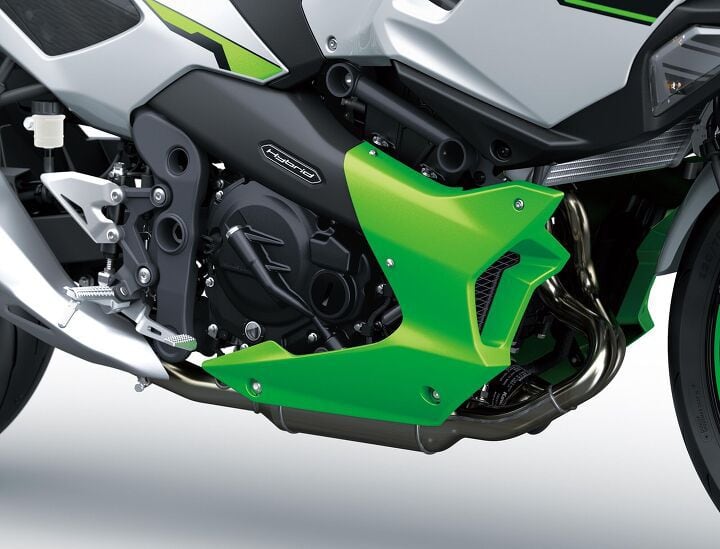
An air duct on the right-hand side of the bike flows cool air toward the battery pack. There’s a similar duct on the left-hand side, for cooling the Integrated Starter Generator. In both cases, air exits from openings in the tailsection (Kawasaki/)Riding Modes
Complexities don’t end there as Kawasaki has added ride modes to the Ninja 7 Hybrid, including all-electric EV, Eco-hybrid, and Sport-hybrid. Here’s a look at the features and performance available in each of those modes:
- EV: Designed for low-speed, short-distance riding, like in residential or restricted areas. The bike is powered solely by the electric motor, and shifts are done by the bike, with shift timing determined by the ECU. Only gears one through four are used.
- Eco-hybrid: Intended to be the best of both worlds. The electric motor is used when moving from a start, with the engine starting and coming online at around 2,000 rpm. When stopped, the engine turns off to conserve fuel. Riders can select between automatic or manual transmission settings, though the power is neutered slightly in this mode as the primary goal is fuel economy.
- Sport-hybrid: Designed for more spirited riding, making the most of the two power systems. The 451cc engine makes max power and is always on as there’s less emphasis on fuel consumption. Riders are limited to the manual transmission option only.
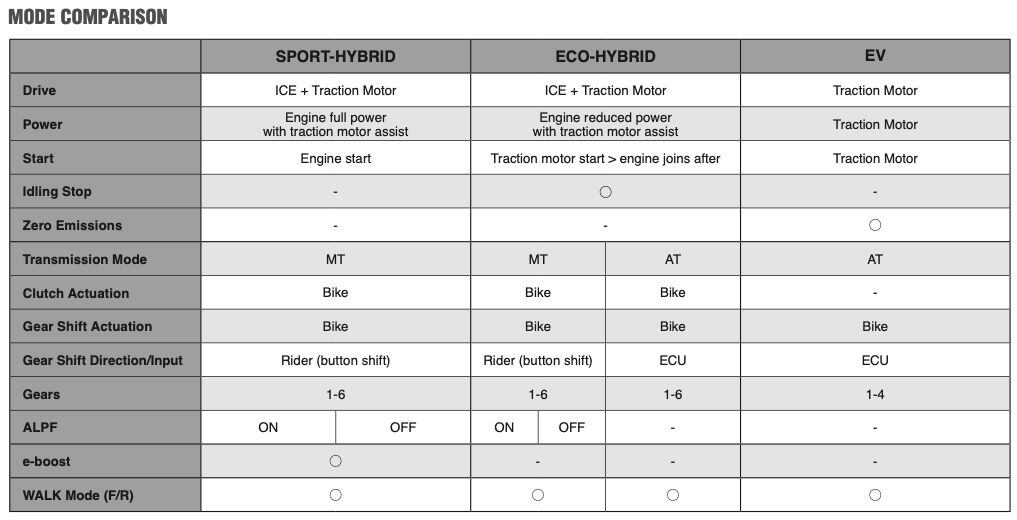
Closer look at the Ninja 7 Hybrid ride modes and what features are available in each mode. Notice that e-boost is only available in Sport-hybrid, and the idling stop function only in Eco-hybrid. (Kawasaki/)But, wait, there’s more. Or at least there’s more for very brief amounts of time, as Kawasaki has added an e-boost function, which uses battery power to increase performance for up to five seconds. The feature is only available in Sport-hybrid mode and when certain conditions are met (traveling above a certain speed, throttle is opened past a certain degree, etc.), but increases claimed power output to 68.5 hp and 44.6 lb.-ft. of torque.
The best part? Kawasaki says that, with e-boost activated, the Ninja 7 Hybrid can “initially” out-accelerate a ZX-10R from a standing start.
For slower maneuvers, there’s a walking mode with forward and reverse function. All of this is adjusted and confirmed via the 4.3-inch TFT display which is busy but well organized. Riders can also confirm settings, and check battery status or other important information through Kawasaki’s Rideology app.
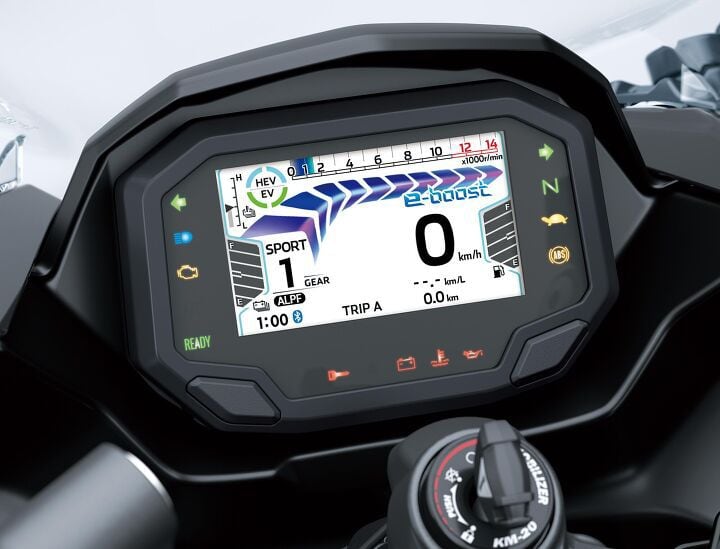
Kawasaki’s 4.3-inch TFT display is tasked with displaying an array of information. In this case, the purple e-boost bar suggests that e-boost is available. Once the button is pressed, the purple bars will start to disappear. E-boost is available for five seconds at a time, primarily for battery temperature control. (Kawasaki/)Ride Mode, Engaged
There wasn’t a ZX-10R on hand during our Ninja 7 Hybrid ride experience to test Kawasaki’s acceleration claims, but flying to Barcelona, Spain, to throw a leg over the bike did give us a chance to try the bike in an area where low-emission zones (LEZs) are already a reality—Barcelona’s ring road LEZ includes a 37 square-mile area where vehicles deemed heavy polluters are prohibited. And while that does not limit motorcycles, scooters, or most late-model family cars, it points to a future where EV and HEV models are rewarded with access to city centers or other heavily restricted areas. And there we were, on the first mass-production HEV motorcycle. Fitting.
There are more surprises as you throw a leg over the Ninja 7 Hybrid, primarily the array of buttons and the unique process for getting the bike fired up and into gear. This is not an overly complex process, but steps need to be taken in the correct order, and it takes a minute to commit that process to memory. For instance, if you plan to leave in EV mode, you must first start the bike using the engine, select EV, then click into first gear.
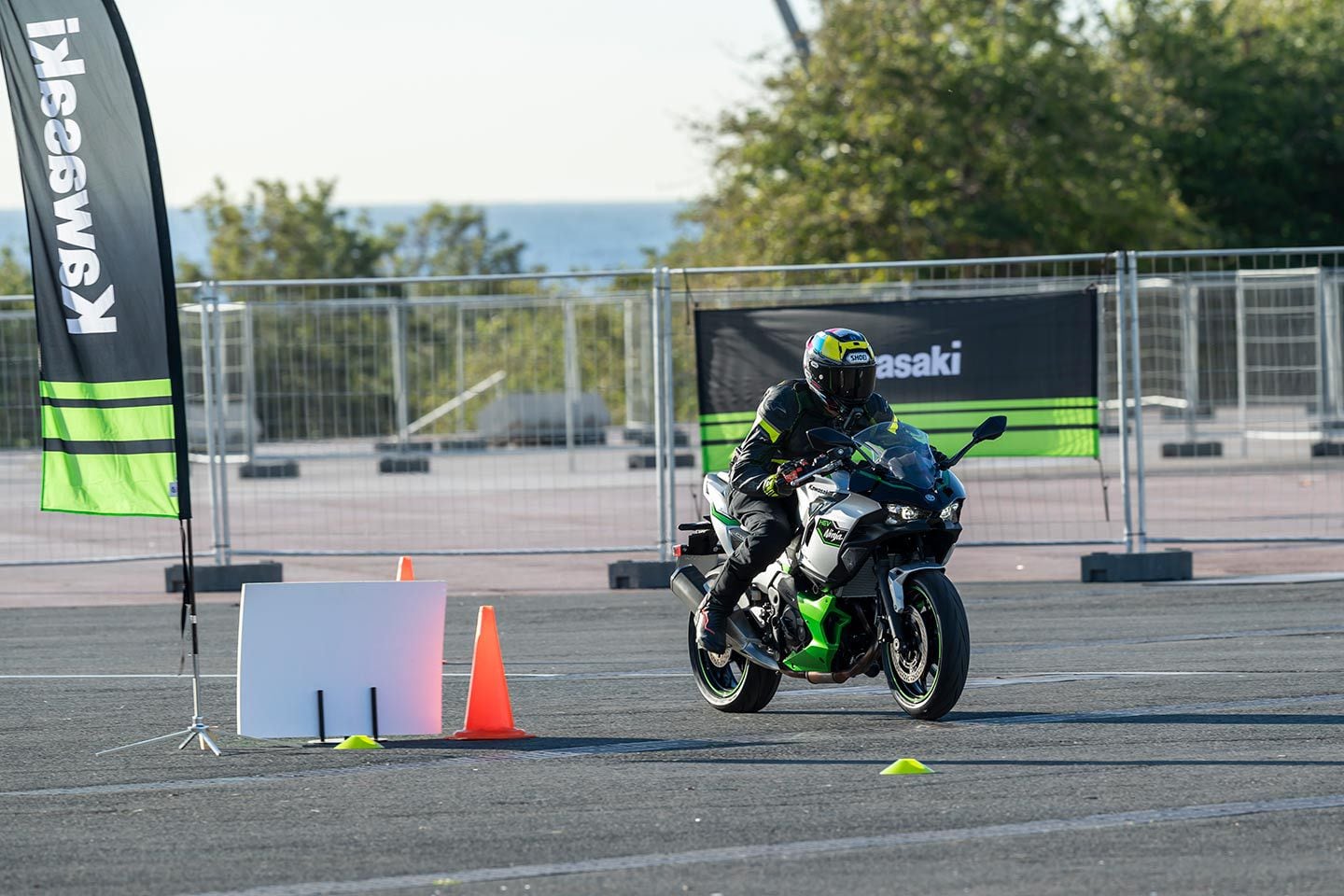
The Ninja 7 Hybrid doesn’t jump off the line with any amount of aggression until you click over to Sport-hybrid and apply e-boost. In every other mode, fuel economy is the focus. (Kawasaki/)Kawasaki recognized there would be a familiarization period and took us to the nearby Parc del Fòrum, where we could practice switching between EV and HEV modes, test acceleration, and sample both transmission options. The takeaway? It will take time to get fully comfortable with the added intricacies of the hybrid platform, and while that might deter novice riders who have enough to worry about as they set about on their riding journey, it’s not impossible for this to become second nature.
Moving in and out of Parc del Fòrum was also an example of how beneficial it is to be able to switch over to EV mode when the moment is right; there’s something about easing past people on a quiet motorcycle that changes their perception of “motorcycling.” Back at home in the US, this might look like being the person who doesn’t wake the neighborhood up when they leave early or come home late.
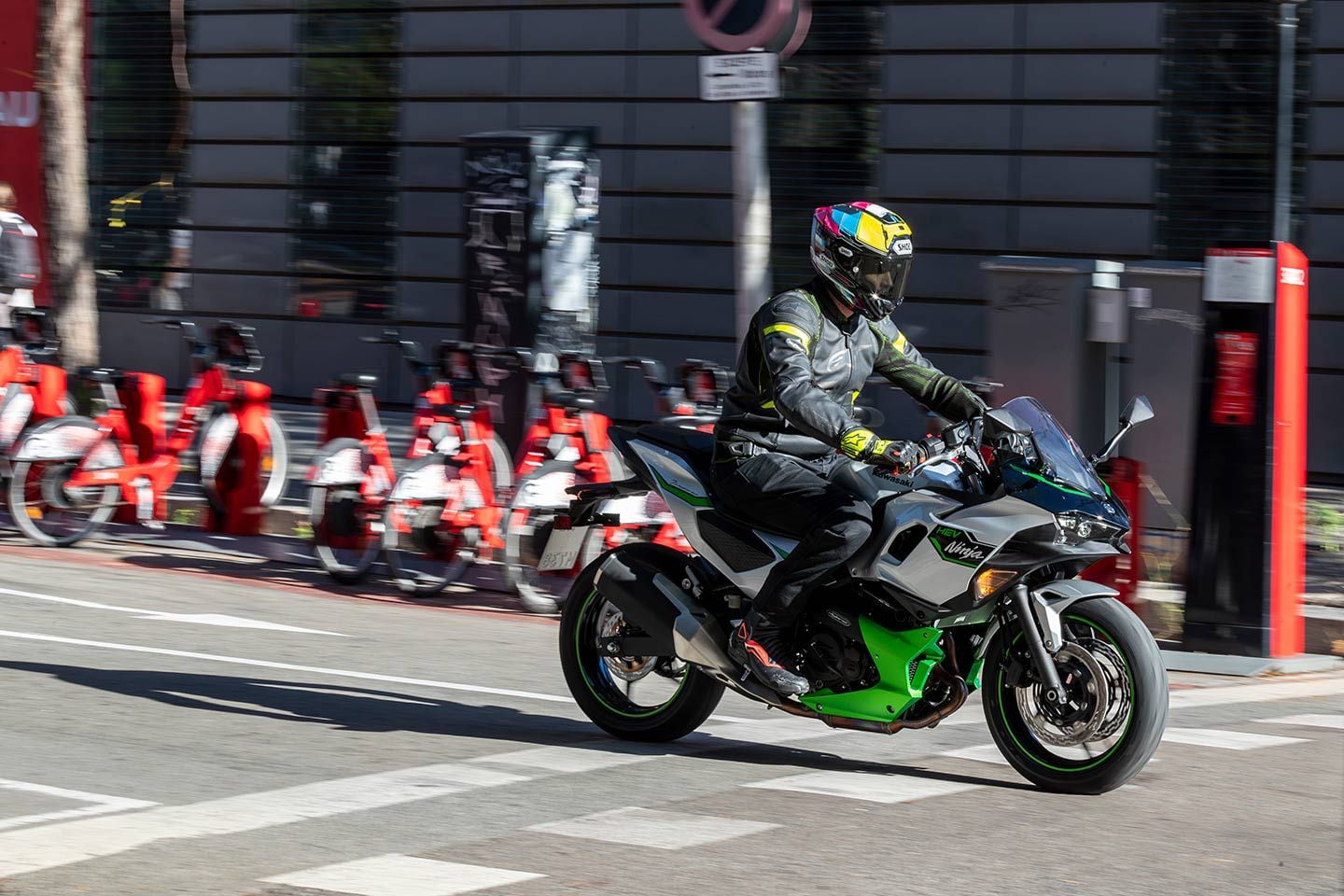
There are a lot of solutions for getting around town, especially in large city centers with vehicle regulations. Kawasaki thinks hybrids offer a unique alternative. (Kawasaki/)Range is limited to a claimed 7.5 miles in EV mode, though that number varies depending on the riding style. We rode roughly 5 miles through Barcelona’s city center without seeing the EV range drop by more than 2 miles thanks to the regenerative braking system. In normal riding conditions, the battery will go from zero to fully charged in 50 minutes, so you can expect to ride around in Sport-hybrid mode for some time if you completely drain the battery.
Top speed in EV is just under 40 mph, and while the bike does not jump off the line with the same sense of urgency as a high-voltage, all-electric bike, it’s quick enough to keep up with low- to medium-speed traffic in around-town riding.
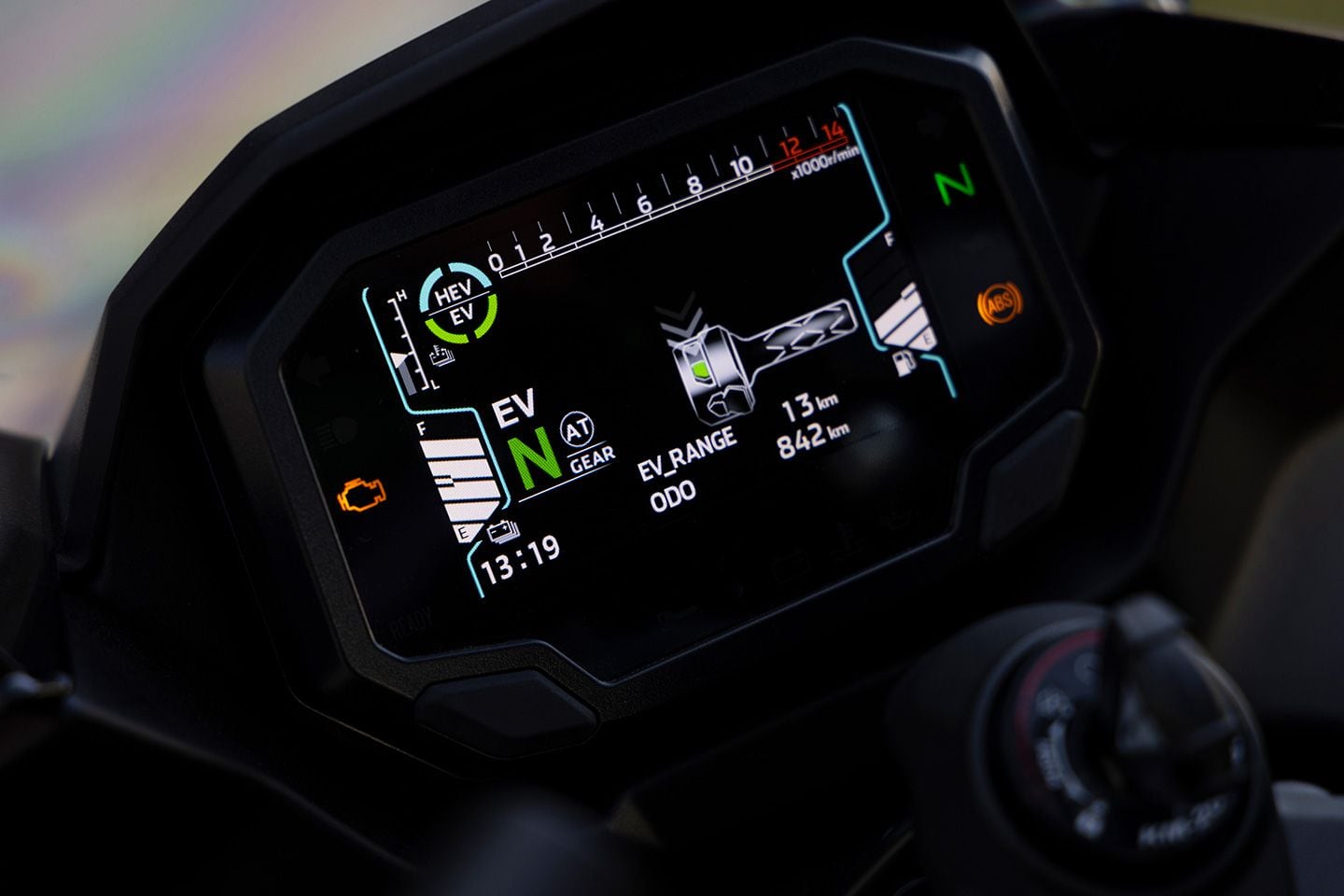
A battery level on the left side of the TFT display indicates remaining charge. Notice also the battery temp gauge in the top left, and “EV range” readout. Total range on a full charge is 7 to 10 miles, depending on ride style. It takes 50 minutes for the battery to fully charge under normal riding conditions. (Kawasaki/)Switching from EV to the Eco-hybrid offers a glimpse into the added versatility of the Ninja 7 Hybrid, as you’re no longer focused on battery range—an ever-present concern for EV owners. Emphasis is still on fuel consumption, demonstrated by the soft engine mapping and overzealous shift logic for the automatic transmission, which ensures you go to high gear almost immediately. It’s like playing eco-Monopoly: “Go directly to [high gear]; do not [speed], do not [burn gas].”
Switching to the manual transmission setting enables you to control shifting. Although, admittedly, we’d prefer if you could be in AT mode and temporarily override the computer. In current trim, hitting the shift paddles automatically moves you to the manual transmission setting. That continues to be the case until you select AT again. Again, there’s a lot of button pushing here.
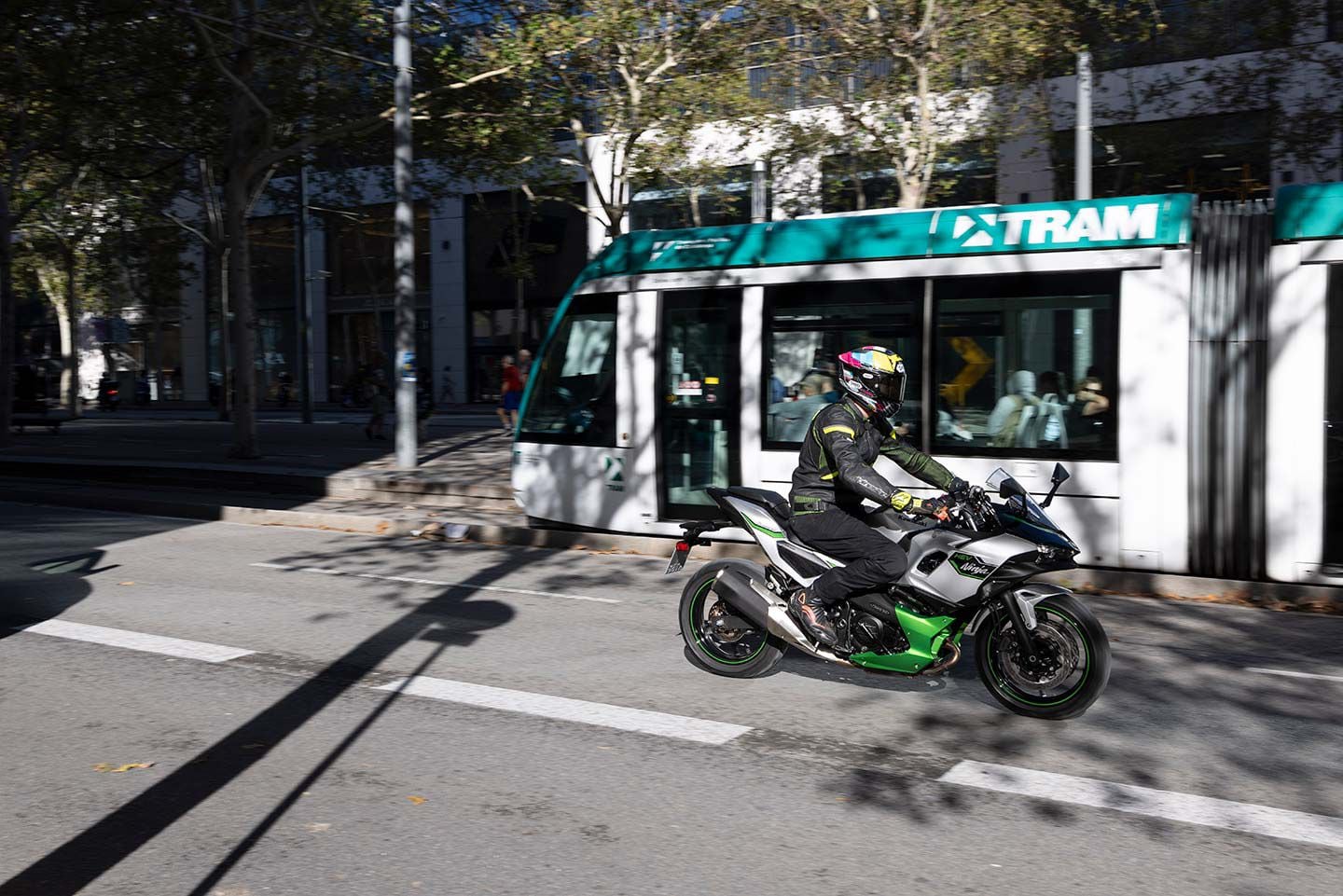
Engineers had to make some compromises when it came to things like wheelbase, but outside of the large tail and extended swingarm, the Ninja 7 Hybrid looks like a traditional motorcycle. Riding position is upright and relaxed, especially considering the sportbike styling. (Kawasaki/)The handoff between electric motor and the parallel-twin engine is surprisingly seamless and noticeable more from an audible standpoint than anything else. Given that the transition happens at around 2,000 rpm, you’re almost guaranteed to be upright and cruising at low speeds when it happens, so no need to worry about upsetting the chassis as the bike switches to the internal combustion engine.
Even if the bike were to transition while at lean, Kawasaki’s engineers did a good enough job with the software that this wouldn’t be an issue. Of all the things that stand out most on the Ninja 7 Hybrid, it’s how seamless the electronics work, from automatic shifts to the EV/HEV handoff. The same goes for throttle application and regenerative braking system; everything feels as it would on a traditional motorcycle. Nothing interferes with your experience.
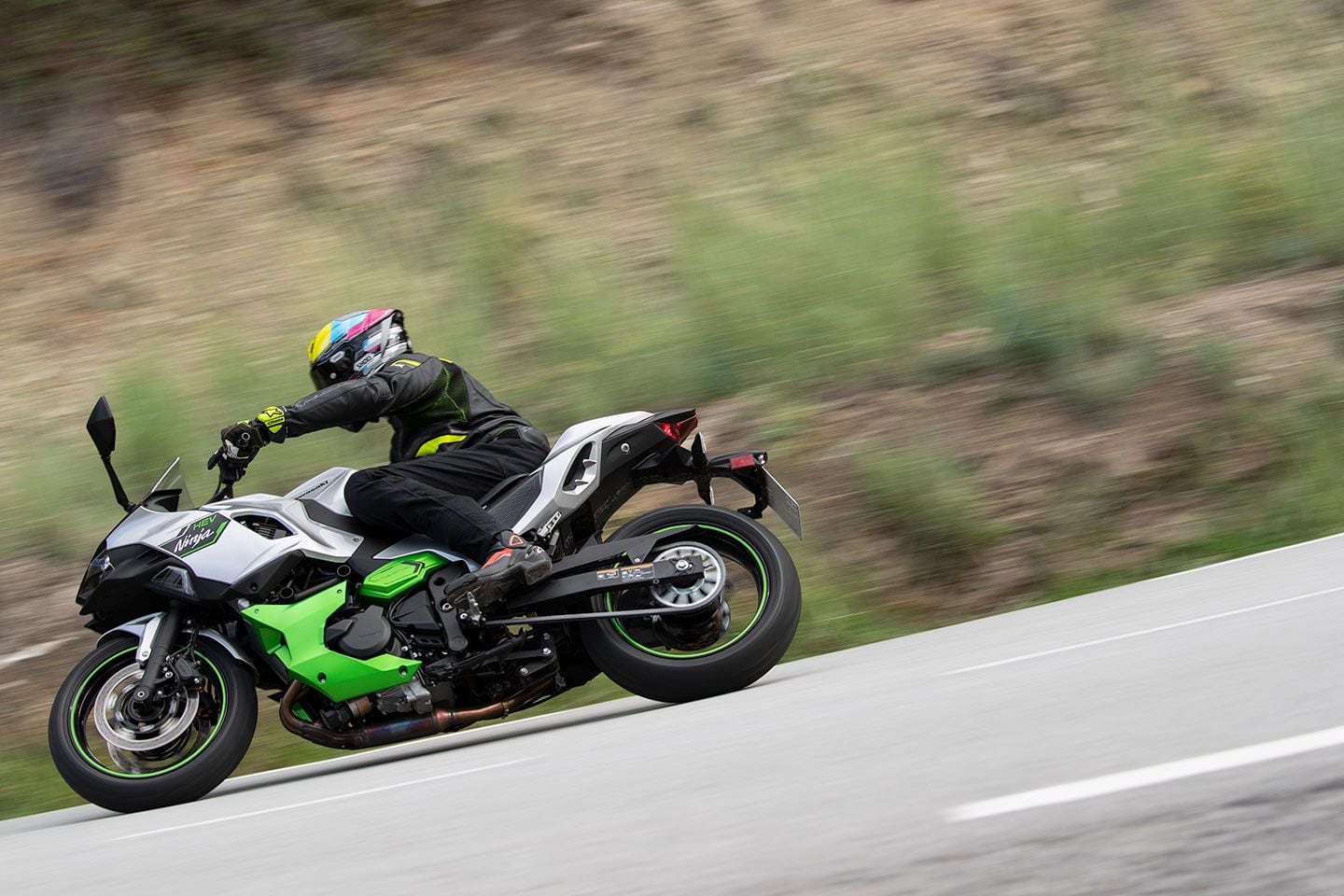
Kawasaki says it was important for the first hybrid model to have a sportbike look and wear the Ninja name. The Ninja 400 is one of its bestselling models and people recognize the Ninja name, which helps draw attention to this model. (Kawasaki/)If all of this makes it sound like riding the Ninja 7 Hybrid is reminiscent of riding a traditional motorcycle, that’s because, well, it is. That’s especially true when you toggle over to Sport-hybrid and put Kawasaki’s 451cc engine to work. The most fuel-efficient approach? Maybe not, but it’s hard to argue with the sporty personality of this latest parallel twin, which willingly pulled us through some of the best two-lane roads lining Barcelona without feeling like it needed to come up for air, and only a hint of vibration to remind you that this is a small-bore machine at its core.
That performance is, of course, without using the e-boost feature, which propels the Ninja 7 Hybrid up to speeds the Ninja 400 could only dream of for up to five seconds. The only problem is that activating e-boost requires you to be aware of its status and have your right thumb on the e-boost button; this takes extra attention and is not something we wanted to be focused on while hunting apexes in the canyons or managing traffic, meaning we used it less than one might expect. There’s probably a reason you don’t see something similar in today’s latest hybrid automobiles.
That said, e-boost makes sense when you’re on the freeway and need extra speed to accelerate past a car. The five-second bursts are just long enough to feel some excitement, without overheating the battery. Perhaps the best example of the e-boost performance level is its ability to throw you back in the seat when used from a standing start.
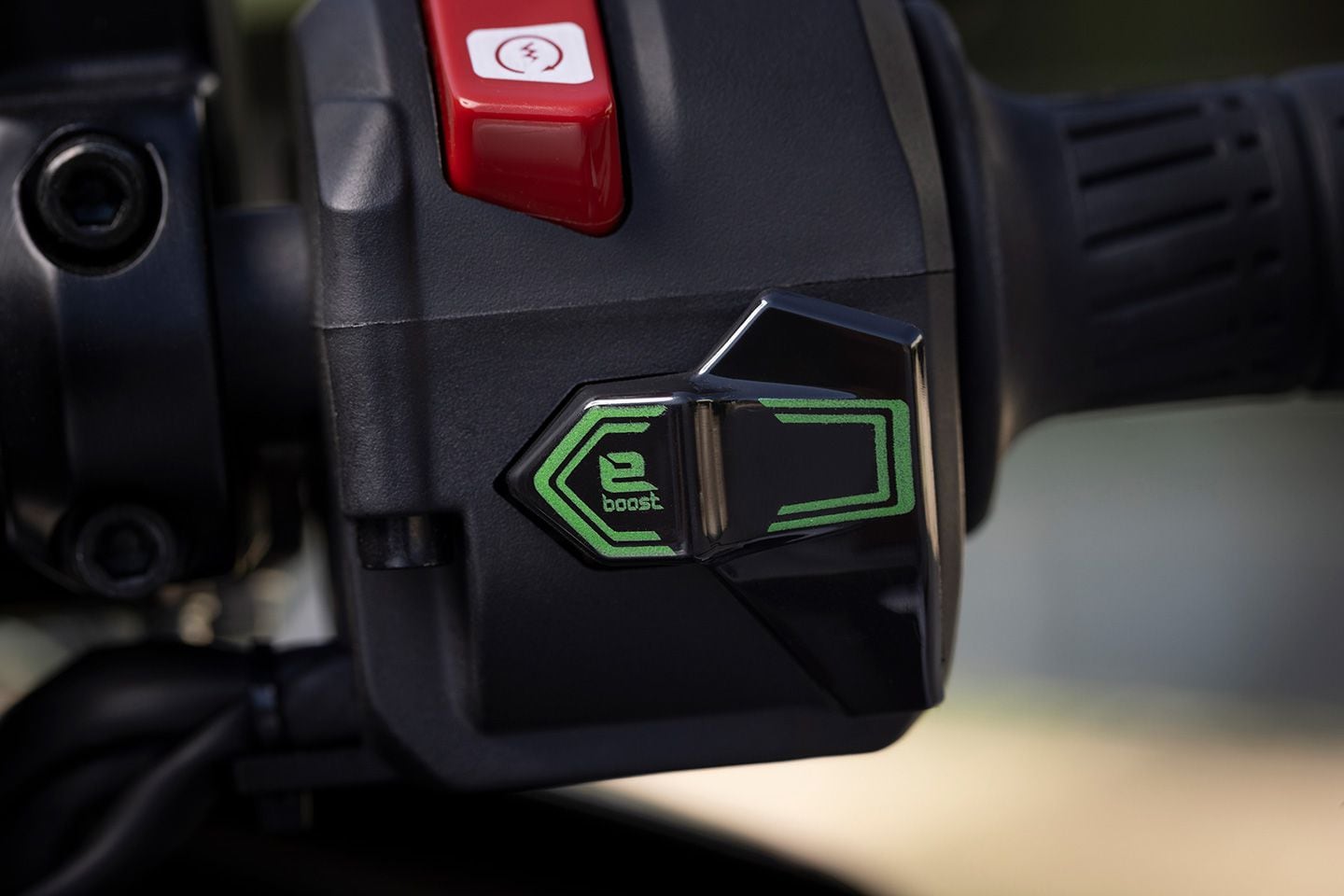
The e-boost button on the right side of the handlebar is there when you need a little extra power. Mind you, e-boost only works for five seconds at a time and only in Sport-hybrid mode. It doesn’t work at aggressive lean angles, to ensure there are no midcorner surprises. (Kawasaki/)As for range, we rode in a variety of conditions over our two days on the bike, and averaged roughly 57 mpg, according to the bike’s onboard computer. That includes countless dragstrip-style launches and a spirited afternoon in the canyons, but also a full morning of putting through the city. Typical riding for a bike like this? Not exactly, so we’ll save further fuel economy comments for future testing.
What we can say is that, based on World Motorcycle Test Cycle (WMTC) testing, which measures fuel consumption and emissions in motorcycles, the bike is rated at 58 mpg in Sport-hybrid mode, and 64 mpg in Eco-hybrid mode.
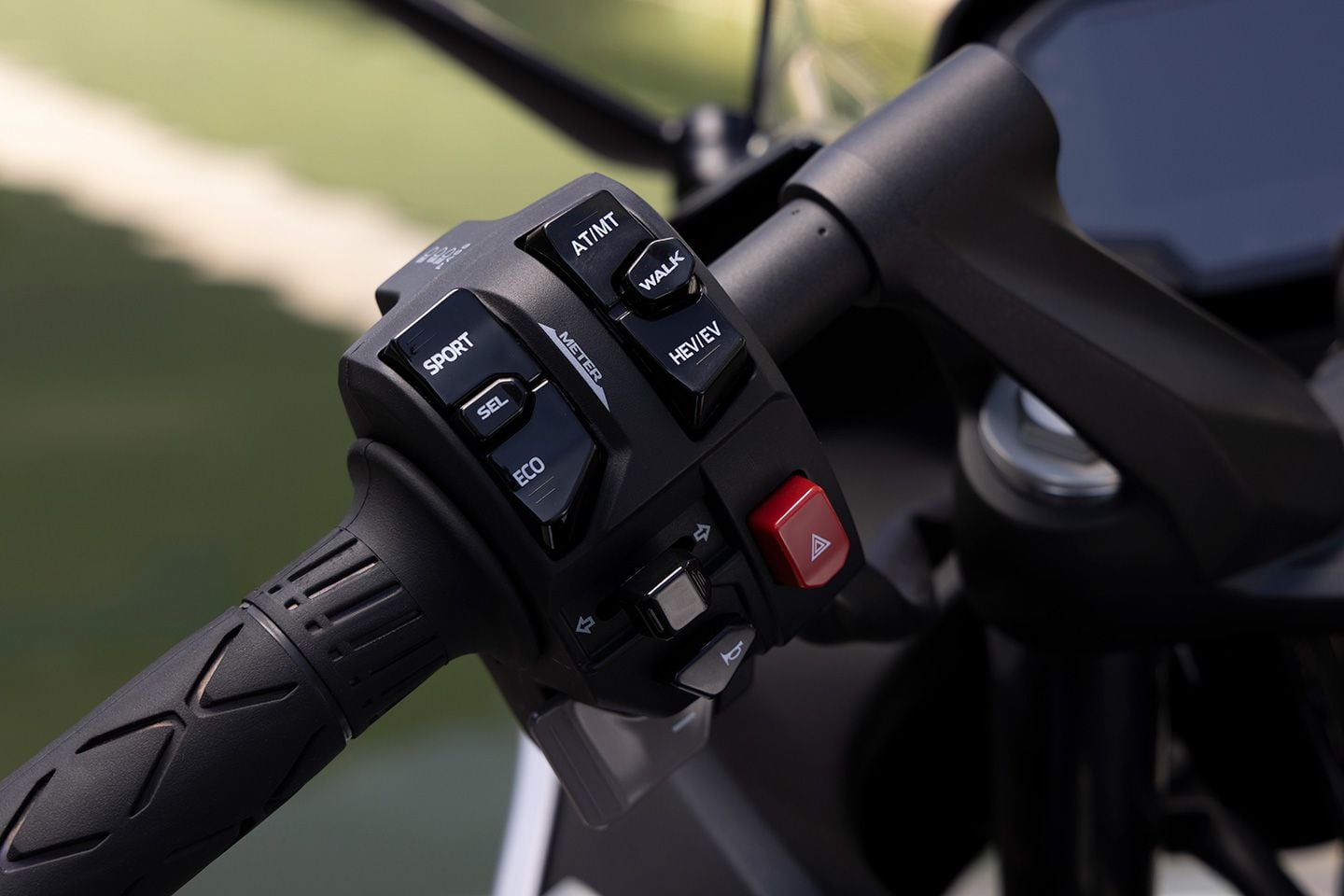
Switch cluster on the left-side handlebar has all of the buttons for switching between ride modes, automatic or manual transmission, and hybrid or electric power. Buttons also enable you to activate Walk mode and navigate vehicle settings through the TFT display (Kawasaki/)Handling
While packaging and software were a major focus for Kawasaki, handling was also a priority—the whole “three bikes in one” doesn’t hold much weight if the Ninja 7 doesn’t encourage riders to get out of the city and actually ride. Fortunately, the team has done a good job managing the added heft and larger dimensions, creating a bike that doesn’t wave the white flag on a winding section of asphalt.
That’s not to say the Ninja 7 handles like a Ninja 400 or Ninja 650. Those bikes tip into a corner and hold their line with absolute ease, whereas you need to be a little more intentional with steering inputs here. A longer wheelbase means the bike tips in slower, then falls into the corner all at once. You also need to use a little extra input midcorner to keep the bike on your intended line.
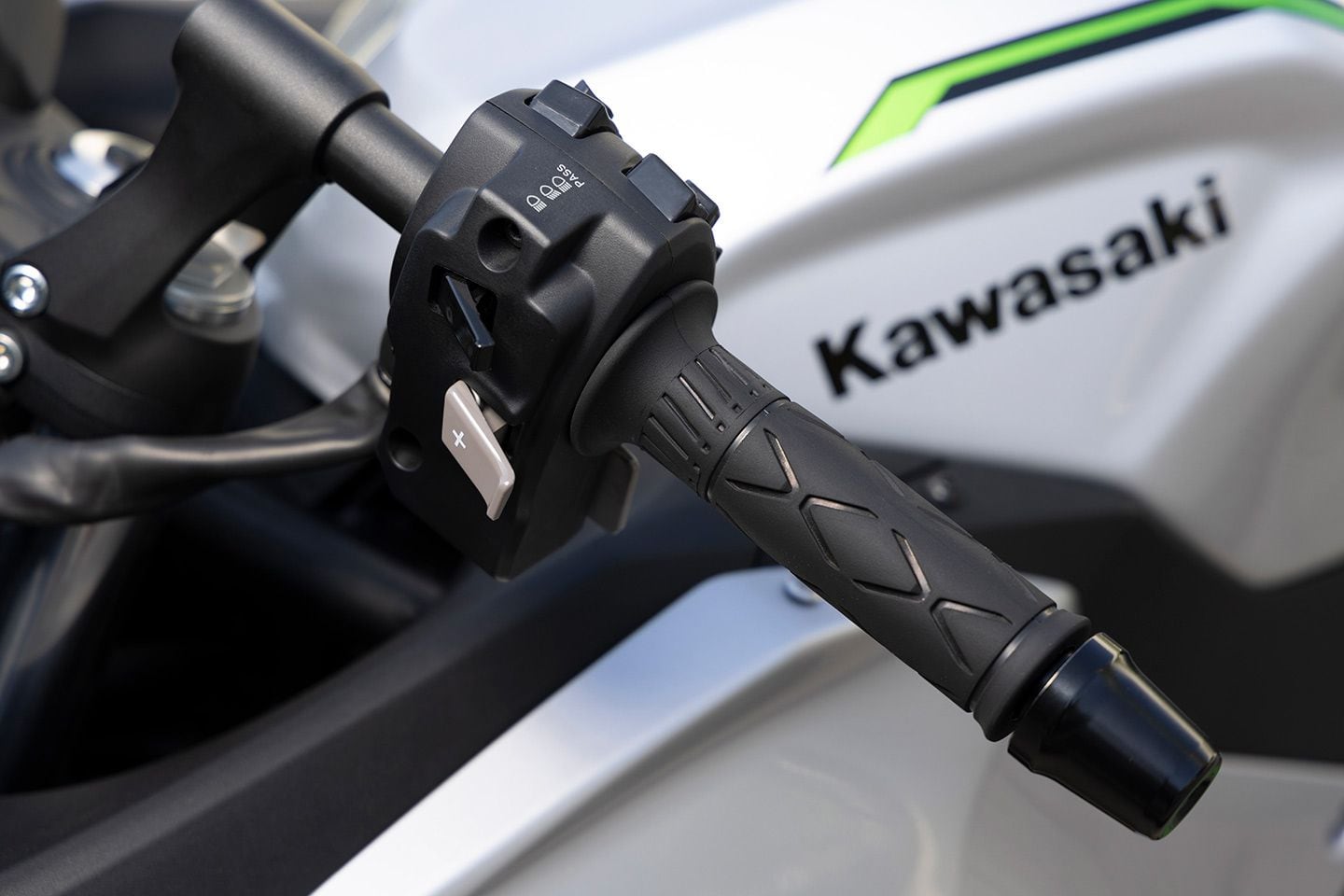
Shifts are easily managed by paddle shifters on the left-side handlebar. The throttle has to be open for upshifts, and closed for downshifts. (Kawasaki/)It’s not a tiring workout though, and again, you’d be surprised at how well the Ninja 7 hustles through a tight section of road. Maintaining a low center of gravity helps, as do the wide handlebars. You sit upright and relaxed, but with enough weight over the front of the bike to attack a corner should you please. Another big help here is the stiffer suspension and reinforced frame, which do an admirable job of keeping the Ninja 7 from wallowing around as the pace picks up. This is still an enjoyable motorcycle to ride quickly.
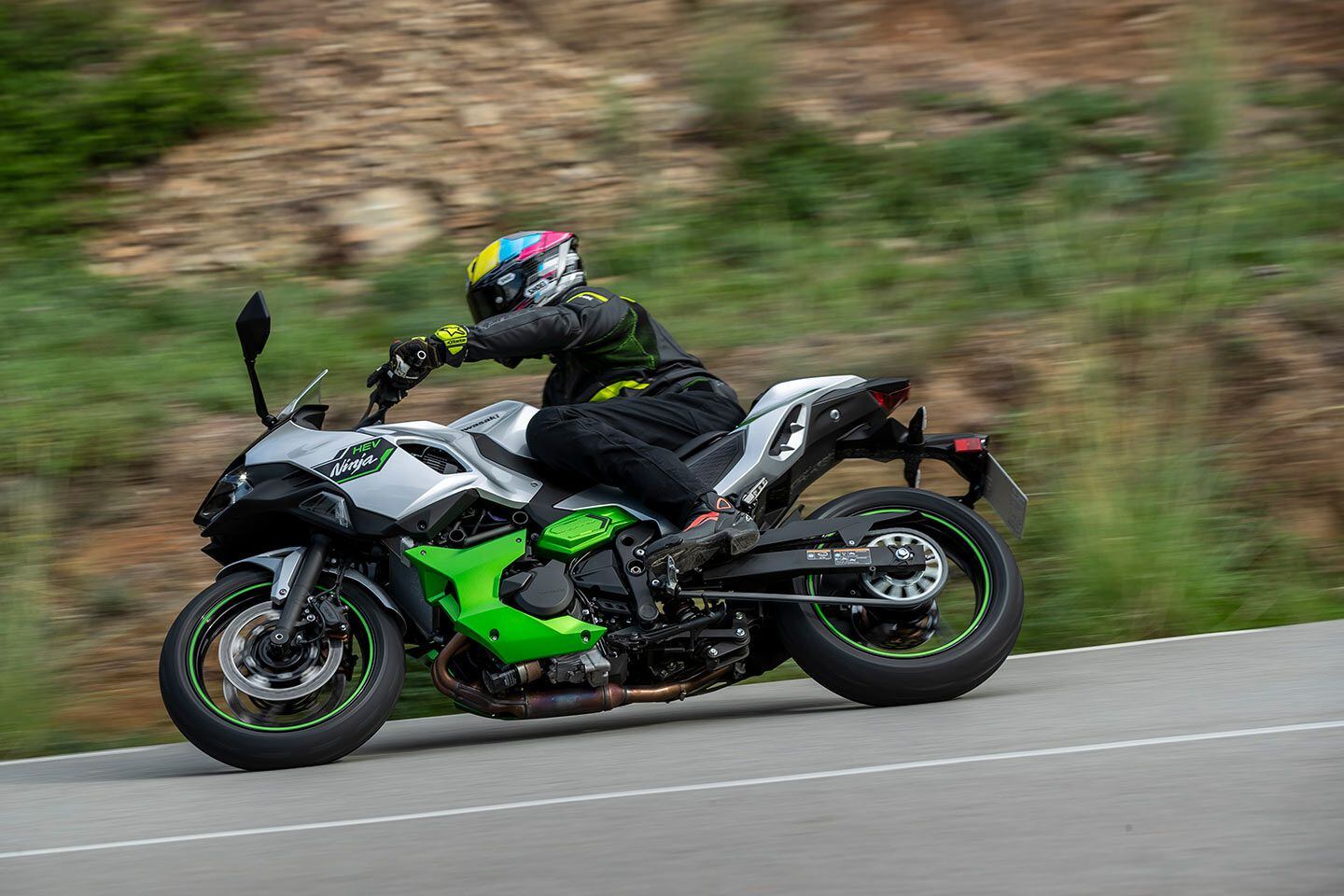
The Ninja 7 Hybrid’s long wheelbase and added weight mean the bike is not as nimble as a Ninja 400, but it still hustles down a tight mountain road. (Kawasaki/)Final Thoughts
While the Ninja 7 Hybrid is Kawasaki’s first HEV, it won’t be its last. Kawasaki has already said that it’s working on the next generation of hybrid motorcycles across different platforms. In that regard, the Ninja 7 Hybrid is something like a taste of what’s to come.
Is it a good first taste? We think so. People might expect a first-gen hybrid motorcycle to have teething issues and want to stay away, but there are none here. Fueling is smooth, there’s no hesitation as the bike transitions from electric motor to gas engine, the automated manual transmission works well, and despite being a little heavy, the bike is still plenty of fun to ride when the roads tighten up.
Our only concern is with the added complexity that comes with the many ride modes, buttons, and features you might want to adjust while riding. Owners will probably adapt to that, but it’s something to consider. Perhaps future models will feel a little more “turn-key.”
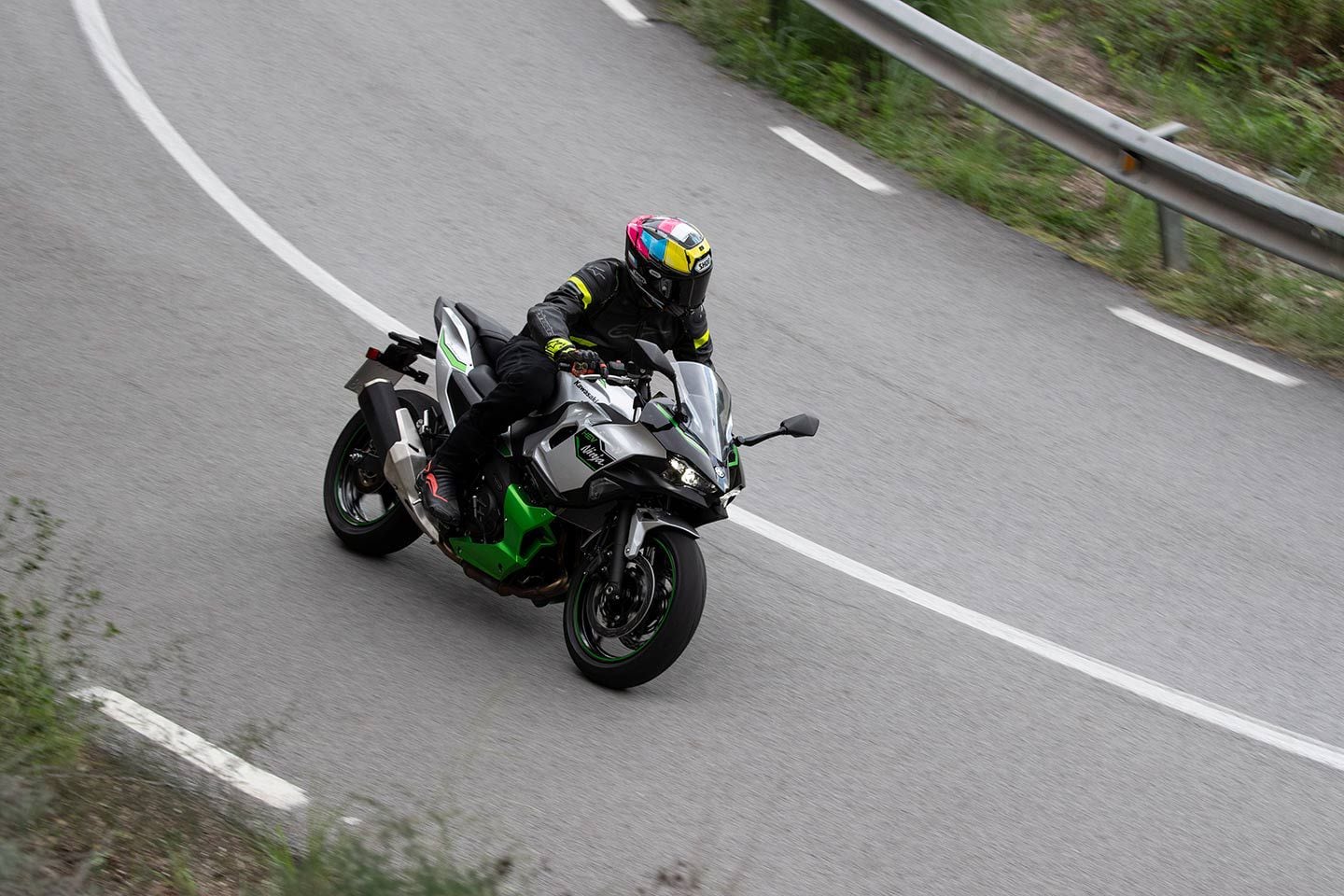
The beauty of the Ninja 7 hybrid is in its ability to cruise through town on electric power in the morning, and then rip through the canyons in the afternoon without needing to be plugged in or gassed up often. (Kawasaki/)None of this takes into account price, as Kawasaki has yet to formally announce the Ninja 7 Hybrid for the US market, or suggest a price target. The reality is there are many affordable and economical bikes already on the market (e.g., Honda NC750X), thus sales success will depend on people who feel the benefits outweigh whatever the added cost might be. That may be a small group, smaller even given there aren’t any Zero- or Low-Emissions Zones in the US yet, and given that motorcyclists in the States are motivated more by passion than fuel economy.
Early adopters and those who simply appreciate the tech will, however, be rewarded by a bike that not only writes a new chapter in motorcycling, but does so in a way that isn’t too far removed from riding as we know it.
2024 Kawasaki Ninja 7 Hybrid Specs
MSRP: N/A Engine: DOHC, liquid-cooled, 4-stroke parallel twin Displacement: 451cc Bore x Stroke: 70.0 x 58.6mm Compression Ratio: 11.3:1 Motor Type: Liquid-cooled, interior permanent magnet synchronous Battery Type: 48V Li-ion Transmission/Final Drive: 6-speed/chain, return, electronically actuated, hydraulic automated manual transmission Claimed Horsepower: 68.5 hp @ 10,500 rpm (Sport-hybrid w/ e-boost) Claimed Torque: 44.6 lb.-ft. @ 2,500 rpm (Sport-hybrid w/ e-boost) Fuel System: DFI w/ 36mm throttle bodies Clutch: Wet, multiplate, automated Engine Management/Ignition: Digital Frame: Trellis, high-tensile steel Front Suspension: 41mm telescopic fork; 4.7 in. travel Rear Suspension: Single shock, spring preload adjustable; 4.5 in. travel Front Brake: 2-piston calipers, 300mm discs (w/ ABS) Rear Brake: 2-piston caliper, 220mm disc (w/ ABS) Wheels, Front/Rear: 5-spoke; 17 in./17 in. Tires, Front/Rear: 120/70-17 / 160/60-17 Rake/Trail: 25.0°/4.1 in. Wheelbase: 60.4 in. Ground Clearance: 5.9 in. Seat Height: 31.3 in. Fuel Capacity: 3.7 gal. Claimed Weight: 500 lb. Contact: kawasaki.com 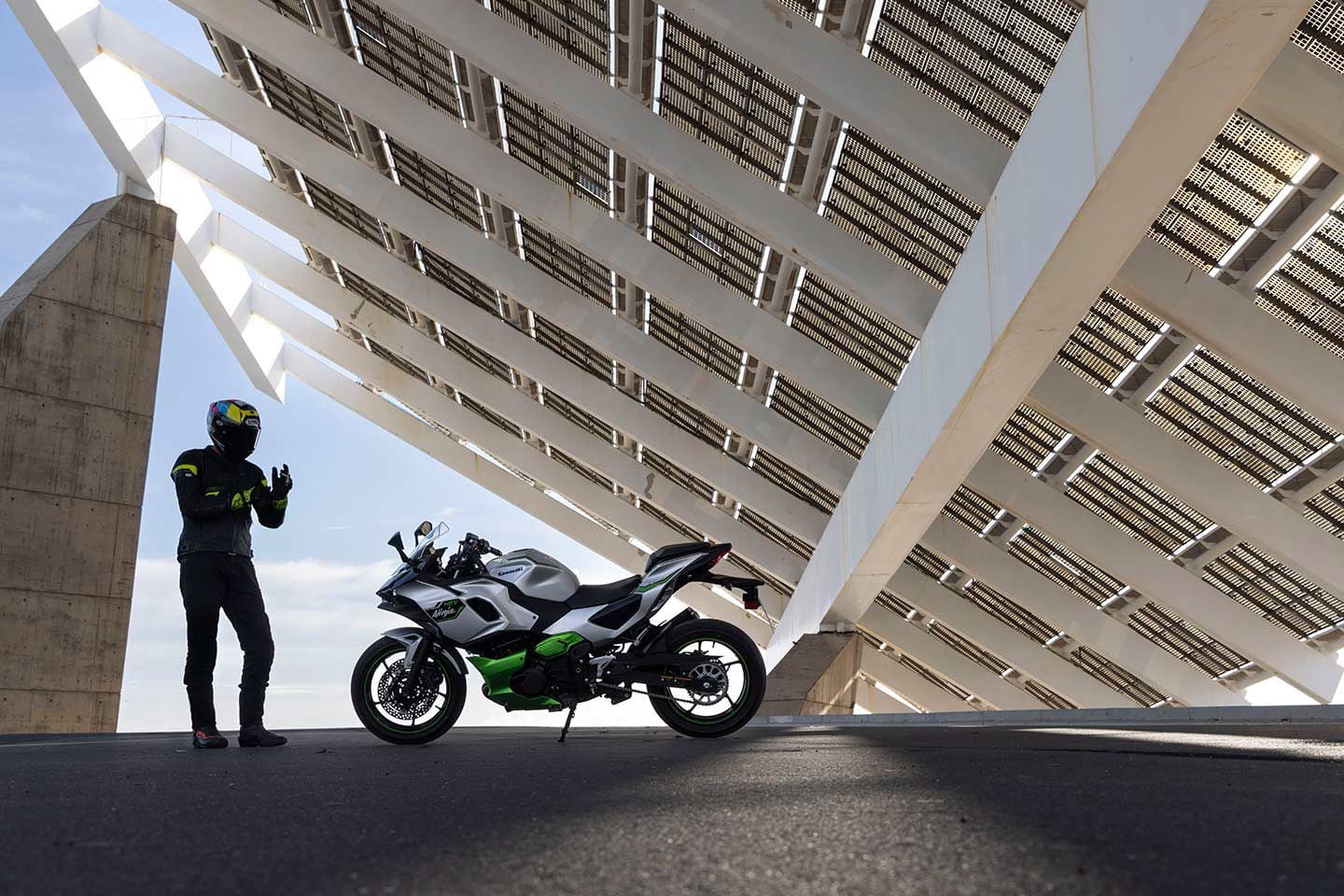
2024 Kawasaki Ninja 7 Hybrid gear bag. (Kawasaki/)Gearbox
Helmet: Shoei X-Fifteen
Jacket: Alpinestars GP Plus R v3 Rideknit
Gloves: Alpinestars GP Tech V2
Boots: Alpinestars SMX-6 V2 Drystar
-
 1
1
-
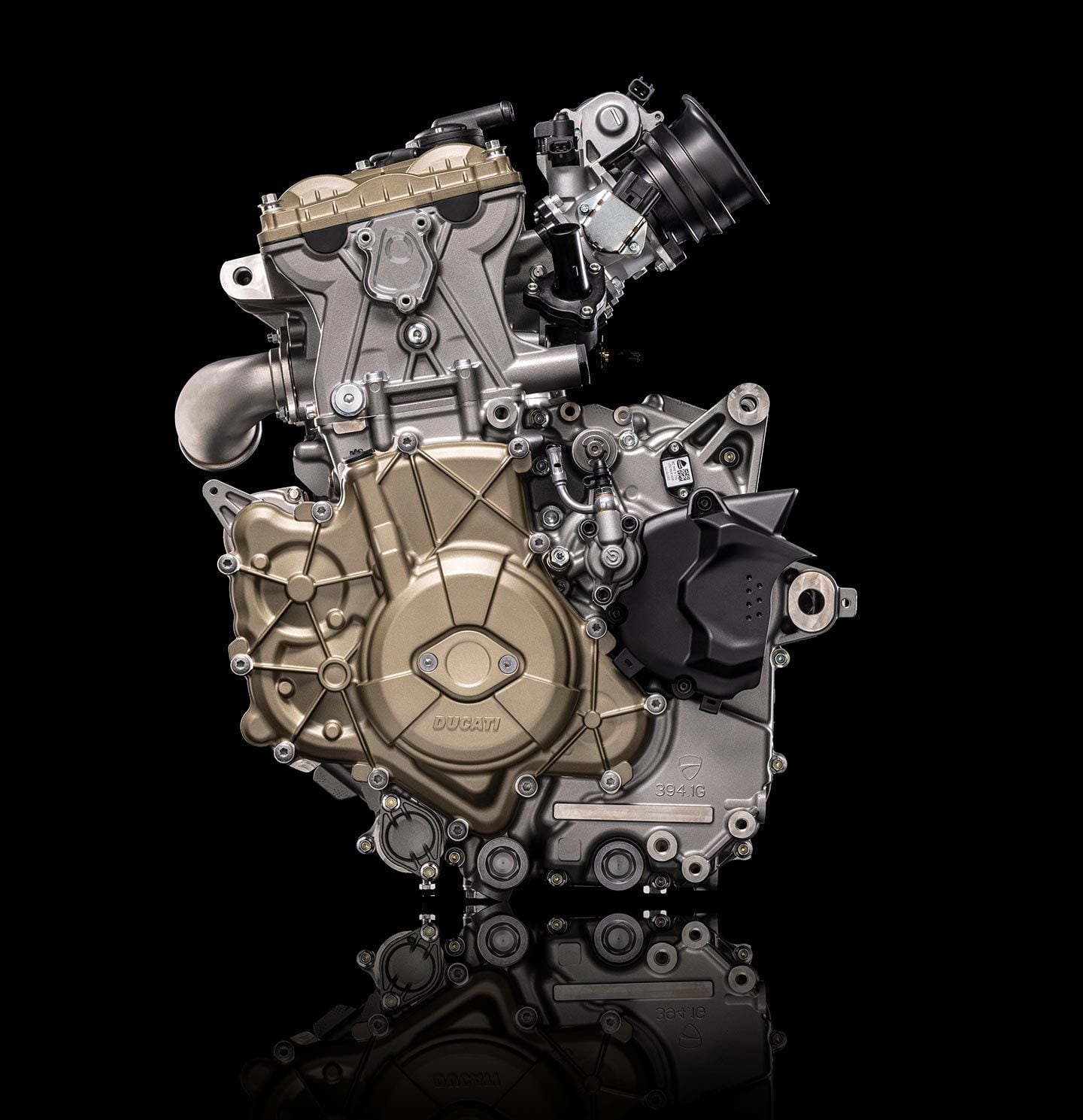
The crankcase is split vertically on Ducati’s Superquadro Mono. (Ducati/)Reader Yash comments that singles require a “heavy flywheel to improve tractability [and] eliminate rough idle.
“…it takes a heavy toll on acceleration and top speed.”
Yash is right that these are serious concerns, but there are many thousands of successful modern singles—four-stroke MX engines are prime examples. And, yes, it’s possible to provide too little flywheel, as was the case in the first year of Supermono racing, when big singles so often stalled in slow corners—sometimes to the point of being comical. Since then the sophistication of ECU programming has corrected this situation.
As to the “heavy toll on acceleration,” Yash is right again. When the late C.R. Axtell tested the Cosworth Norton on his dyno, he said it was “the slowest-accelerating engine I’ve seen.” It was a parallel twin (both pistons moving together) with both a massive central crank flywheel and a pair of hefty primary balancer shafts carrying eccentric weights.
In the case of Ducati’s Superquadro single, you’ll notice that the amount of flywheel mass on the crankshaft itself is quite limited. The designer has taken care to make crank and balancer rotating masses add up to a workable and appropriate total.
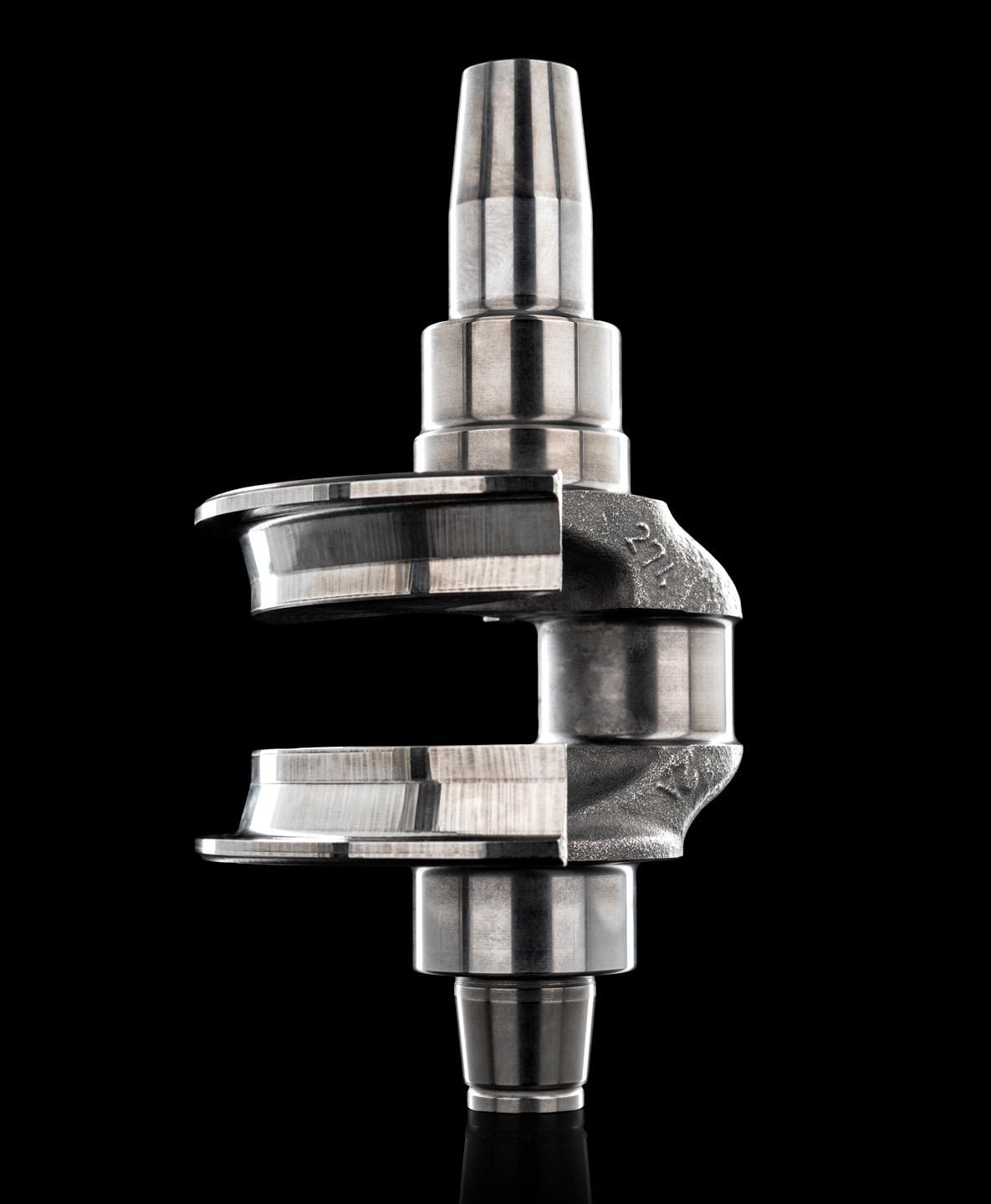
Flywheel mass on the Superquadro’s crankshaft is fairly little. (Ducati/)Loss of top speed is also listed by Yash as one of the ills of big singles. Hmm, well, in past conversations with former Harley-Davidson racing manager Dick O’Brien and “Mr. Superbike” himself, Rob Muzzy, I was told that neither man had ever had much luck with light cranks and top speed at Daytona. In their (extensive) experience, a certain level of crank mass was essential to achieving high top speeds.
Joe Broussard writes, “I would love to see detailed images of just how Ducati makes, [and] uses, their desmodromic system.”
On the internet are to be found many images and even engineering drawings of Ducati desmo systems, but the basics are that each valve is opened by a normal-looking cam lobe, operating through a normal-looking short pivoted finger follower. The interesting part is what closes the valve. A roughly L-shaped closing rocker is pivoted in the middle and forked on the valve end to pull up against a round collar fixed to the end of the valve stem (by press-fitted collets for which there is a special “squeezer” for installation). The other end of the closing rocker bears against a mostly circular closing cam of rather large diameter, providing motion that is quite precisely complementary to that of the normal-looking opening cam.
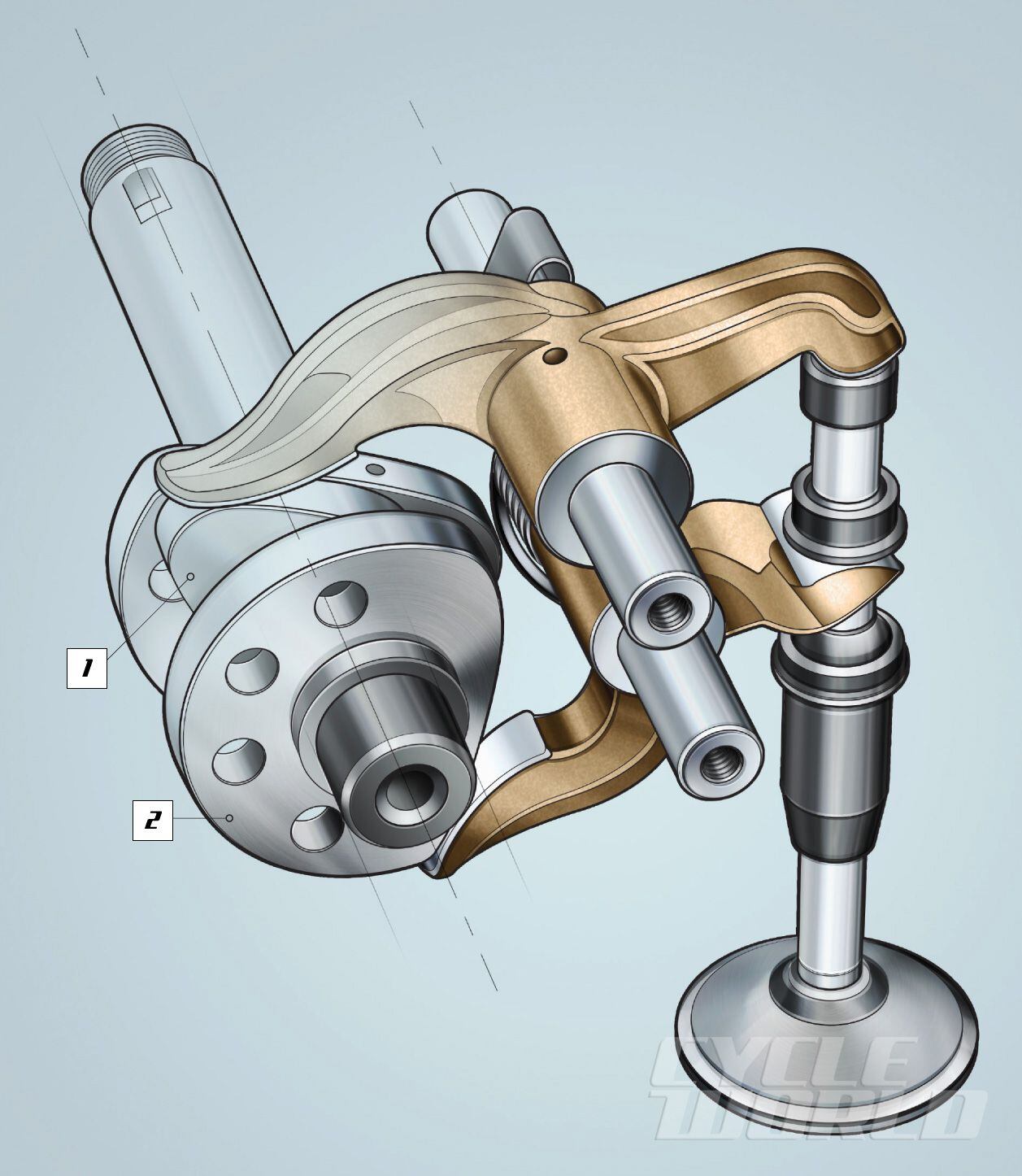
The opening cam (1) is conventionally shaped while the closing cam (2) has a flat spot to allow the valve to be opened.Mr. Broussard also speculates that springless desmo operation may give Ducati a significant power advantage.
Although it seems intuitively right that the added resistance of valve springs must consume a bunch of power, giving Ducatis an edge in acceleration and top speed, I believe this to be an illusion created by having manually rotated assembled engines during timing checks. Valve spring engines are stiff! We know also that valve train friction versus rpm displays a U-shaped curve: Friction is high at idle and low revs because there is not enough sliding velocity to generate full-film lubrication. As the engine revs into its working range, valve train friction falls. Then at higher revs it rises again because of increased power being consumed in more rapidly shearing oil films—just as happens between pistons and cylinders or between crank journals and their plain bearings.
Ducati is winning races now but recall that sixth, seventh, and eighth places were regarded by many as “reserved for Ducati” in its doldrum years after Casey Stoner’s 2007 World Championship. Did desmo valve drive somehow stop being an advantage in those years?
Also, if we theorize for discussion’s sake that desmo gives Ducati a 5 percent horsepower advantage (15 hp!), we must ask how the pneumatic-valve competition handle the resulting 11,000 watts of extra valve train friction (there are 746 watts in 1 hp, so 15 x 746 = 11,190). Do all the non-Ducatis have hulking oversized oil coolers? Those 11,000 watts are equivalent to the heat given off by the red-hot elements of 15 kitchen toasters. Do they regularly suffer scoring and seizure in their valve trains?
Reader “Two Dakars” writes, “…please explain how they only need a single spark plug at 116mm bore when the Husqvarna 701/KTM 690 has a twin [spark] plug arrangement for a 105mm bore?”

KTM’s 690cc LC4 single uses twin spark plugs; why doesn’t the bigger-bore Superquadro Mono use them? (KTM/)In answer, I must say that I was impressed by the apparent ease with which Ducati kept its 90-degree twin Superbikes competitive during the years of enlargement during which the original 851 (92mm bore) swelled to 1,199cc (112mm bore). Meanwhile, in the early years some Japanese Superbikes encountered trouble in making bigger-bore engines burn as well as previous ones of smaller bore. When I asked Ducati engineer Claudio Domenicali (he is today Ducati’s CEO) why this difference existed, he replied, “I cannot speak for the Japanese, but in our own case we vary intake downdraft angle and runner diameter to achieve the desired results.”
The desired results were sufficient mixture turbulence during combustion to rapidly shred and widely distribute the flame initiated by the ignition spark. It is not the speed of combustion itself which burns from the ignition point out to the cylinder wall, but rather this turbulent shredding and transport process, and it achieves rapid combustion by greatly increasing the area of flame surface. Typical speeds for this are in the range of 50 to 200 feet per second. For the Superquadro’s 116mm bore, flame travel distance is half of this, or about 2.3 inches. At a 150 feet/second effective flame speed and 9,750 rpm, this would require 0.00153 second, which is one quarter of a crank revolution, or 90 degrees. Because combustion is roughly evenly divided on TDC, this would permit ignition at 45 degrees BTDC. This is just an example—I don’t yet know what ignition timing the SQ single requires.
Please bear in mind that combustion in engine cylinders is not, as so often described, an “explosion.” TNT, a high explosive first used in the Russo-Japanese War of 1905, reacts at 22,000 feet/second, while dynamite is a relative slowpoke at 8,860 feet/second.
While there are cases of engine manufacturers having to add one or two extra spark plugs per cylinder to either speed up ignition or eliminate regions of high emissions generation, Ducati appears to have the experience and methodology to achieve the combustion it wants without them.
-
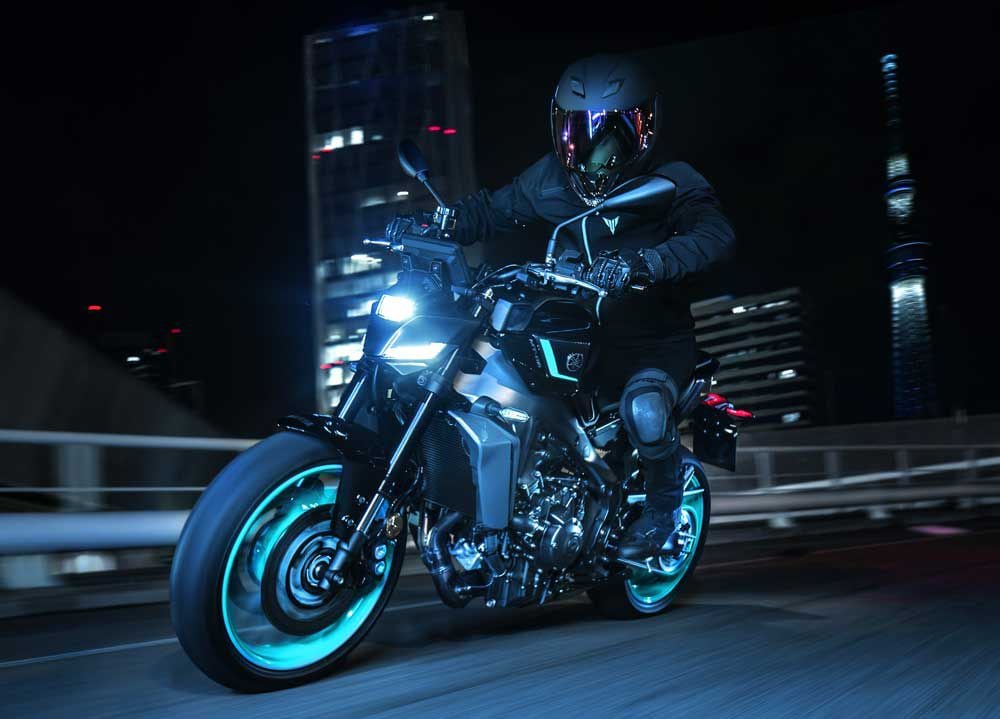
Yamaha-MT09-Action.jpg | The 2024 Yamaha MT-09 sharpens the aggressive look and tweaks the ergonomics to match. (Yamaha/)Hard to believe it’s been a decade since Yamaha’s FZ-09 triple burst into the naked segment, but here we are with Team Blue marking the since-renamed-MT-09′s 10-year anniversary. Ten years is a milestone for any model, but for 2024 the MT-09 is getting only an evolutionary update, with bolder styling, a revised riding position, and enhanced electronic features.
Yamaha basically left the liquid-cooled CP3 engine just as it was, with the same lightweight aluminum frame suspended via KYB components front and rear, and enhanced by a full-featured electronics package. Still, the new refinements are fairly comprehensive, covering lighting, ergonomics, electronics, brakes, and more.
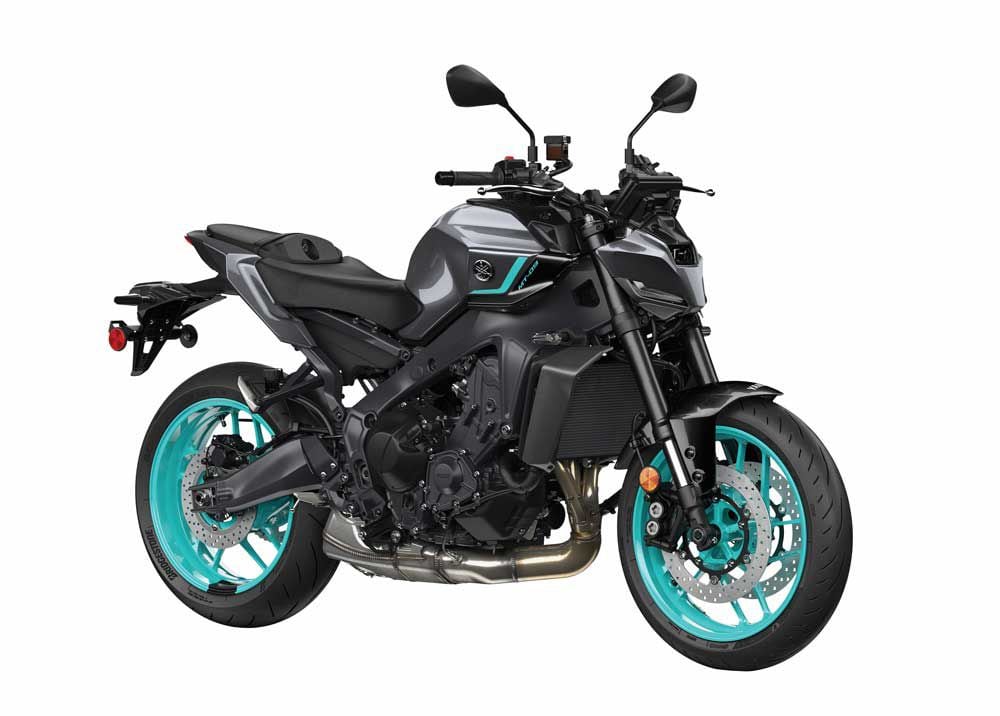
“Bolder styling” includes a new LED headlight, revised seat, and a reshaped fuel tank. (Yamaha/)We’re sort of relieved Yamaha left well enough alone on the hugely entertaining 890cc inline-triple; we never failed to get a grin out of what we called “one of motorcycling’s great engines” after the last update in 2021. In fact, Yamaha doubled down on that quality this year, adding a new two-duct intake design with acoustic amplifier grilles atop the fuel tank to magnify the CP3′s tasty induction honk.
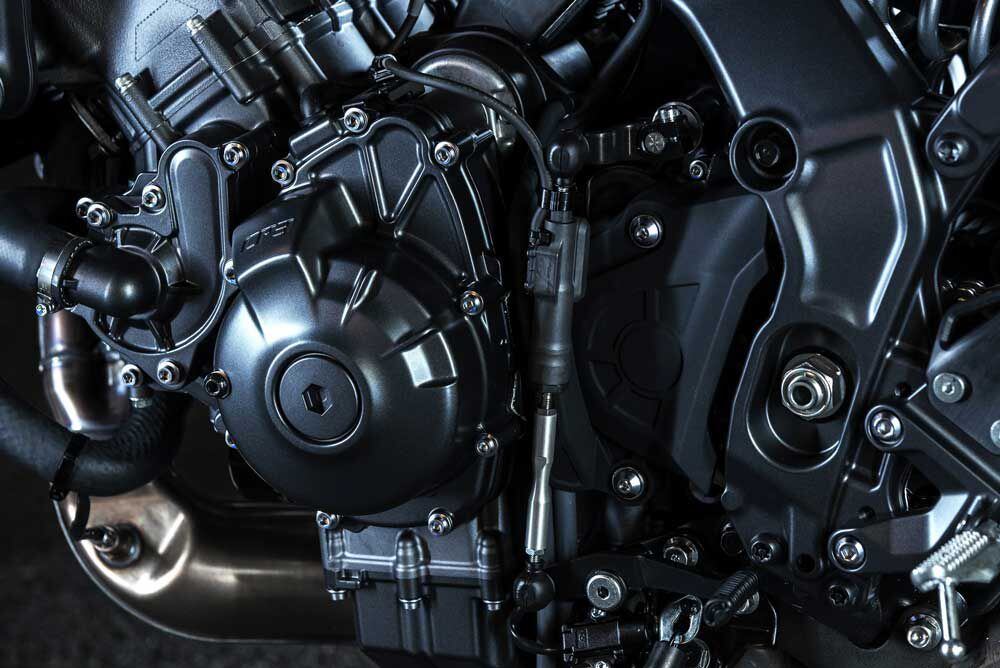
The MT-09′s 890cc triple is unchanged, though Yamaha added a new two-duct intake with amplifier grilles to magnify the mill’s induction honk. (yamaha/)The visual updates for 2024 start up front, with a new LED headlight which gets a redesigned cover and a smaller lens than before and is further up between the forks. The whole thing gives off a Bane-like vibe, and carries to the rear with a newly designed LED taillight with a slimmer look along with LED turn signals.
Less noticeable is the new fuel tank design, which Yamaha says sits 30mm lower and allows for more movement on the bike as well as giving the handlebar added room to move side to side. That ties into the new, slimmer, and now-two-piece seat unit allowing for an easier reach to the ground, as well as to the redesigned and relocated footpegs, which sit slightly more rearward and a bit higher than before. Those footpegs as well as the handlebar are two-position adjustable, giving riders even more ergonomic options, while the passenger pegs get moved back on the reshaped subframe.
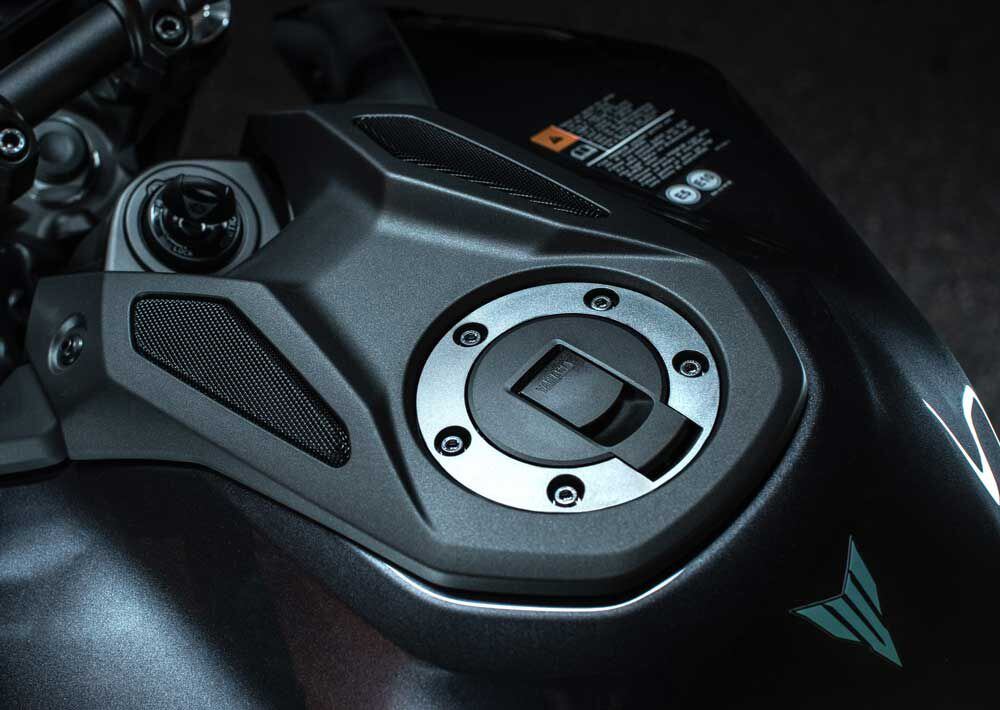
The new reshaped steel fuel tank sits lower and more forward, giving riders more room and the bike a different stance. (Yamaha/)Although the brake package keeps its dual 298mm discs with ABS up front, new this year is a Brembo radial master cylinder to offer better “controllability” according to Yamaha. In addition, riders will likely appreciate the new clutch lever which now offers multiple adjustments.
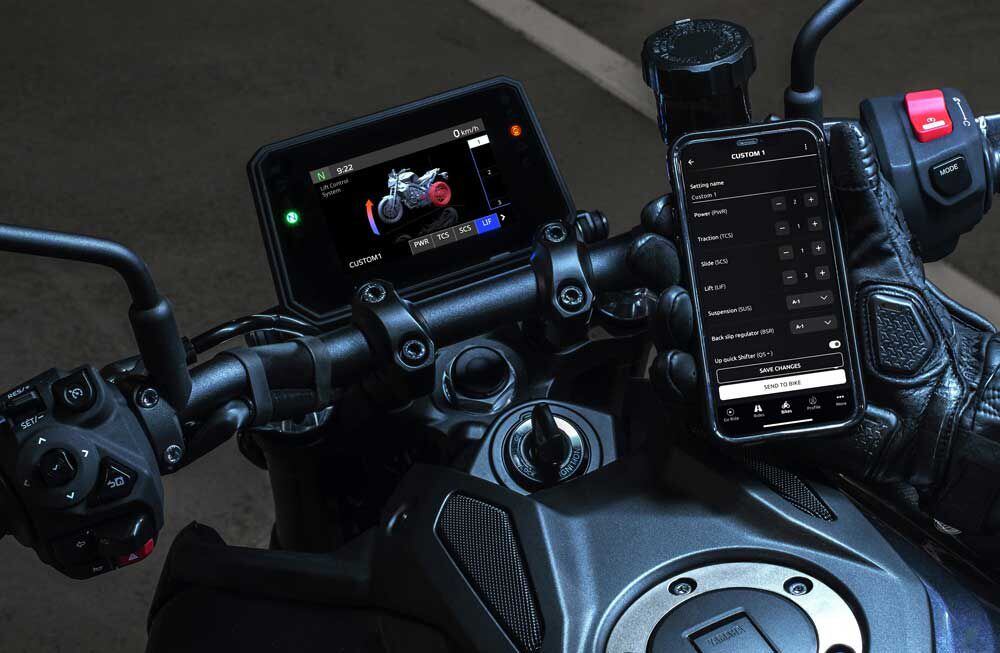
Larger 5-inch color TFT display makes the scene for 2024, with added connectivity and nav options. (Yamaha/)From there, Yamaha focused on refining the electronics, adding technology features, and improving convenience. A larger 5-inch full-color TFT display with smartphone connectivity and navigation is the cockpit’s centerpiece, and is navigated via all-new integrated handlebar switches with a new shape and feel. Connectivity is now standard; riders can link their smartphone using Yamaha’s free Y-Connect app and turn-by-turn navigation is available through the Garmin StreetCross app.
The MT-09′s three standard ride modes—Sport, Street, and Rain—which can also be accessed here, are likewise unchanged, but for 2024 Yamaha has also added two custom modes that can be programmed via the MyRide smartphone app or on the revised switch gear.
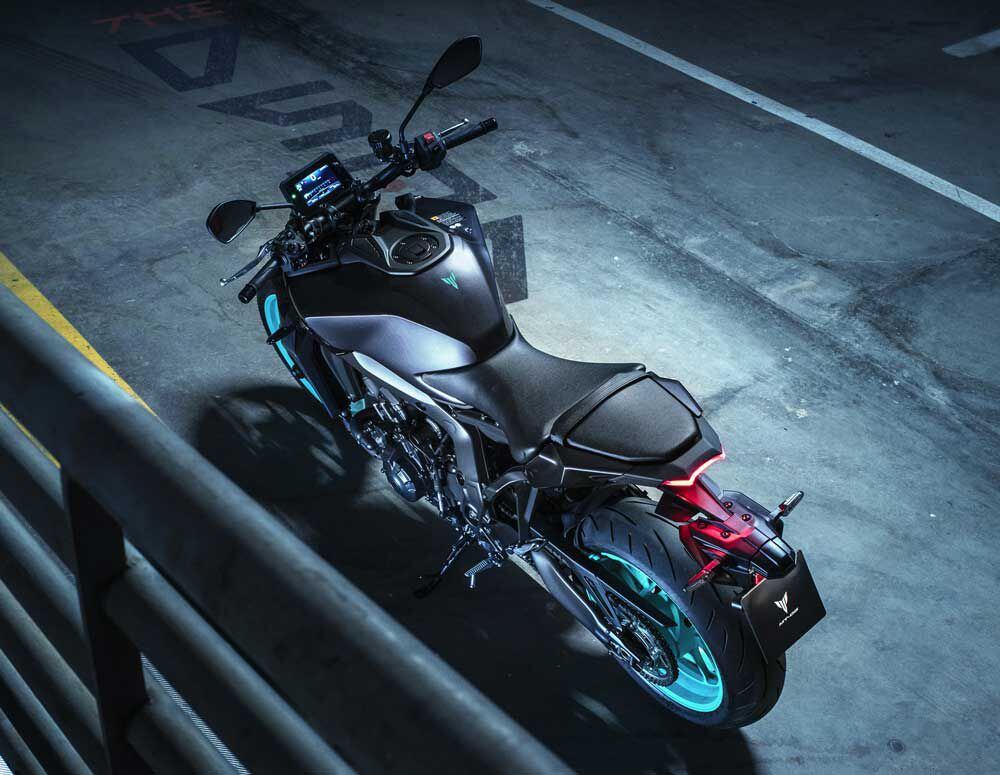
New two-piece seat is slimmer and allows for easier reach to the ground. Overall relationship with the seat, tank, and tailsection is more unified. (yamaha/)As for the electronic rider aids, the 2024 MT-09 retains its six-axis IMU, enabling lean-sensitive traction control, slide control, front wheel lift control, and brake control, but also adds the new Back Slip Regulator (BSR) which is supposed to stabilize the rear wheel during engine-braking and compensate for scenarios with lower grip. The latest MT-09 also gets Yamaha’s new third-generation Quick Shift System (QSS) for quick, clutchless upshifts and downshifts under both acceleration and deceleration.
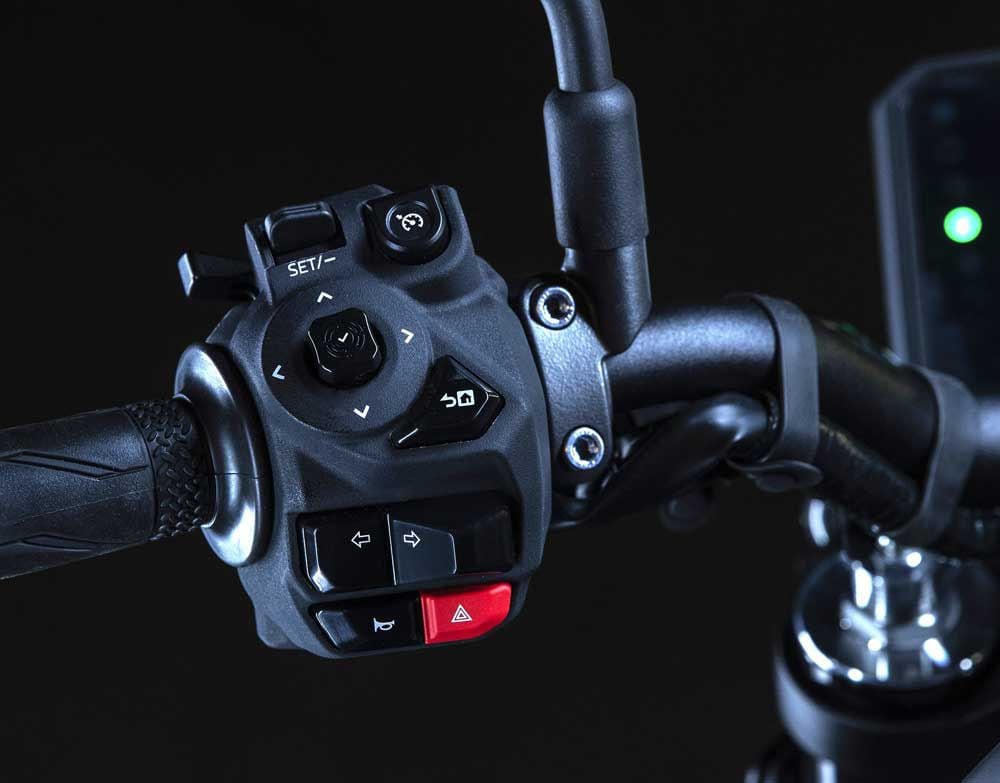
All-new integrated redesigned switch gear allows you to access the TFT screen and other functions. (yamaha/)Other minor tweaks are to the 41mm KYB fork, which is now fully adjustable with 5.1 inches travel, while the KYB shock out back is adjustable for preload and rebound damping and sees a new linkage design. Just above that is a new underseat USB Type C socket, and below that are lightweight SpinForged wheels shod with Bridgestone Battlax Hypersport S23 tires.
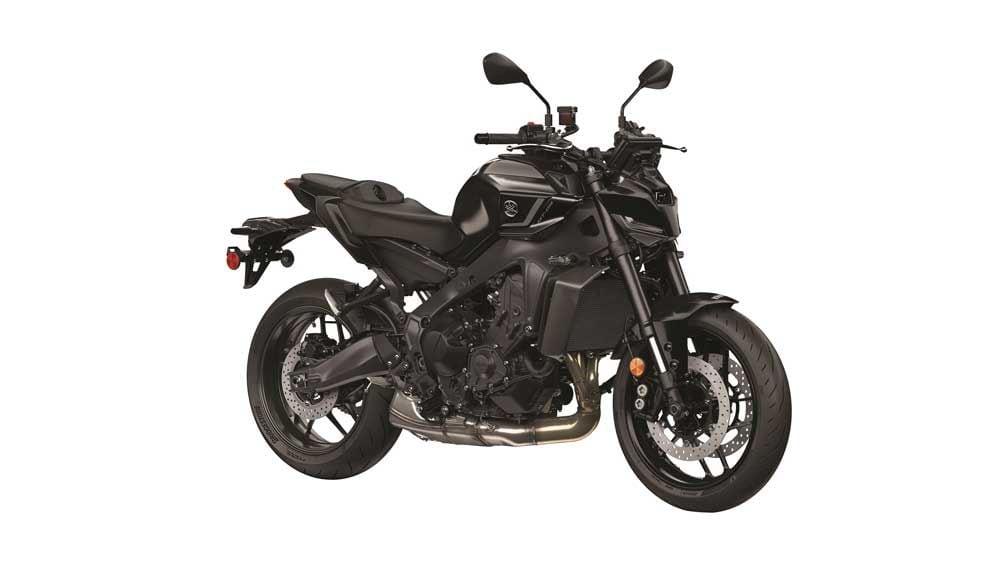
The 2024 Yamaha MT-09 in Raven Black; MSRP is $10,599. (Yamaha/)The new 2024 Yamaha MT-09 will be available in either Team Yamaha Blue, Midnight Cyan, or Matte Raven Black, and will be arriving to dealers in March 2024. MSRP is $10,599.
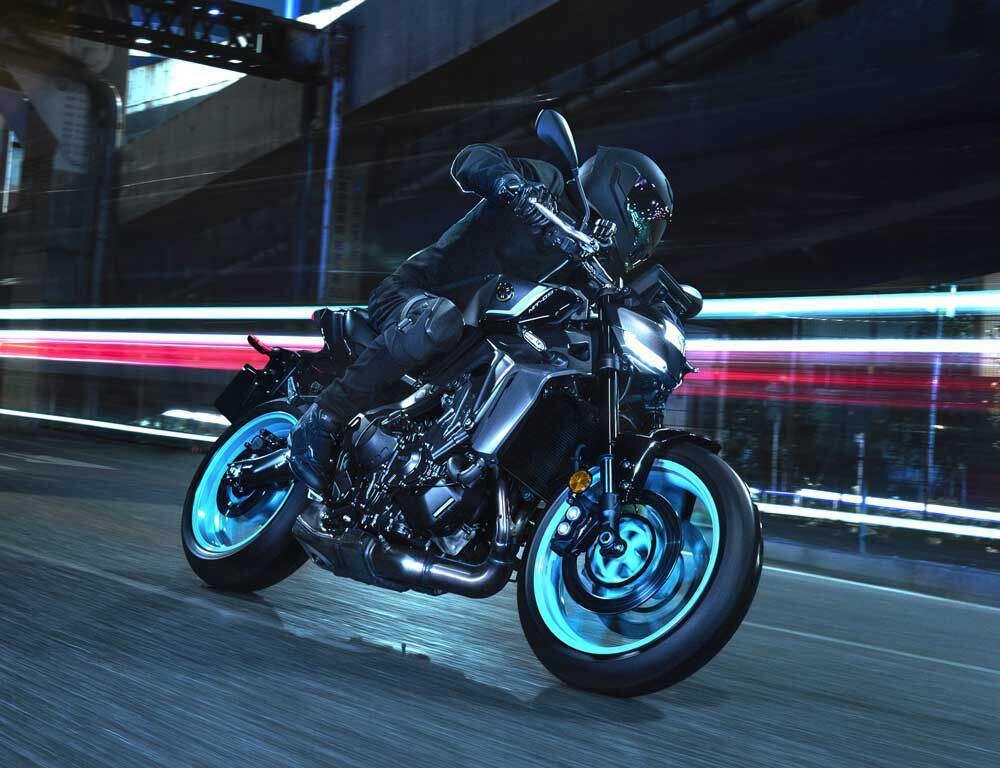
The 2024 Yamaha MT-09 will be available in March of 2024. (Yamaha/)2024 Yamaha MT-09 Specs
MSRP: $10,599 Engine: DOHC, liquid-cooled, inline three-cylinder; 12 valves Displacement: 890cc Bore x Stroke: 78.0 x 62.1mm Compression Ratio: 11.5:1 Transmission/Final Drive: 6-speed/chain Fuel System: Fuel injection w/ YCC-T Clutch: Wet, multiplate, slipper/assist Engine Management/Ignition: Transistor-controlled ignition Transmission/Final drive: 6-speed/chain Frame: Control-filled die-cast aluminum Front Suspension: KYB 41mm USD fork, fully adjustable; 5.1 in. travel Rear Suspension: KYB monoshock, preload and rebound adjustable; 4.6 Front Brake: 4-piston calipers, dual 298mm discs w/ ABS Rear Brake: 1-piston caliper, 245mm disc w/ ABS Wheels, Front/Rear: Spin-forged aluminum Tires, Front/Rear: Bridgestone Battlax Hypersport S23; 120/70ZR-17 / 180/55ZR-17 Rake/Trail: 24.7°/4.3 in. Wheelbase: 56.3 in. Ground Clearance: 5.5 in. Seat Height: 32.5 in. Fuel Capacity: 3.7 gal. Claimed Wet Weight: 425 lb. Contact: yamahamotorsports.com -
I spent a fun few weeks with the Speed Triple 1200 RS which was in the gorgeous Baja Orange

Find out here how I got on with the bike:
https://www.webbikeworld.com/2023-triumph-speed-triple-1200-rs-review/
Check out my video review of the bike here:
The post Triumph 2023 Speed Triple 1200 RS appeared first on BikerKaz.
-
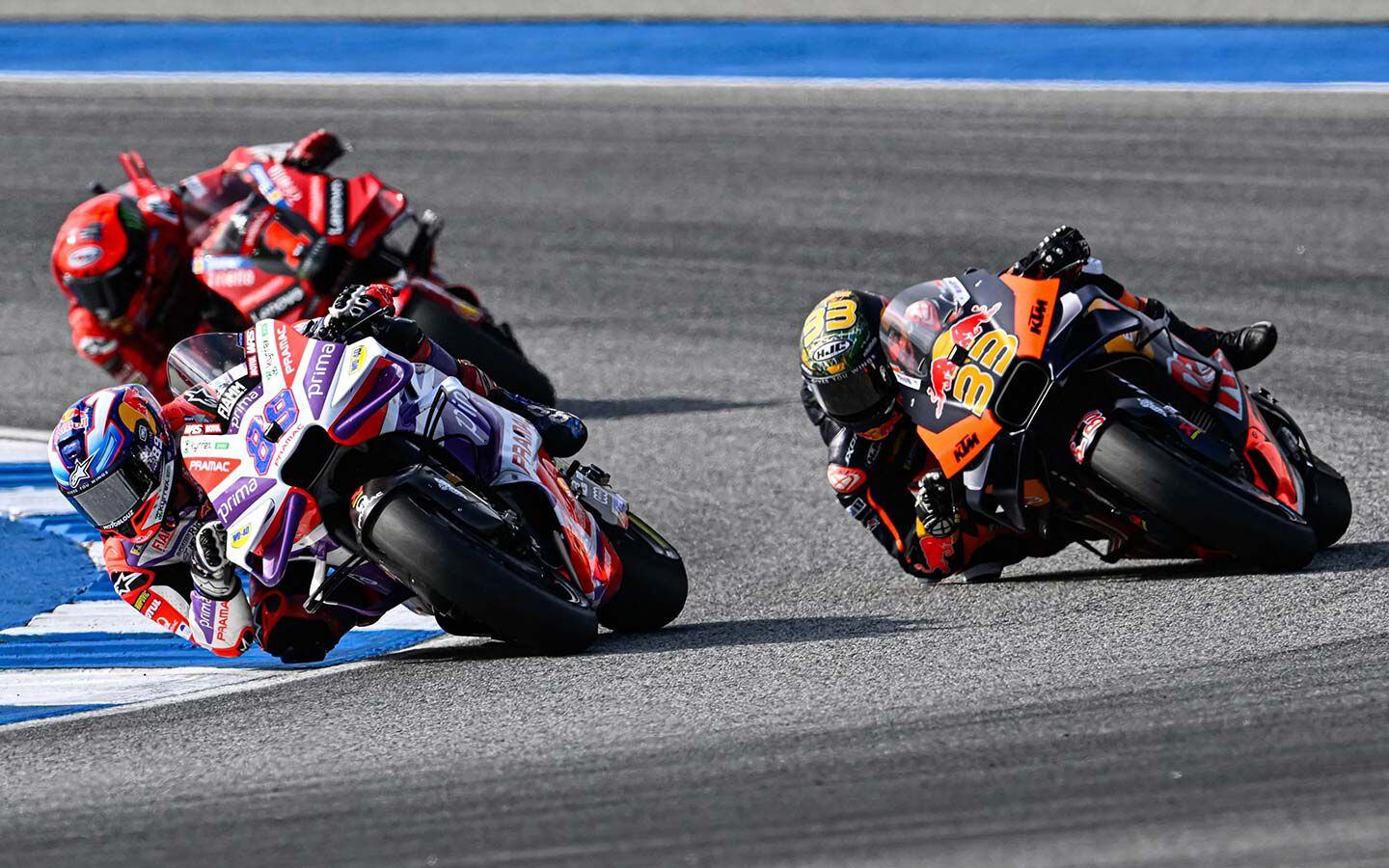
Jorge Martín takes another win in Buriram and cuts further into Francesco Bagnaia’s point lead. (MotoGP/)After last weekend’s Phillip Island GP the Big Question was, will MotoGP title challenger Jorge Martín crash out again or pick the wrong tire, enabling current champion Francesco Bagnaia to pull away? Or will he rely upon his own speed and focus to win again? Martín followed his recent pattern by qualifying on pole and winning the Saturday 13-lap sprint race.
Martín then narrowly led 21 of Sunday’s 27 laps. First-to-second separation was always a harrowing small fraction of a second. No pulling a small but comforting gap. Time for unbreakable concentration! At about lap 16 his lead began to disappear. He was now challenged by the two riders who had closed: KTM’s Brad Binder and the Ducati factory’s Bagnaia. From lap 21 Binder got by for three laps.
Binder said, “I tried to stay behind him and maintain the tire.”
This was pure Marc Márquez from years past: Push the leader, wait for a mistake or for his tire to drop, then pounce.
Binder continued, “I did exactly that. As soon as I passed him, [my tire] dropped.
“The lap I passed him was fine. It was the next one.
“As soon as [I was on the left side] of the tire, it would start pumping on the straights. Also, I had big vibration on the rear tire.”
“Pumping” is current rider-speak for weave oscillation, a two-to-three cycles-per-second instability that intensifies with speed. Kenny Roberts had a big weave in the Dutch TT 40-odd years ago that made one of his tires go flat. “Big vibration” often signals that heat is causing tread blistering—the eruption of volatiles through the tread surface. Bad omens.
Binder continued, “From then on it was just survive and fight with whatever I had.
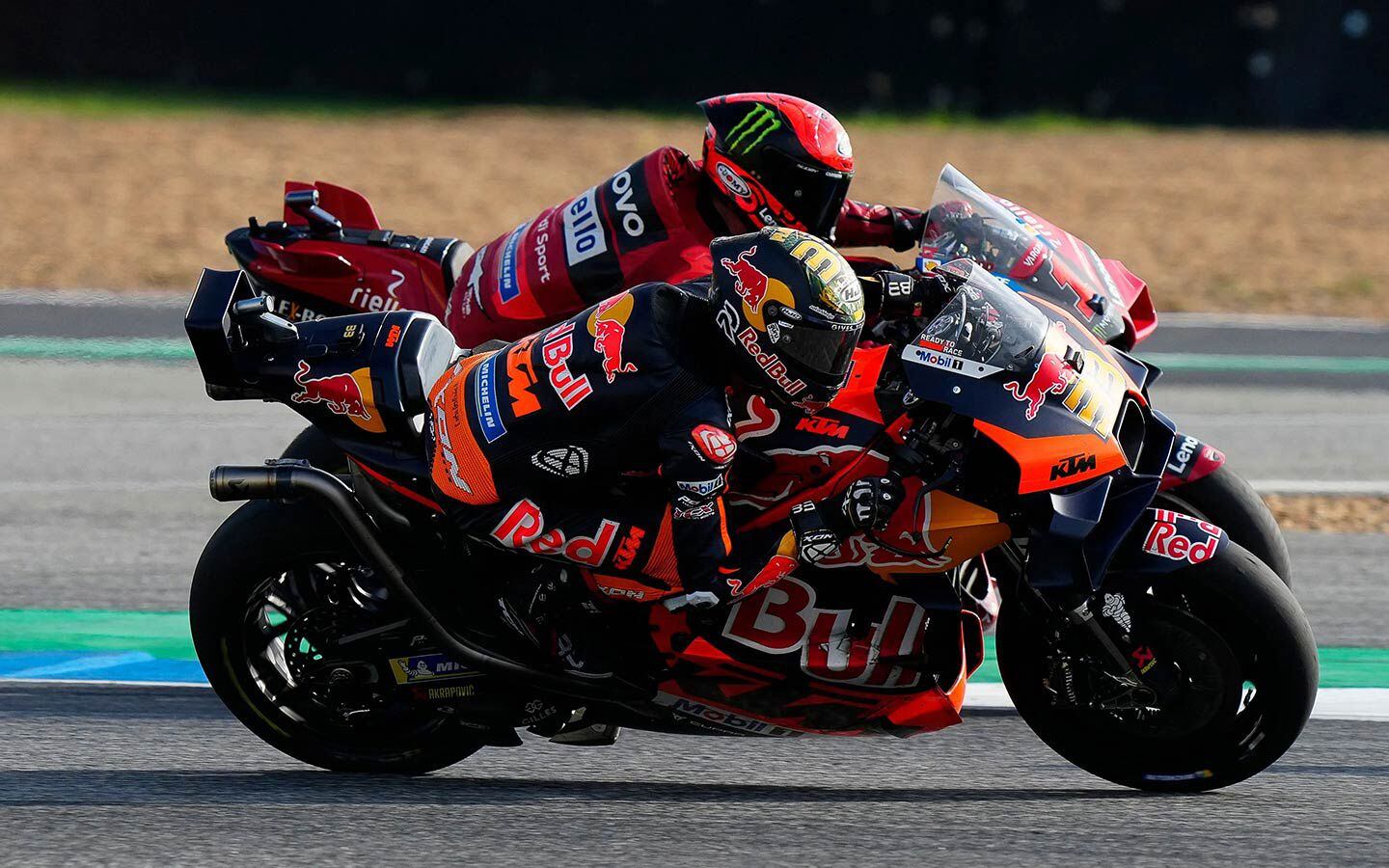
After passing for the lead, Brad Binder’s tire dropped and he held off Bagnaia to the finish, but then was docked a position for exceeding track limits. (MotoGP/)“I tried to brake late and roll through [turn 4]. When I cracked the gas, it pulled weight off the front tire. I tried to square it up but it touched the green.”
This gave him a time penalty for “exceeding track limits” that made Bagnaia officially second to Jorge Martín in the final results. The top five were Martín, Bagnaia, Binder, Marco Bezzecchi (Mooney VR46 Duc), and a man having a rare good day, Fabio Quartararo (factory Yamaha).
“Before we finished the first lap the battle commenced (he started sixth). There was a lot of contact, a lot of battles. It was intense,” Bagnaia said.
“I didn’t have time to manage the rear tire. I had to push a lot to close the gap.
“When I got to Binder and Martín I couldn’t be incisive in acceleration.”
A daring next-to-last-lap attempt to pass both on the outside showed sincerity but failed. At the end, all three headed for the slot through the last turn and it belonged to Martín.
Bagnaia said, “…Jorge makes more of an impression because he has incredible consistency and aggression, while we work more in the shadows.”
Later, when Bagnaia was asked if he were surprised that Martín was able to bear the pressure of the championship battle and win, he replied, “No, I knew it would go like this. The same happens to me. I make a mistake and the next race I’m in front.”
Martín described his race: “…today I had that confidence that I could use to gain back positions, to fight back with Brad.
“I was hearing his engine a lot out of corner 7. I was on the limit with the tires. I thought he had more grip.
“When they touched me in the last part of the race they were faster than me. I thought Brad was going to pull away—but I was able to keep the distance small.
“…as soon as he overtook me I saw he was on the limit with rear grip. I tried to keep the distance for one lap, then overtake him back. I didn’t want my front tire to get hot.”
No tire nonsense like last weekend, when Martín’s soft rear gave up at the very end. This weekend he was just one of the top 17 on the medium/hard combination. He didn’t need a trick tire choice to make the pace.
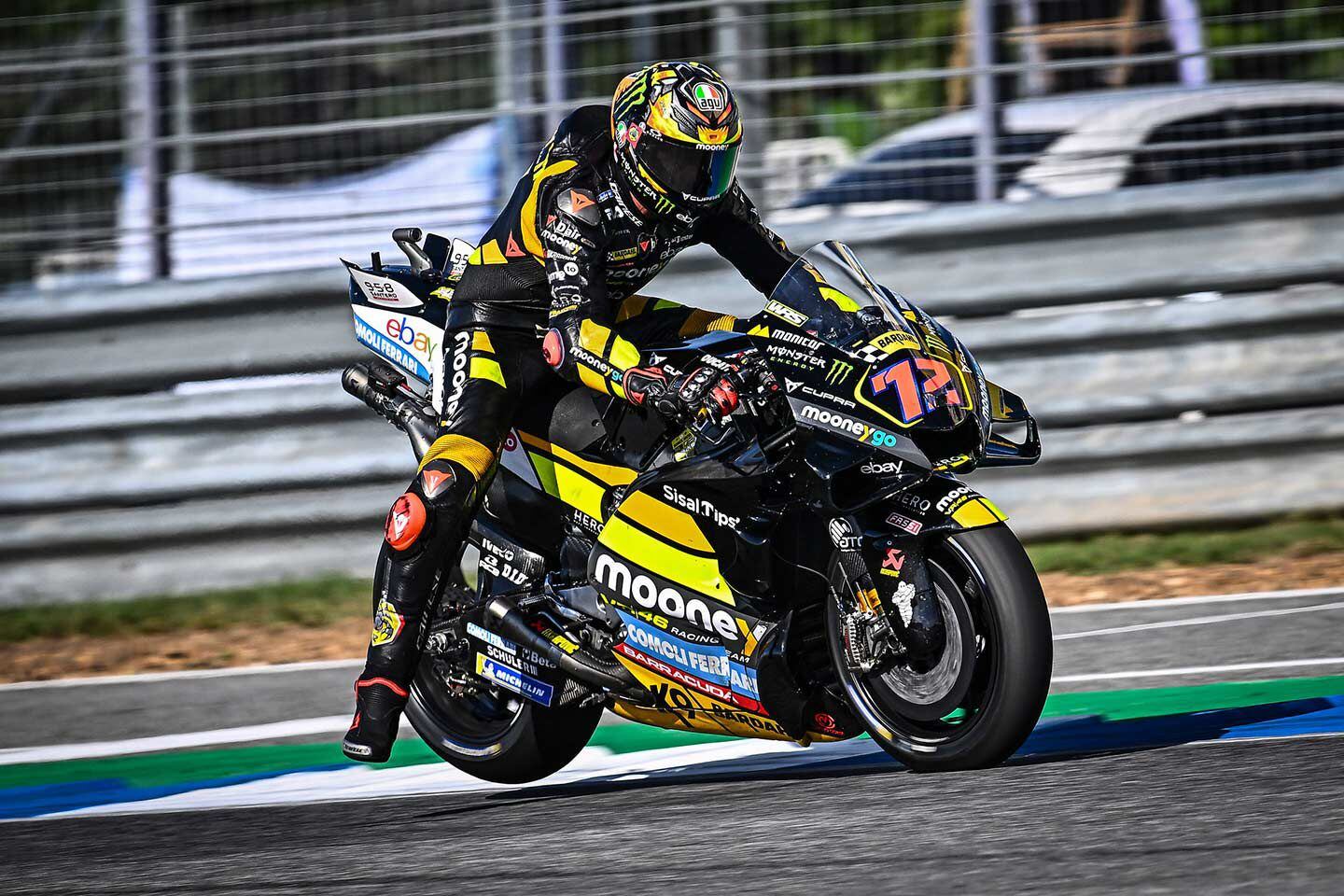
Marco Bezzecchi saved a fourth place finish. (Mooney VR46/)It has been interesting to see the response of race fans to change. In the recent past MotoGP has been dominated by Supermen in whose shadow the others appeared two-dimensional. Mick Doohan, Valentino Rossi, Casey Stoner, and Marc Márquez have now been replaced by a dozen near-equals, well matched in both skills and equipment. For whom shall we root? Who is the standout? Any one of the dozen is capable of winning a race or two. Several of them—including Bezzecchi—are riding at less than their best, still recovering from the early season spate of injuries. Others lack consistency, finishing below their capability because of unpredicted tire drop or technical issues. Yet all are fast, capable of hatching a surprise. The biggest change is that nothing is certain any more. No rider appears larger than life.
When years ago I asked Dorna CEO Carmelo Ezpeleta, “What will happen when Rossi retires?” he replied, “Other great champions will arise.”
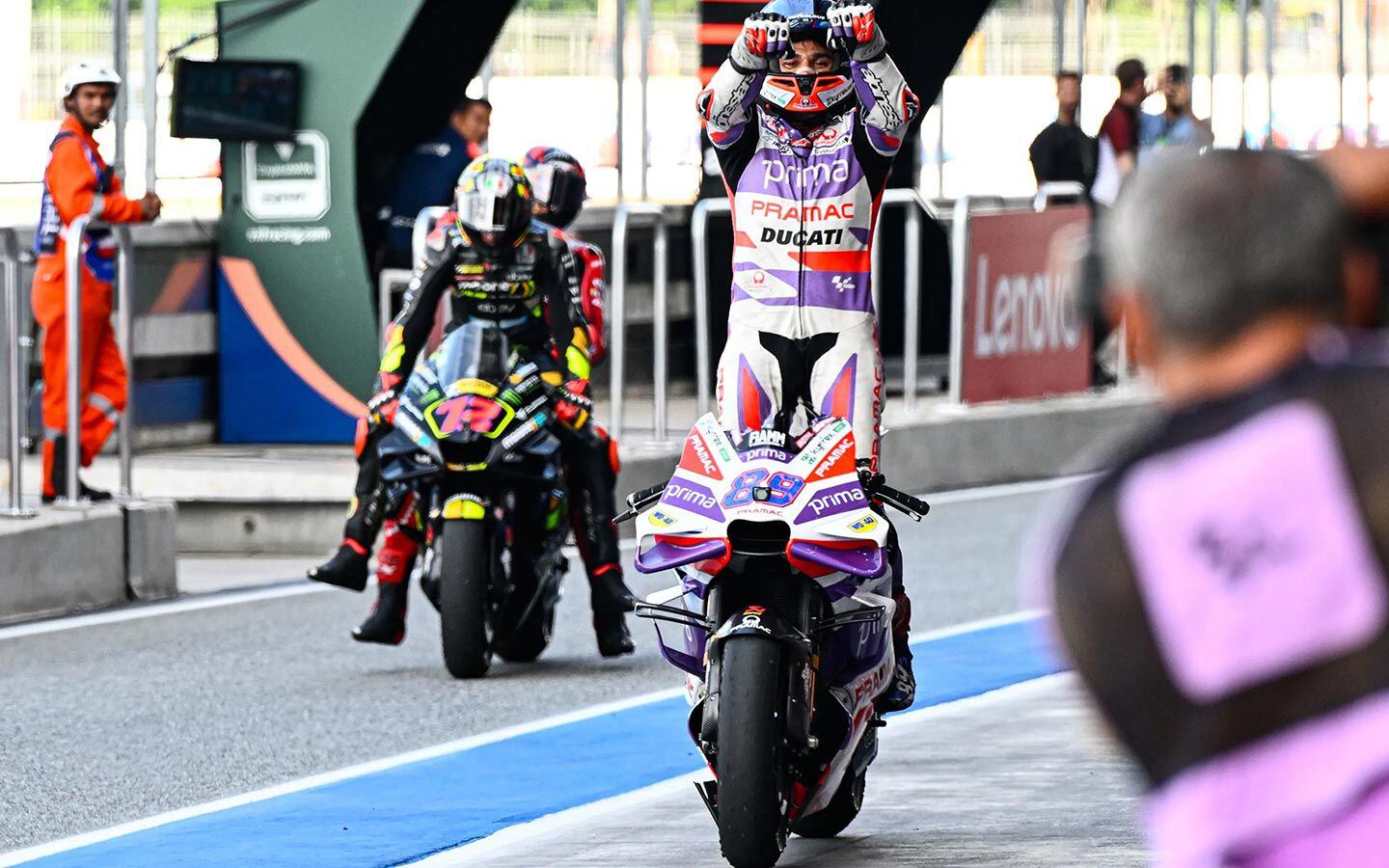
Martín celebrates a hard-fought win. (MotoGP/)As it has turned out, none of the latter-day champions has been a showman and crowd-pleaser like Rossi. Theorists propose that “close racin’” is what packs ‘em in, but the present situation throws that into doubt. Fans want a Superman who does unimaginable things.
Aleix Espargaró (factory Aprilia) was assessed a three-second penalty for riding more than half the race under the Michel-specified minimum tire pressure. This turned his earned race finish of fifth into an official eighth. Based on other riders’ experiences, this is a “damned if you do, damned if you don’t” situation. If your crew gives you higher pressures to avoid a rules penalty, you may earn a physical penalty in the form of your front tire beginning to lock as rising tire pressure shrinks its footprint, or as “closing” of the front (loss of self-aligning torque as front grip decreases). Can any rider count on leading, thereby keeping his front tire cool? Does anyone have such low self-esteem as to be certain of being locked into a hot drafting cluster?
All riders know this problem is real. On full throttle, the energy of the fuel divides three ways: One-third becomes mechanical power to the rear wheel, one-third is rejected to cooling water or oil, and the last third emerges as exhaust heat. Stand in the right place and you can see the air surrounding bikes on the track shimmering as heat alters its index of refraction. Near top speed, even the energy given to the rear wheel becomes heat—as the result of forcing a half-streamlined object through the resisting air.
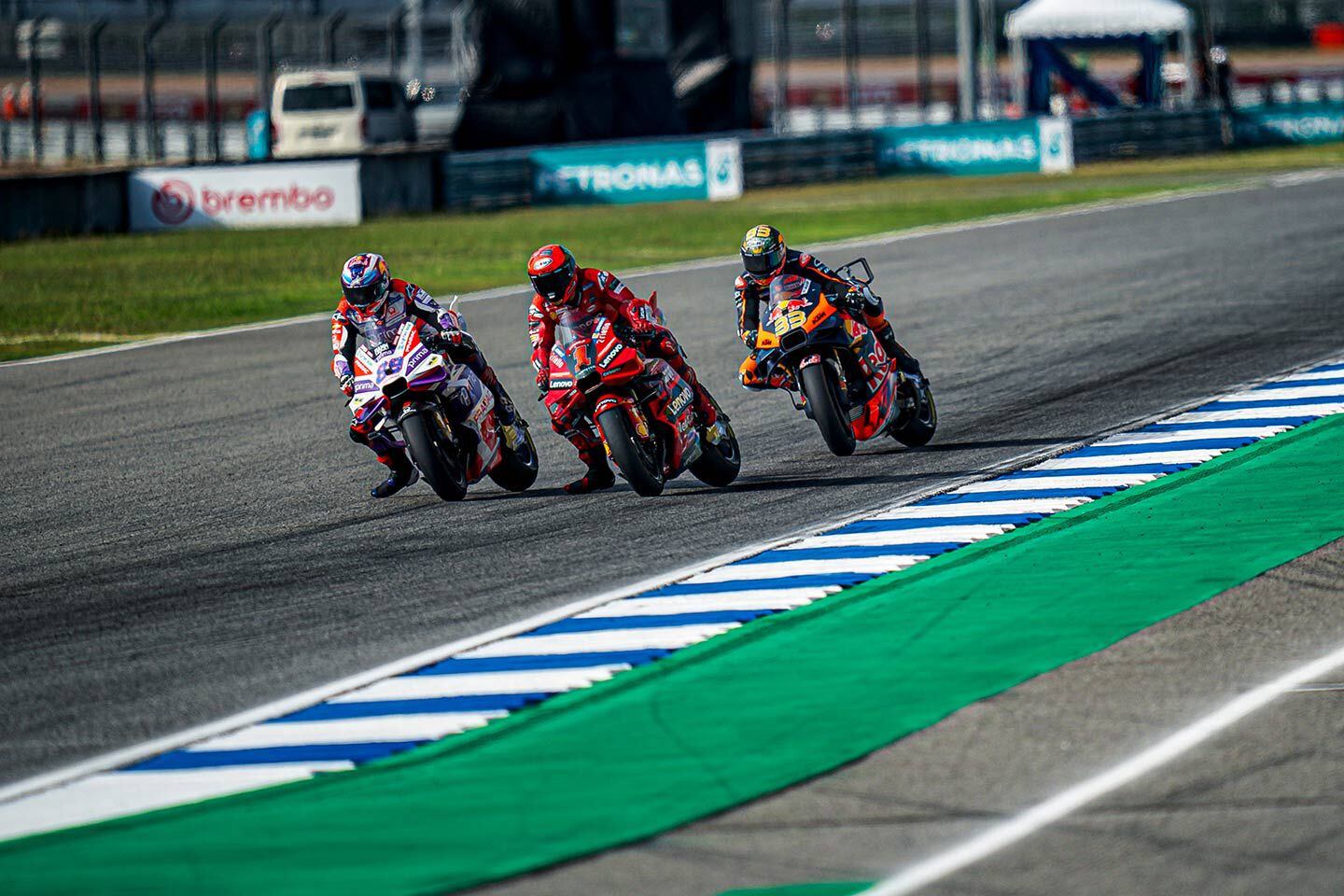
Bagnaia’s brave outside pass nearly stuck. (Ducati/)Bagnaia noted, “I tried to never stay in [anyone’s] slipstream on the straights because the [tire] temperature and pressure rose a lot.”
Luca Marini (now reportedly under consideration by Honda) said, “When Brad overtook me I tried to overtake him again as soon as possible because I knew if I waited too long the pressure of the front tire was rising and then it was more difficult.”
Marini finished seventh on a Mooney VR45 Ducati.
He described the same in Saturday’s sprint: “After three, four laps you start to feel more front locking, more closing—especially closing the front in turn 6, turn 9, the last corner. I try to block Brad and close everything [to block pass attempts] because I know that maybe if I can do eight laps in front, his [front tire] temperature will rise more [so that] he cannot overtake.”
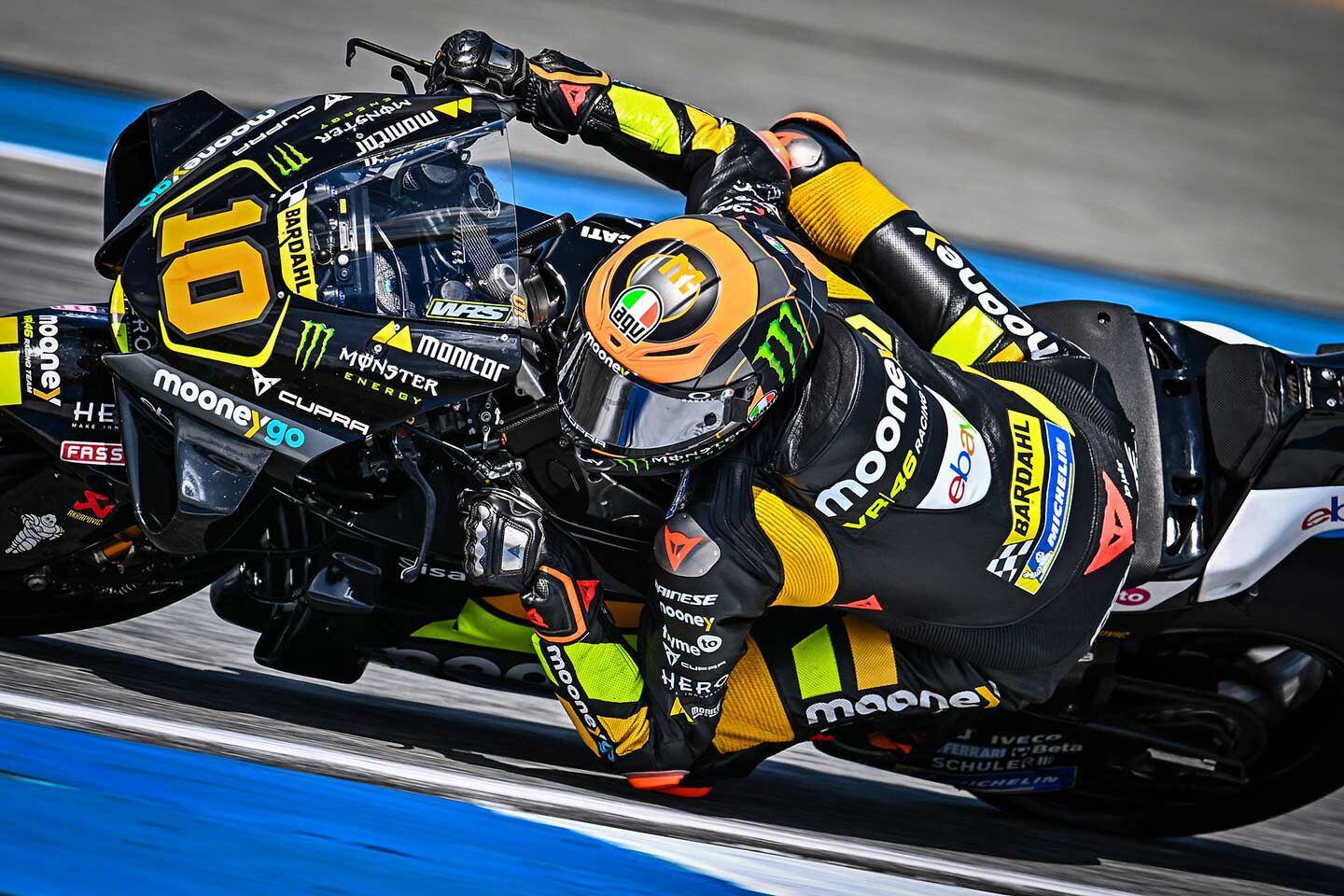
Luca Marini finished seventh on Sunday. (Mooney VR46/)Tire heating as a racing strategy? Successful racers are imaginative opportunists. See the photos and videos of Martín, dragging his inside shoulder in turns. Like Marc Márquez before him, he knows there is a limit to how far the bike can be leaned before it drags on the pavement, causing grip loss and running wide—or worse. To prevent this, he moves as much of his own mass to the inside and downward, in order to hold the bike more upright.
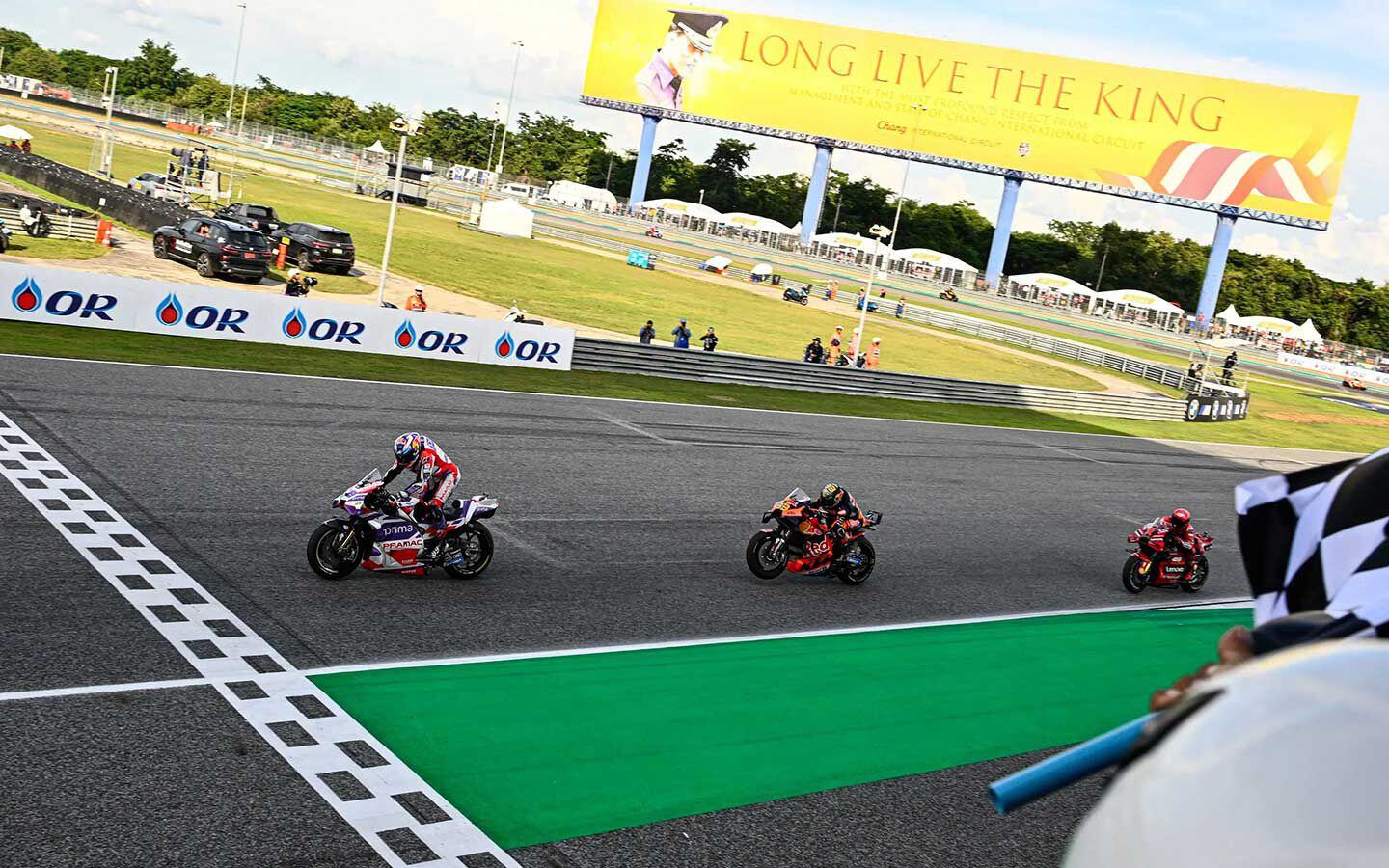
Buriram was one of the closest races of the year. (MotoGP/)Why doesn’t a team just raise its bike so it won’t ground, allowing the rider to stay centered like Gary Nixon 50 years ago, rather than look like a mad gymnast on the pommel horse? Nope, can’t. Reason? Tall bikes wheelie easier, lowering the upper limit on acceleration. Races are mostly won on acceleration! Dragsters are built long and low for this reason, but MotoGP bikes can’t be made longer without slowing their steering response, wasting more time in rolling over for each corner. Motorcycles are tight compromises.
In two weeks comes Malaysia. Just three races left, from which a champion will emerge.
-
Testing the new Himalayan in the Himalayas is just good, solid math.
-
13 percent more power over the previous version is not an unlucky number here.
-
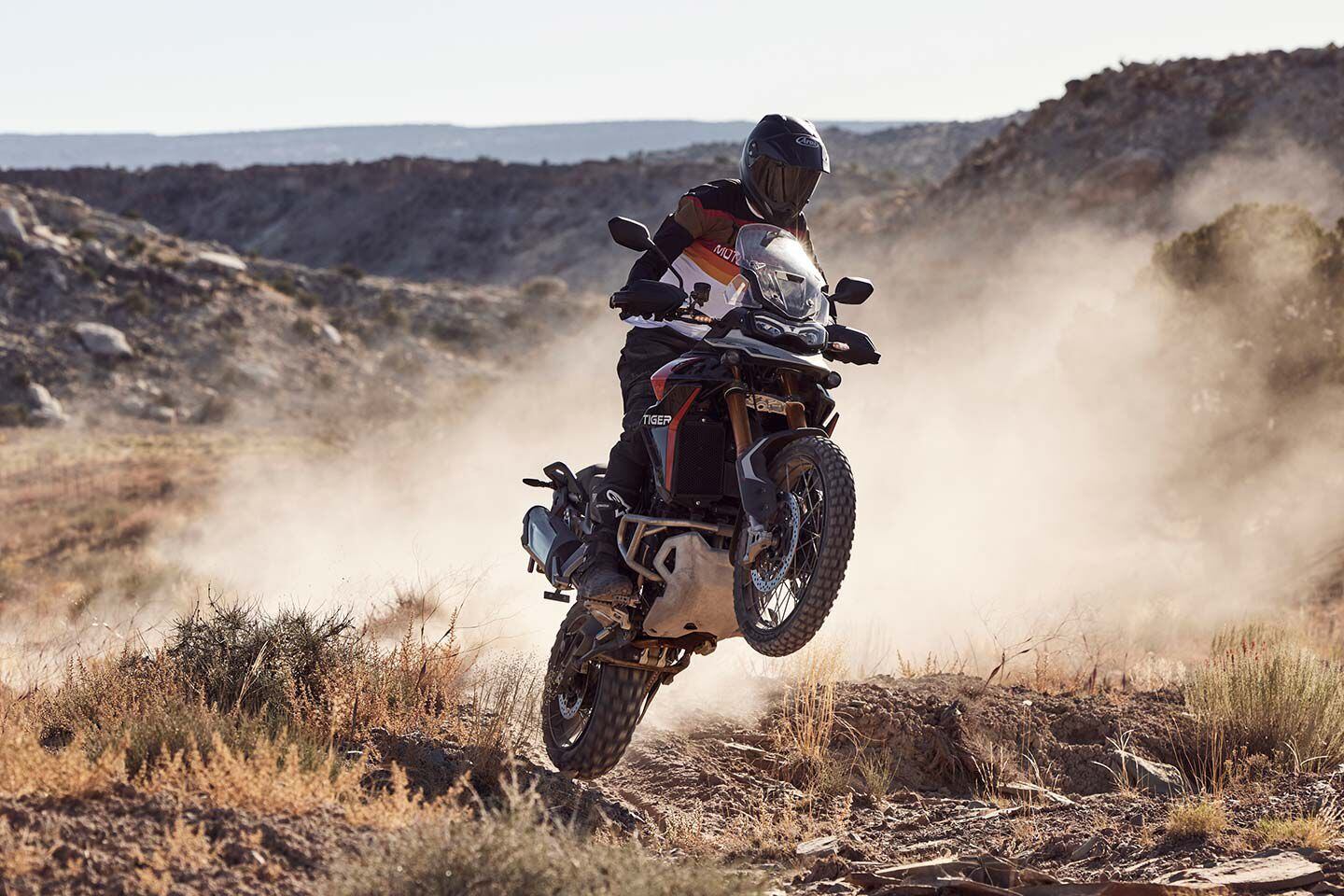
Triumph gives the Tiger 900 more horsepower for 2024. (Triumph/)For 2024 Triumph is slimming down its Tiger 900 range to concentrate on just three variants but every one of them packs a new version of the company’s 888cc three-cylinder engine with a substantial performance increase compared to their predecessors.
Today the Tiger 900 range alone is made of six bikes—three GT and three Rally variants—and sits in a wider adventure lineup that also includes five Tiger 1200 models, the Tiger 850 Sport, and the Tiger Sport 660. In short Triumph isn’t lacking when it comes to machines for the adventure bike crowd, so slicing away some of the extraneous variants of the Tiger 900 isn’t likely to damage sales. What will boost them, though, is the fact that the remaining three 2024 versions each have a clear space in the market and now offer a level of performance that more than addresses improvements made to some of their key competitors.
The 2024 lineup kicks off with the entry-level, road-biased Tiger 900 GT. Above it sits the Tiger 900 GT Pro with a similar look and stance but higher equipment levels, and at the top of the range is the Tiger 900 Rally Pro, again featuring a high level of standard equipment but with a more off-road bias to its suspension, wheels, and tires. There’s no 2024 replacement for the Tiger 900 Rally or the limited-run, 2024-only Aragón Edition models. The new range means there’s a clear distinction between each model’s position and appeal, and despite the big performance improvement of the new bikes, their MSRPs are carried over unchanged from the 2023 equivalents, with the GT starting at $14,995, the GT Pro at $16,895, and the Rally Pro coming in at $17,395.
Related: Triumph Adds Active Preload Reduction To Tiger 1200
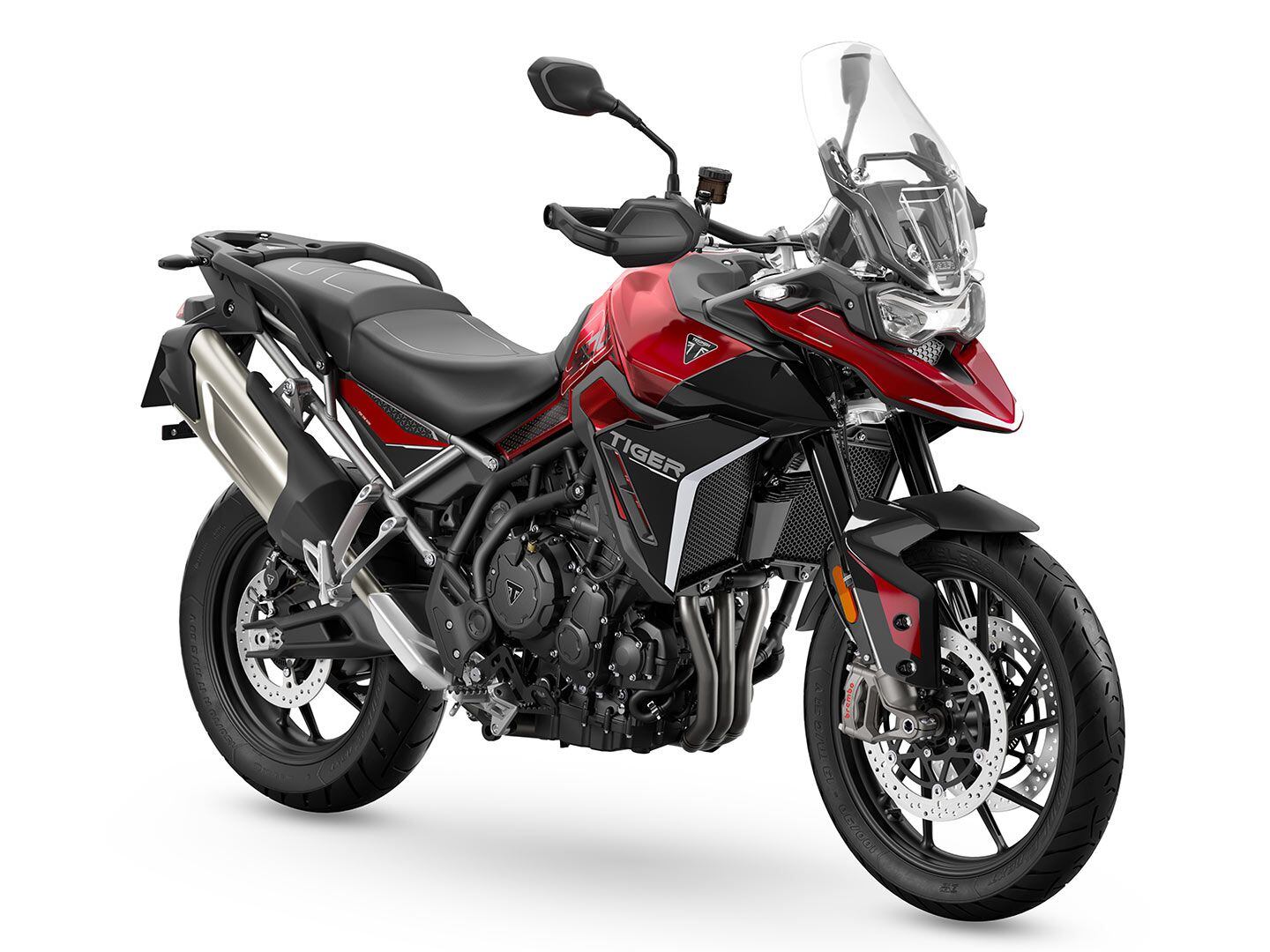
Triumph’s Tiger 900 GT is the “base” model for the three-bike range. (Triumph/)All three get the same engine updates, with a revised triple making 106.5 hp compared to 93.7 hp for the 2023 bikes. That’s a 13 percent boost, and it’s achieved by extending the engine’s ability to rev. The power curve tracks that of the old bike up to around the 7,000 rpm mark but continues to build above that point, where the old motor’s graph starts to flatten, to give its peak at 9,500 rpm. That means you’re not giving up low-rev performance in exchange for the high-rpm power of the new engine, simply getting more benefit from pushing it toward the redline.
Technically, the changes include new pistons that help boost the compression ratio from 11.27:1 to 13.0:1. They’re aided by a new cylinder head design with larger intake ports and optimized exhausts, new inlet and exhaust camshafts, and new intake trumpets, 15mm longer than before to tune the airflow into the motor. On the way out, gases pass through a completely new exhaust system including a single, free-flowing catalyst and a new muffler. The improvements these changes bring are illustrated not only by the extra power but the fact that despite its performance improvements, the 2024 engine is also 9 percent more fuel efficient, with a similar 9 percent improvement in emissions.
With no additional capacity to lean on, it’s not surprising to see that the torque hasn’t grown as much as the power. The peak rises a fraction, from 64 lb.-ft. to 66.38 lb.-ft., and arrives a few hundred rpm lower in the rev range, illustrating the broader performance spectrum of the new motor. Altogether, the increased power means the 2024 Tiger 900 models now have numbers to more than match BMW’s new F 900 GS and KTM’s 890 Adventure, as well as beating the peak power of some bigger-capacity bikes like Honda’s Africa Twin. As in the past, there are multiple riding modes on offer—four for the GT, five for the GT Pro, and six for the Rally Pro—and all versions have cornering ABS and cornering traction control. The ABS can also be switched off on the Rally Pro for off-road use, and for 2024 all models get an emergency deceleration warning system that flashes the hazard lights during hard stops. Both Pro models get a bidirectional quickshifter as standard, and it can be added to the base GT as an extra-cost option.
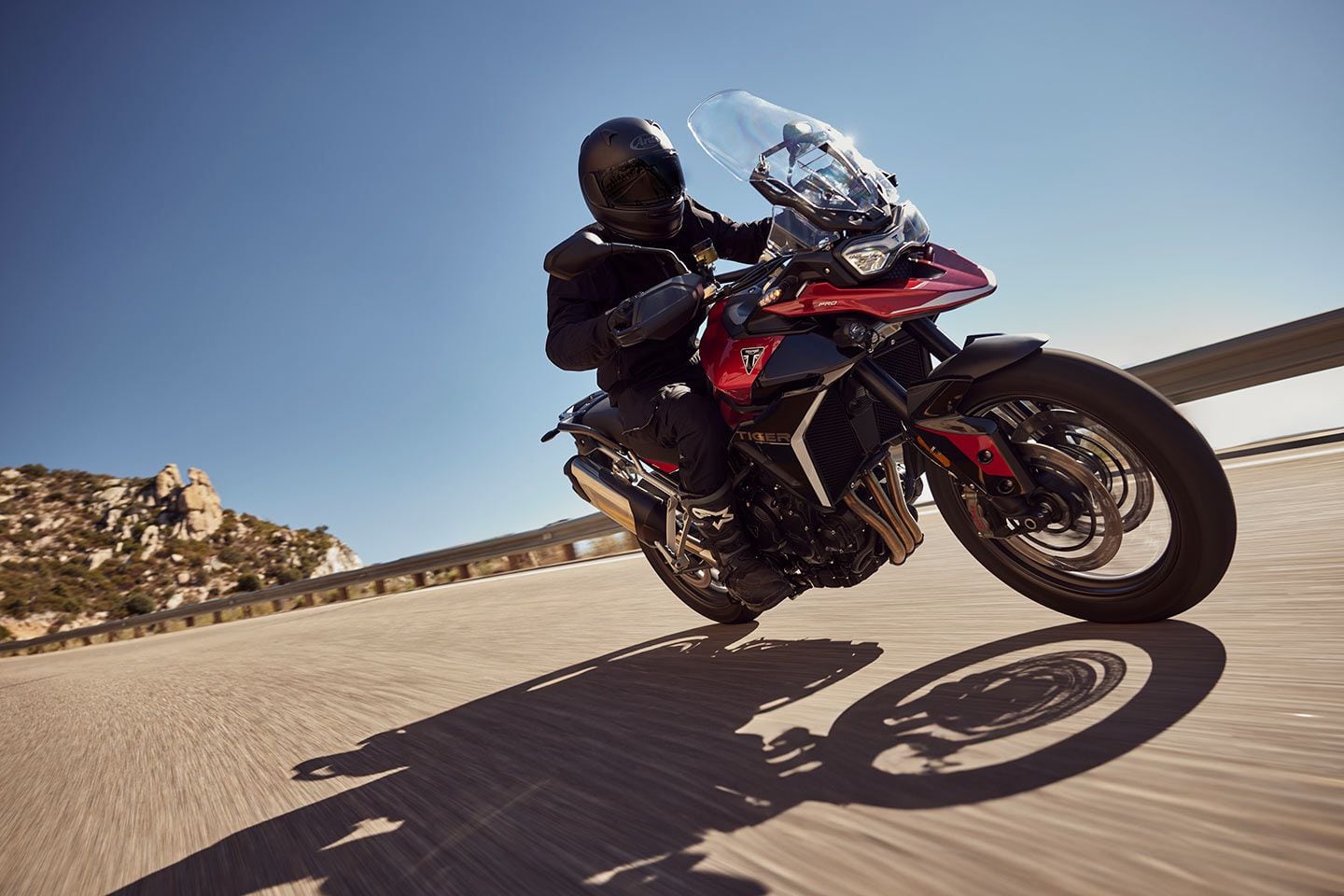
Both power and torque are upped for all three Tiger 900 models for 2024. (Triumph/)With so much focus on the engine, it’s unsurprising that Triumph hasn’t felt the need to radically overhaul the Tiger’s chassis, which continues into the new model year without any major changes. Both GT models use Marzocchi suspension at each end, with a 45mm fork and a gas rear shock, though the GT Pro has electronic adjustment for the rear preload and damping adjustment where the base version has manual adjusters. As before, the Tiger 900 Rally Pro uses Showa suspension instead of Marzocchi, with substantially longer travel—9.5 inches at the front, 9.1 inches at the rear compared to 7.1 inches and 6.7 inches respectively for the GT models—and uses a 21-inch front wheel instead of the 19-incher of the street-oriented GTs. The brakes remain unchanged, with Brembo Stylema calipers and 320mm discs at the front on all versions of the bike.
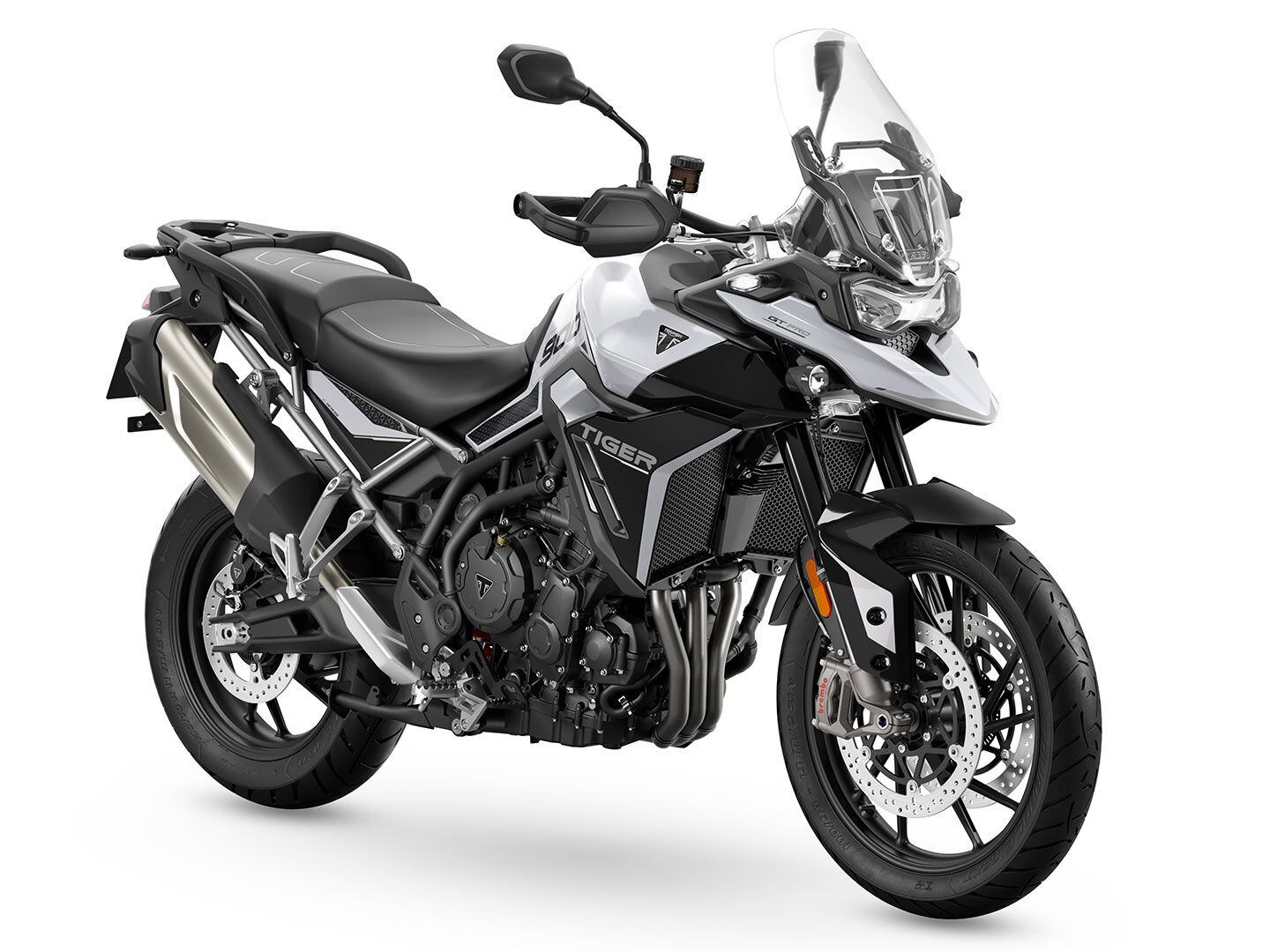
The Tiger 900 GT Pro ups the touring chops with electronically adjustable rear suspension. (Triumph/)The visual updates are subtle but there’s a new seat—claimed to be flatter and more comfortable than before—and revisions to the bodywork including new side panels and a redesigned beak at the front. The lighting is LED, as before, but the 2024 Tiger 900s all get an updated TFT instrument panel, inherited from the Tiger 1200, with a better display and graphics than the previous design. As you’d expect, it includes phone connectivity for media, calls, and turn-by-turn navigation, but Triumph hasn’t made the leap to include Apple CarPlay or Android Auto in the system.
Finally, there are new colors for 2024, with the GT and GT Pro coming in Snowdonia White as standard, with the option of upgrading to two-tone schemes of Graphite and Sapphire Black or Carnival Red and Sapphire Black at extra cost. The Rally Pro’s base paint is Carbon Black and Sapphire Black, with two paint options of Ash Gray and Intense Orange or Matte Khaki Green and Matte Phantom Black. Dealers can take orders now, with deliveries expected to begin in early 2024.
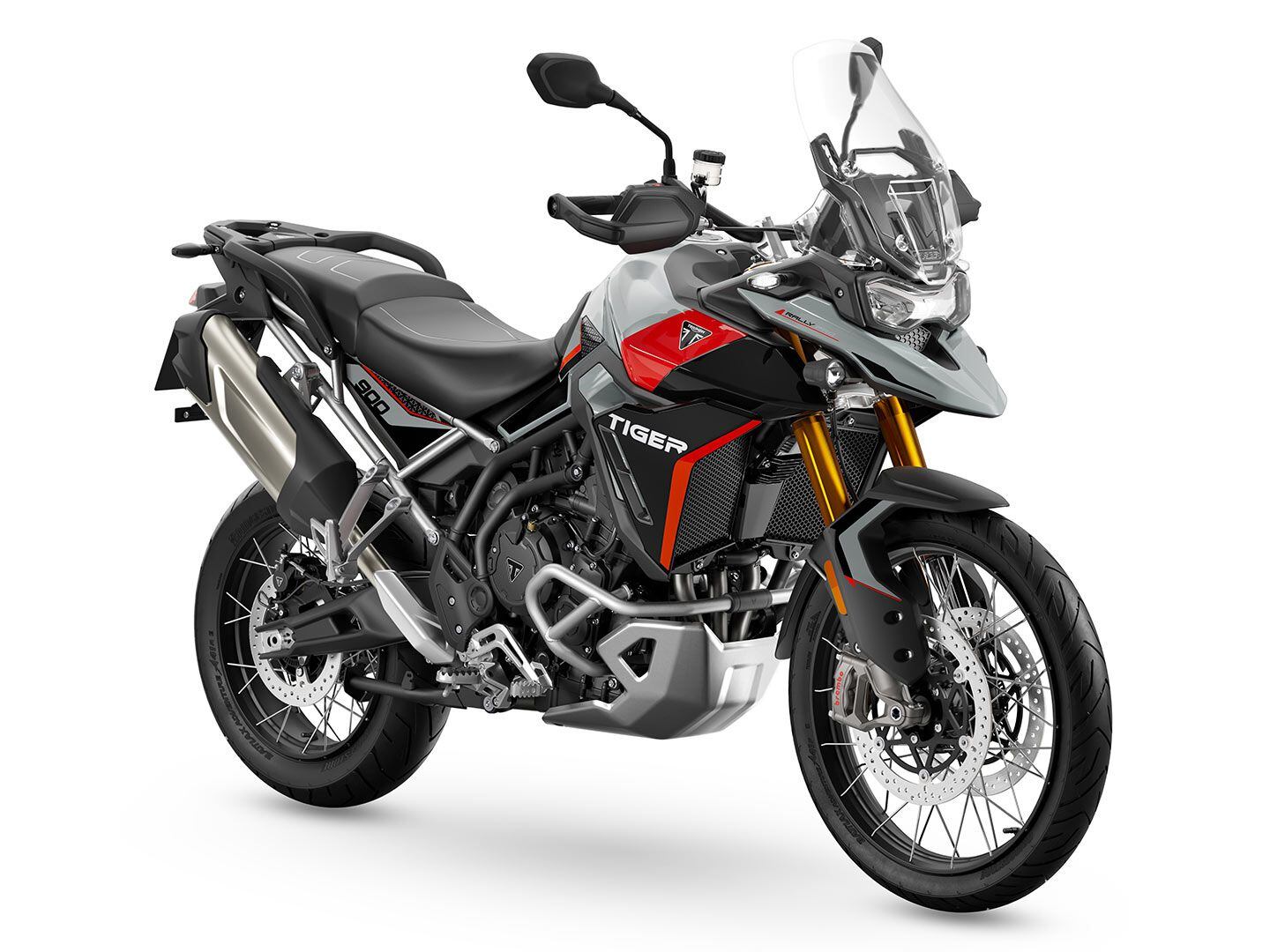
More suspension travel with more adjustment, a 21-inch front wheel, and spoked wheels give the Tiger Rally Pro increased off-road chops. (Triumph/)2024 Triumph Tiger 900 GT Specs
MSRP: $14,995 Engine: DOHC, liquid-cooled, inline 3-cylinder; 12 valves Displacement: 888cc Bore x Stroke: 78.0 x 61.9mm Compression Ratio: 13:1 Transmission/Final Drive: 6-speed/chain Claimed Horsepower: 106.5 hp @ 9,500 rpm Claimed Torque: 66.4 lb.-ft. @ 6,850 rpm Fuel System: Multipoint sequential electronic fuel injection w/ electronic throttle control Clutch: Wet, multiplate, slip/assist Frame: Tubular steel trellis; bolt-on aluminum rear subframe Front Suspension: Marzocchi 45mm USD fork, compression and rebound adjustable; 7.1 in. travel Rear Suspension: Marzocchi RSU, preload and rebound adjustable; 6.7 in. travel Front Brake: Brembo Stylema 4-piston Monoblock calipers, twin 320mm floating discs; radial front master cylinder w/ Optimized Cornering ABS Rear Brake: 1-piston sliding caliper, 255mm disc w/ Optimized Cornering ABS Wheels, Front/Rear: Cast aluminum; 19 x 2.5 in./17 x 4.25 in. Tires, Front/Rear: Metzeler Tourance Next; 100/90-19 / 150/70R-17 Rake/Trail: 24.6°/5.2 in. Wheelbase: 61.3 in Seat Height: 32.3–33.1 in. Fuel Capacity: 5.3 gal. Claimed Wet Weight: 483 lb. Contact: triumphmotorcycles.com 2024 Triumph Tiger 900 GT Pro Specs
MSRP: $16,895 Engine: DOHC, liquid-cooled, inline 3-cylinder; 12 valves Displacement: 888cc Bore x Stroke: 78.0 x 61.9mm Compression Ratio: 13:1 Transmission/Final Drive: 6-speed/chain Claimed Horsepower: 106.5 hp @ 9,500 rpm Claimed Torque: 66.4 lb.-ft. @ 6,850 rpm Fuel System: Multipoint sequential electronic fuel injection w/ electronic throttle control Clutch: Wet, multiplate, slip/assist Frame: Tubular steel trellis; bolt-on aluminum rear subframe Front Suspension: Marzocchi 45mm USD fork, compression and rebound adjustable; 7.1 in travel Rear Suspension: Marzocchi RSU, electronic preload and rebound adjustable; 6.7 in. travel Front Brake: Brembo Stylema 4-piston Monoblock calipers, twin 320mm floating discs; radial front master cylinder w/ Optimized Cornering ABS Rear Brake: 1-piston sliding caliper, 255mm disc w/ Optimized Cornering ABS Wheels, Front/Rear: Cast aluminum; 19 x 2.5 in./17 x 4.25 in. Tires, Front/Rear: Metzeler Tourance Next; 100/90-19 / 150/70R-17 Rake/Trail: 24.6°/5.2 in. Wheelbase: 61.3 in. Seat Height: 32.3-–3.1 in. Fuel Capacity: 5.3 gal. Claimed Wet Weight: 489 lb. 2024 Triumph Tiger 900 Rally Pro Specs
MSRP: $17,395 Engine: DOHC, liquid-cooled, inline 3-cylinder; 12 valves Displacement: 888cc Bore x Stroke: 78.0 x 61.9mm Compression Ratio: 13:1 Transmission/Final Drive: 6-speed/chain Claimed Horsepower: 106.5 hp @ 9,500 rpm Claimed Torque: 66.4 lb.-ft. @ 6,850 rpm Fuel System: Multipoint sequential electronic fuel injection with electronic throttle control Clutch: Wet, multiplate, slip/assist Frame: Tubular steel trellis; bolt-on aluminum rear subframe Front Suspension: Showa 45mm USD fork, compression, rebound, and preload adjustable; 9.5 in. travel Rear Suspension: Showa RSU, preload and rebound adjustable; 9.1 in. travel Front Brake: Brembo Stylema 4-piston Monoblock calipers, twin 320mm floating discs, radial front master cylinder w/ Optimized Cornering ABS Rear Brake: 1-piston sliding caliper, 255mm disc w/ Optimized Cornering ABS Wheels, Front/Rear: Spoked tubeless; 21 x 2.15 in./17 x 4.25 in. Tires, Front/Rear: Bridgestone Battlax Adventure; 90/90-21 / 150/70R-17 Rake/Trail: 24.4°/5.7 in. Wheelbase: 61.1 in Seat Height: 33.9–34.7 in. Fuel Capacity: 5.3 gal. Claimed Wet Weight: 503 lb. -
Current owners of these bikes can make their way to Moto Morini dealerships to have their displays upgraded free of charge.
-
The four-season jacket and pants boasts laminated Gore-Tex construction, ventilation zips, and CE level 2 protection.
-

Gaige Herrera Wins 10th Pro Stock Motorcycle Race at NHRA Nevada Nationals (Matt Polito/)Suzuki Press Release:
For the third-straight race, Vance & Hines/Mission Suzuki teammates Gaige Herrera and Eddie Krawiec faced off in the final round, with Herrera once again prevailing to win his 10th race of the season at the NHRA Nevada Nationals at The Strip at Las Vegas Motor Speedway in Las Vegas, Nevada, on Sunday.
Race Highlights
- Gaige Herrera qualified No. 1 for a record-extending 13th time this season, set a new track elapsed-time record, and won his 10th race of the year.
- Eddie Krawiec qualified second and advanced to a third-straight all-Vance & Hines final round.
In what has become a familiar refrain, Herrera qualified his Gen 3 Suzuki Hayabusa in the number-one starting spot for the 13th time in 14 races this season, set a new Las Vegas track elapsed-time record with a 6.760-second/199.82 mph run on Saturday, and advanced to the finals with a dominant march through Sunday’s elimination rounds.
Herrera advanced on a round-one bye with a 6.786-second/198.41 mph run. In round two, he knocked off Mark Ingwersen (7.026 seconds/169.57 mph) with a 6.795-second/196.93 mph run that set up a match against Jerry Savoie in the semi-final round. Herrera beat Savoie (6.906 seconds/193.07 mph) with a 6.815-second/196.85 mph run to advance to a third-straight all-Vance & Hines/Mission Suzuki final-round matchup against Eddie Krawiec.
In the final round, Herrera denied Krawiec a long-sought 50th career win for the third-straight race and for a fourth time this season, knocking off his teammate with a 6.755-second/198.32 mph pass that was nearly a tenth quicker than the four-time champion’s 6.847-second/198.70 mph run and that also set a new elapsed-time track record.

Gaige Herrera (79) makes it four wins in a row in Las Vegas. (Suzuki/)Although Herrera came up just ten points shy of clinching his first NHRA Pro Stock Motorcycle world championship, he needs only to qualify for the field at the NHRA Finals in Pomona in two weeks to win the championship in his first full season as a rider. Only Krawiec, currently 181 points behind, has a mathematical chance to catch him in Pomona, which features a points-and-a-half format offering a maximum of 191 points to the winner.
”We had a little fun in the final round with a little staging battle on the starting line. Eddie revved his throttle and then I revved mine, but when he revved a second time, I knew he wasn’t moving into the staging lights, so I had to go first. It was a fun round,” Herrera said. “Even though I didn’t wrap up the championship yet, I’d rather win it in Pomona because it’s very close to my hometown in La Mirada. It has not set in yet what we’ve accomplished as a team this season. I’ve really bonded with the guys on the team and I’m having a lot of fun. I’m relaxed going into Pomona and the focus there will be on finishing with both Vance & Hines bikes one and two in the championship and getting Eddie his 50th win.”
In the last three races, Eddie Krawiec has surged to second place in the Countdown to the Championship standings, widening the gap to the riders behind him with three consecutive final-round appearances.

Eddie Krawiec (7) sits second in the championship to his teammate after Las Vegas. (Suzuki/)After qualifying second with a 6.830-second/198.85 mph run, Krawiec caught a lucky break in round one when he had to shut down early after spinning the rear tire on the starting line. Fortunately, he still advanced because his opponent Karen Stoffer could not make it to the starting line.
Krawiec came back strong in round two, defeating Steve Johnson (6.959 seconds/189.73 mph) with a 6.864-second/197.08 mph pass. In round three, Krawiec ran 6.845 seconds at 197.57 mph to overhaul Jianna Evaristo (6.897 seconds/193.29 mph) at the finish line in a close, come-from-behind victory that set up another all-Vance & Hines/Mission Suzuki team showdown in the finals.
”The staging battle was fun. I had to put my foot down and say I’m not going in first! I wish I had run a little quicker that round, but it was still a good race that got us one step closer to our goal of being one and two in the championship,” Krawiec said. “It’s a guaranteed Vance & Hines/Mission Suzuki championship, which is awesome and shows the level of our program. I’m going to Pomona to win. I have a history of winning the race there when I don’t have a chance to win the championship, so that’s my goal.”
Vance & Hines/Mission Suzuki crew chief Andrew Hines marveled at the consistency of three straight all-team final rounds and attributed the team’s success to its relentless focus on continuous improvement and a commitment to excellence.

The Vance & Hines Mission/Suzuki team is ready for the Finals in Pomona. (Suzuki/)“I love a broken record,” he said. “To have a rider and motorcycle so capable of perfection 95 percent of the time is mind-boggling, considering how close and competitive this class has been for so many years. Between the riding and tuning, we’ve learned so much along the way to make our Hayabusas the best in the class. We never let up. We push relentlessly to have our motorcycles be the epitome of what a Pro Stock Motorcycle should be. Our entire team pushes each other to be better, round after round to strive for perfection. Our goal is to finish one and two in the championship and get Eddie his 50th win. It’s going to come down to him excelling as a rider, but I think good things are going to come at Pomona.”
With one race remaining in the Countdown to the Championship, Herrera and Krawiec sit first and second in the Pro Stock Motorcycle championship standings with 2,690 and 2,509 points, respectively.
The Vance & Hines/Mission Suzuki team will be back in action Nov. 9-12 for the 2023 NHRA season finale at the In-N-Out Burger NHRA Finals at the In-N-Out Burger Pomona Dragstrip in Pomona, CA.
Alongside the finals, Suzuki is hosting the Hayabusa Homecoming, a commemoration of the 25th Anniversary of the legendary Suzuki Hayabusa on Saturday, November 11th. This event is open to anyone attending the In-N-Out Burger Finals. Showing appreciation for owners of Suzuki and Suzuki Hayabusa motorcycles, registrants will receive free grandstand entry for Saturday, VIP Suzuki Parking for the day, and an In-N-Out Burger lunch voucher. Attendance for this celebration is extremely limited.
-
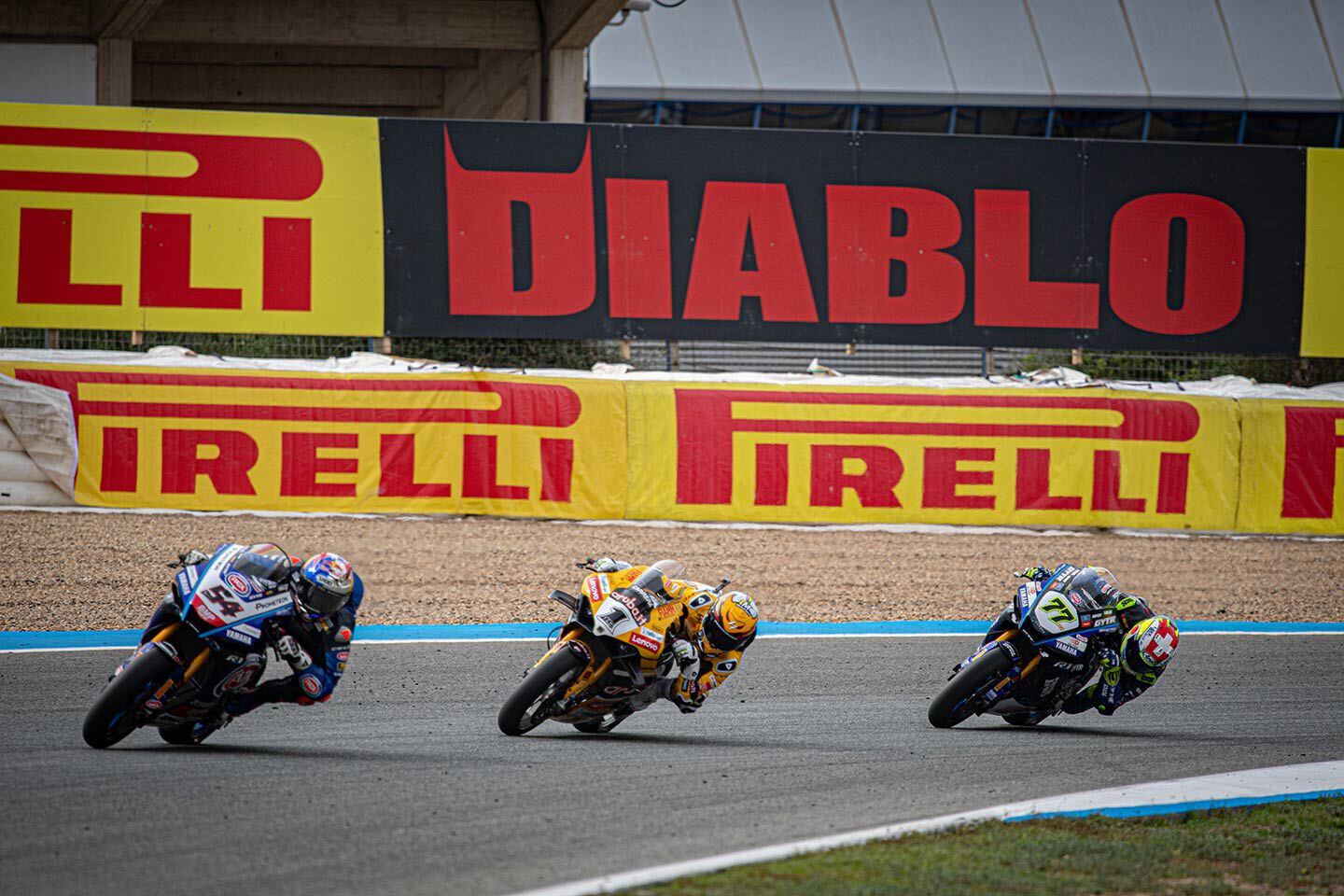
Positive season for Pirelli in WorldSBK (Pirelli/)Pirelli Press Release:
The Spanish Round, the final event of the 2023 FIM World Superbike Championship, ended with the victories of newly crowned Ducati world champion riders Álvaro Bautista in Superbike and Nicolò Bulega in Supersport. Both the Spaniard and the Italian won all the races of the weekend and also took the Pirelli Best Lap Award for doing 19 and 11 race fast laps respectively during the course of the year. Taking home the title in WorldSSP300, on the other hand, was Fenton Seabright (Kawasaki GP Project) with 4 race fast laps. As for the tyres used in this round, at the front, the SC1 was chosen by all the riders, both in Superbike and in Supersport, whereas at the rear, all the soft solutions in SCX or SCQ blend ensured outstanding performance even with relatively low temperatures and optimum consistency from start to finish, as demonstrated by the duel fought down to the final turns between Bautista and Razgatlioğlu in Race 2.
Giorgio Barbier - Motorcycle Racing Director
A positive season for Pirelli under the sign of development “The results of this season for Pirelli are undoubtedly positive and we have successfully advanced the development schedule that we had set for ourselves at the beginning of the year. In Superbike, the main goal was to improve the mileage of the rear extra soft SCQ not only in qualifying, but also in the Superpole Race - a result that we achieved with the C0004 specification which will become the standard compound in 2023, replacing the current SCQ. The other rear development solution that will join the standard range is the medium A1126 which will become the new SC1. As for the front, this year we began working on a soft SC0 option and this development will continue into next season. In Supersport, focus was on the SC1 front and, here once again, we were able to improve performance with the B1333 specification which will join the standard range as the new SC1 front. It is clear, therefore, that the World Superbike Championship is still the best development platform for us for our racing tyres because we have most of the motorcycle manufacturers here, which means that we are able to test our products until the work well with multiple bikes. It is an ideal condition, considering the fact that these same tyres are sold regularly on the market, so the must ensure versatility and be able to adapt to any bike. Now we’ll remain in Jerez for two days of testing aimed at preparing for next season.”
SBK Superbike Superpole Race 2
The Superpole Race was red-flagged on the second lap and then restarted for a distance of eight laps. At the front, all the riders used the standard SC1, whereas at the rear, the most popular solution was the SCQ C0004 development tyre. Only Jonathan Rea (Kawasaki) decided to start on the SCX B0800 development solution, whereas Rabat (Kawasaki), Ruiu (BMW), Syahrin (Honda), and Konig (Kawasaki) opted for the standard SCX. At the restart, Alex Lowes also switched to the SCX B0800 rear, whereas Aegerter (Yamaha), Rinaldi (Ducati), and Lecuona (Honda) switched from the SCQ to the standard SCX. Starting from pole position, Álvaro Bautista (Aruba.it Racing – Ducati) won this race as well, finishing ahead of Dominique Aegerter (GYTR GRT Yamaha WorldSBK Team) and Jonathan Rea (Kawasaki Racing Team WorldSBK).
In Race 2, the riders substantially confirmed the tyre choices they had made yesterday in Race 1: SC1 front and standard or development (B0800) SCX at the rear. The final race of the year had Bautista and Toprak Razgatlioğlu (Pata Yamaha Prometeon WorldSBK) engaged in a thrilling duel. Overtaking manoeuvres down to the last lap and Razgatlioğlu finishing first, only to be penalised for having exceeded track limits coming out of the final turn. Victory went to Bautista, with Razgatlioğlu relegated to second place and the other Yamaha rider, Dominique Aegerter taking third. The Turkish rider celebrated this 100th podium with Yamaha before going over to BMW in 2024, whereas Aruba.it Racing – Ducati wins the team World Title.
SBK Supersport Race 2
For Race 2, the riders confirmed the tyres chosen in Race 1 at the rear, so practically everyone was on the grid with the standard SCX except Kawasaki riders Adrian Huertas and Can Oncu who started with the standard SC0. At the front, some riders who had been on the standard SC1 for Race 1 switched to the SC1 B1333 development tyre, which remained the most used solution. After the race was red-flagged, there were a few changes: Adrian Huertas and Can Oncu switched to the SCX rear, with Filippo Fuligni (Yamaha) using the SC0.
Winning the race and improving on the record set yesterday for the most race wins in a season, was Nicolò Bulega (Aruba.it Racing WorldSSP Team) who, like in Race 1, finished ahead of Stefano Manzi (Ten Kate Racing Yamaha). Third place went to Turkish rider Can Oncu (Kawasaki Puccetti Racing).

2024 Moto Guzzi Stelvio Showcases Piaggio's New Radar Rider Aids Suite
in Motorbike news
Posted

After granting a pre-EICMA sneak peek, Guzzi gives us the goods.View the full article